Don't wanna be here? Send us removal request.
Text
Summer Project: Plastic Oceans
Brief:
For this summer project we will be exploring the issue of plastic littering coastlines and beaches, polluting the oceans and harming the wildlife living there.
Initial Research:

https://www.youtube.com/watch?v=4wH878t78bw (WARNING: Video is Distressing)
Upon hearing about this project my first thoughts went to the Youtube video of the turtle that had a plastic straw lodged painfully up its nose. The video left a pronoun effect on me as you could see just how in pain the turtle was in and also because the turtle could only have been helped by humans just like how it was also harmed by humans.
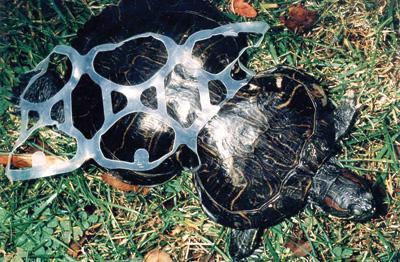
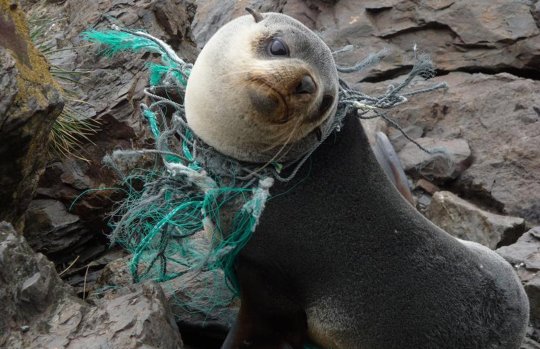
However, I almost ignored the video as well, because the video had been filmed in a different country and I was foolish to think that because of that, littering on the coastline wasn’t a major issue in the UK. When I visit the beach the first thing I notice is never the amount of rubbish, in fact its barely noticeable, and I too have one or twice left tiny pieces of plastic because how could a tiny piece of litter effect such a big ocean? It’s because of this thinking that leads to the mistake of littering because I’m not the only person.
Case Study: Brighton
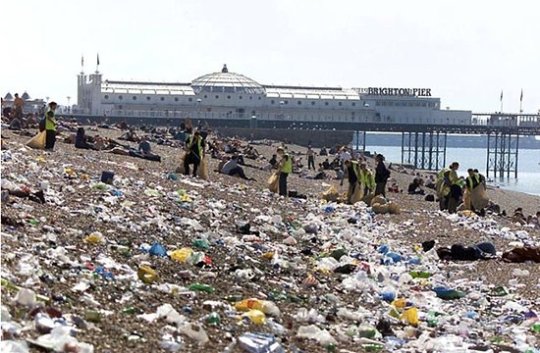
Every summer people travel to the coast to enjoy the sun and Brighton is a very popular destination. During this years Pride festival an estimation of 300,000 people attended and turned Brighton’s beach into a dumping ground. This apparently occurs every year at Brighton’s pride festival.
Case Study: Scotland
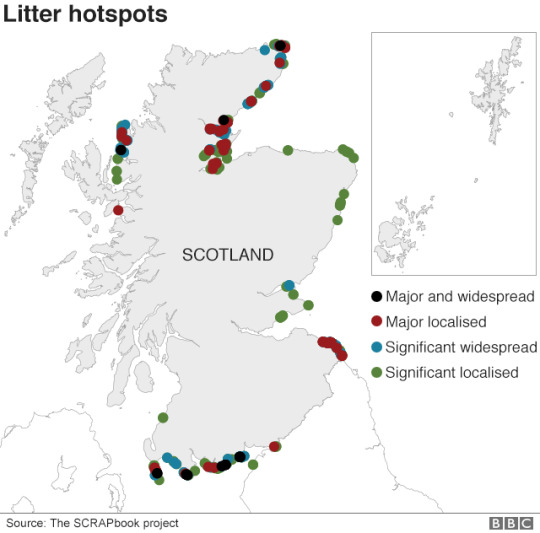
In Scotland charities- The Marine Conservation Society (MCS), The UK Civil Air Patrol and the Moray Firth Partnership- have been flying over remote beaches to take aerial photos of the beaches to document the amount of litter among the coastlines and produce a map showing the worst places that need the most help.

Balloons have also been affecting the coast, but not just in the UK. Washed up balloons have been found to be decorated in logos from Spain, Dublin, Belgium and many more. This has happened because balloons are released perhaps by accident or for aesthetic causing them to float around in the sky till they eventually deflate back to the ground to become litter. No one could have quite expected for balloons to travel so far and to end up on a coastline in a different country.
Why’s littering such a big problem?
For starters littering is unheigienic as it carries germs and can also be dangerous for people around it especially if it’s in a family friendly place such as a beach. Its also dirty and can ruin a places reputation as no one wants to spend their day around litter so this can affect the economy of an area as this could cause a decline in tourists.

But the most important reason in my opinion is that it can kill animals and wildlife. Plastic isn’t like food, it takes longer to decompose and in that time an animal can mistake it for food and eat it. In the case of balloons, they can block digestive tracts and slowly starve the animal to death. Animals can also get injured or tangled in plastic, like turtles which have often been found washed up on the coast, dead, having been caught in a disposed plastic net.
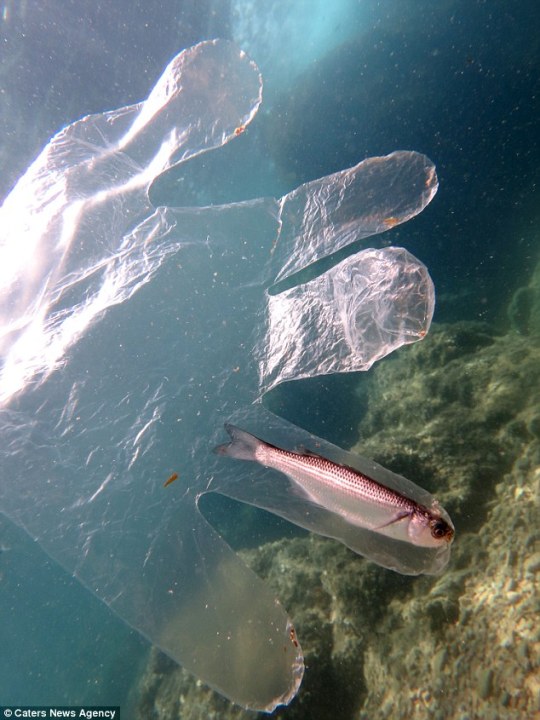
Scuba instructor Roger Millan took a photo while diving off Tossa de Mar on Spain’s Costa Brava last month of a suffocated fish stuck in a rubber glove and ironically called it “Fish Finger” after the classic favourite food. There have also been numerous incidents of fishermen opening up fish to find pieces of plastic in their stomachs and photos of aqua life living side by side with human waste and litter.
My Response:
After researching this project I have found that I actually feel quite strongly about this subject and it has given me ideas about how I could promote this through illustration. Before I begin however, I need to visit my local beach to analyse how plastic has affected it.
Tasks:
1. Collect research in the forms of articles and documents about plastic waste and how it affects our sea wildlife.
2. Photograph and collect litter on the coast, perhaps compare my coastline to someone else to see the differences between them.
3. Demonstrate a variety of drawing methods/ ideas in my sketchbook.
4. Create 3 sculpture ideas in response to this project
0 notes
Text
Final Evaluation:
Evaluation
Kate Webb 8973830987
Ex. Diploma Graphic Art
FMP “Under the Influence”
For this project I chose to explore the influence of the supernatural on society as it has always been a personal subject of interest due to its questionable yet influential existence. Exploring themes of ghosts and witches, I experimented with a variety of different processes to develop outcomes and to step outside my comfort zone of working by using methods I had neglected in the past, like animation and 3D model making.
As a designer and artist, I asked questions concerning my audience and their needs as this had an effect on my designs and outcomes as it had to appeal to them. Though choosing a narrow audience proved difficult till I concluded that the themes I was approaching, horror and the supernatural, were more of interest to a mature audience with a love for films of those genres.
Culturally, I chose to work with aspects of historical Japan, including their mythology, superstition and traditions to represent my setting of the Aokigahara forest (the suicide forest), which I used in a respectful and adaptable manner to allow me to manipulate them for my own interpretation/ designs. European and Western views and events, such as the Salem Witch Trials in the 16th century, on witchcraft also informed my decisions on designs as I wanted to convey the fear through my work to reflect historical opinions.
Problems posed by a self-initiated project were independent planning issues which, although became polished towards the end of the project, created limitations with time that I could have used to produce practical outcomes.
Using a variety of sources, via internet, articles, books and documentaries found on Youtube, to extend my research allowed me to come across artists and themes I hadn’t initially thought to explore. Witchcraft was the stimuli of inspiration leading me to investigate the relationship between fairytale witches and forests, their interpreted home and setting for my final piece.
After discovering the link between dolls and witchcraft I was inspired to create a 3D articulated doll for stop motion purposes, reflecting the work of doll artists Marina Bychkova and Popovy sisters.
Contextual subjects relating to my topic are presented in blogposts and developed with related artist research enabling me to compare techniques and processes that may inform outcomes I planned to produce and whether I could apply it to my audience needs discovered through peer assessments and questionnaires. By developing original ideas in response to contextual research, my work and style became independent and a clear interpretation of how I explored the research as an artist and designer. I then compared my outcomes to artists who’d used similar themes and processes to answer questions on effectiveness. Critically comparing my own work to other artists allowed me to analyse how they approached a theme and whether this had an effect on the atmosphere of the piece and the audience it was created for, which helped me plan my next actions to further develop my work.
To leave my comfort zone of working I advanced on experimenting with different materials and to learn new processes to vary my outcomes. I progressed with the use and development of observational drawings and concept designs by adapting them into animations, a method I had little experience in. Chemical mediums were also a new process to work with, particularly Cyanotype, a UV printing chemical. Originally, there was no intention to use chemical processes, but after some experimenting I chose to adapt it for textile purposes in my final piece. It also allowed me to involve nature to support my theme and research of “Hylophobia”, the fear of wooded areas and forests, to represent the Aokigahara forest and to use as a setting for my witch/spirit like in fairytales. A specialism I wanted to attempt this project was the use of 3D models, which tied in with the connection of dolls and the supernatural and inspired the idea of working in 3D stop motion.
Approaching my practical time cautiously, due to the lack of confidence and knowledge I had for the processes I intended to use, effected how long I had to create outcomes. By being brave and having more confidence in my skills, I could have experimented with a variety of outcomes to ensure the best possible piece, for example; my models head was too round and large in comparison to how I had originally designed her and by replacing it with a smaller head the overall appearance would have been improved. I do feel satisfied with what I have created overall for this project as I now have a basic understanding of a variety of methods that best represents my themes. I have refined my basic animation and editing skills by approaching my tutor and asking for lessons on how to use software like Premiere Pro and used them to create my final exhibition animation.
The genre I wanted my animation to communicate was horror which I mixed with the Japanese cultural aspects that influenced my designs. Horror is often best represented in 4D work, which I researched by studying clips from horror films such as “The Shining” and “It Follows”. The stop motions featuring surreal and elegant clay women by Allison Schulnik influenced me to use this 4D process due to the creepy atmosphere it can often create which is what I wanted to capture for my piece.
Although I struggled with an efficient plan I managed to keep on schedule, producing aspired outcomes each week and meeting deadlines punctually, with the exception of editing my animation as I decided to add text last minute. Considering my original animation skills, I have improved to a standard where I can direct, edit and shoot with independence.
Requesting feedback from my enthusiastic peers, through questionnaires and interviews, and my tutor, through tutorials, offered a different direction of viewing my themes that I could apply to my audiences needs to improve my approach.
To improve, I would ensure that practically my work quantity is equal to my research quantity as even though I responded to the research I didn’t always develop it to explore different outcomes. Improvements can also be made on how effectively I plan my actions practically which I could do by developing work further through practical experiment.
Overall these two years has been productive in teaching me the importance of specifying my audience and have given me the opportunity to experiment and broadened my skills with new processes and methods I can apply to future projects.
0 notes
Text
(Extra Research to Inform my Designs) Comparison of Witches
For this post I will be comparing the properties of witches from around the world to local activity in my area.
Witches in Japan:
Japanese witches aren’t like witches from European folklore, they don’t make pacts with the devil nor do they have magical powers. The only catorgarised “witches” from Japan are those who have familiars with animal spirits like the “kitsune” (a for spirit) or a snake. These familiars are employed by the “witches” to act out deeds such as spying or playing tricks on the witches enemies.
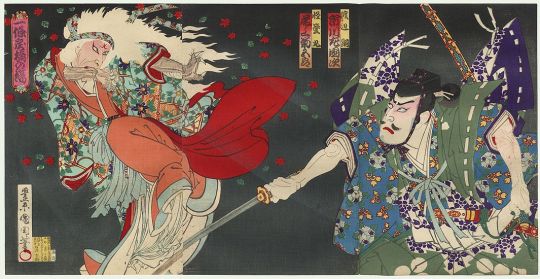
Above is an illustration of the story about a samurai who cuts off a demons arm and the demon returns disguised as the samurai’s elderly aunt to retrieve it.
In Lara Croft: Tomb Raider (2013), The main antagonist is “witch”/shaman/ queen, Himiko. In the game, Himiko is an evil sorceress whose able to bring back the dead as her zombie slaves. However in actual history, Himiko was a real person.
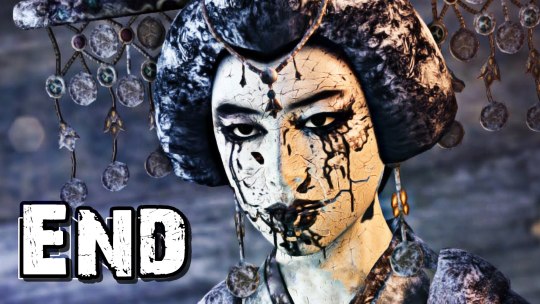
She was the first female Priestess and shaman to rule over 3rd century Japan, and was known to be able to communicate with the spirit world which allowed her to openly speak with political parties and rule over them. However, after her death all accounts of her existence were removed till the Edo Period (1600), why this happened is still a mystery, especially since she was one of many shaman queens to rule over Japan. Because Shamans were thought to be priests from the Shinto religion, there is no Japanese form of witch, not one in similarity to European witches.
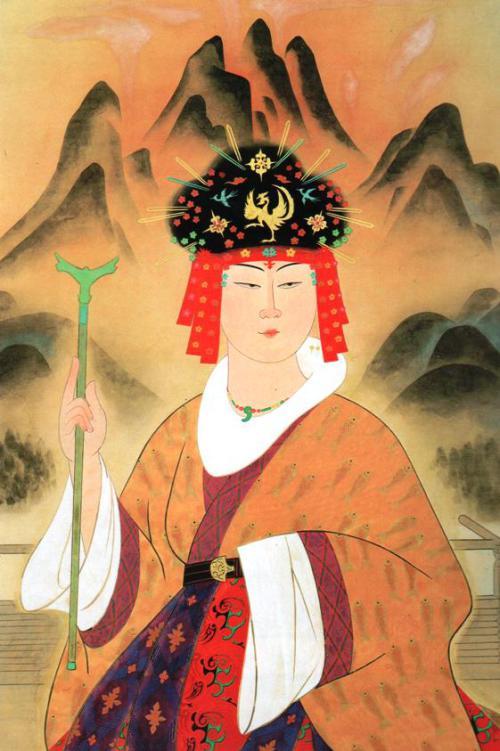
Above is a portrait of an interpretation of Himiko
Demons are more associated with Japanese superstition, particularly female demons like Hannya’s/ Namanari/ Chunari/ Honnari (women turned into demons through jealousy and greed) which were the inspiration for my designs.
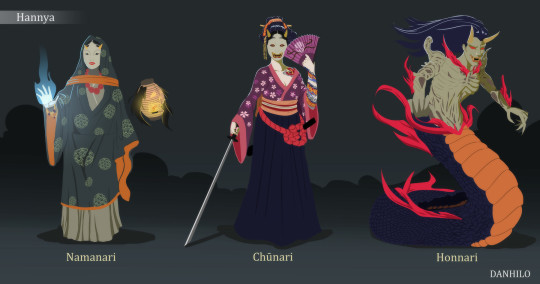
However, on the island Okinawa outside of Japan, there was a similar occurrence to the Salem witch trials that happened prior to the 18th century, when Okinawa was known as Ryukyu Islands.
Separate from Japan, Ryukyu had its own beliefs and religion and although priestesses were common in Asia, the noro were the official priestesses of Ryukyu and while the king of Ryukyu and his ministers formed the hierarchy of government, the head priestess and other noro formed the religious hierarchy.
Noro positions were inherited maternally where as Yutas, spiritual mediums of low status, awakened their spiritual abilities and compared to the noro, their lives were harder as they were often accessed of summoning demons and cursing villagers leading them to be executed and targeted for persecution by the government. Although yutas and noros don’t fit into the same class as a Western witch, it is still interesting to see that women who were fee to do spiritual practices were treated poorly by society.
Local Witchcraft in Essex Colchester:
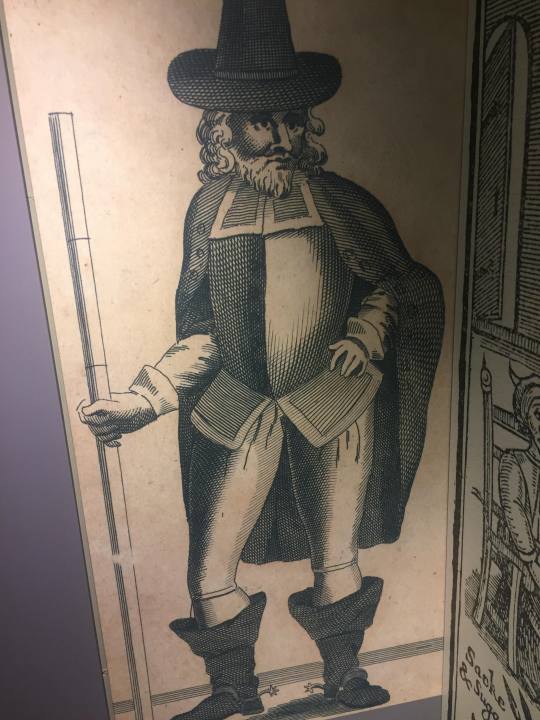
Essex has the highest execution rate of witches during the 17th century than any other county in the UK. After the civil war when superstition was intense, Mathew Hopkins appointed himself as a “witch finder general” where he accessed and interrogated over 200 women who he kept prisoner in Colchester Castle, though he was never employed by Parliament.

Originally the area of a Roman Temple that was destroyed by Queen Boudica in AD 60, William the Conqueror chose the sight to build the castle above.
Although there is speculation that the entire castle is haunted, I was only interest in the prisons where Mathew Hopkins, the witch finder general, held and interrogated over 200 women accused of being a witch.

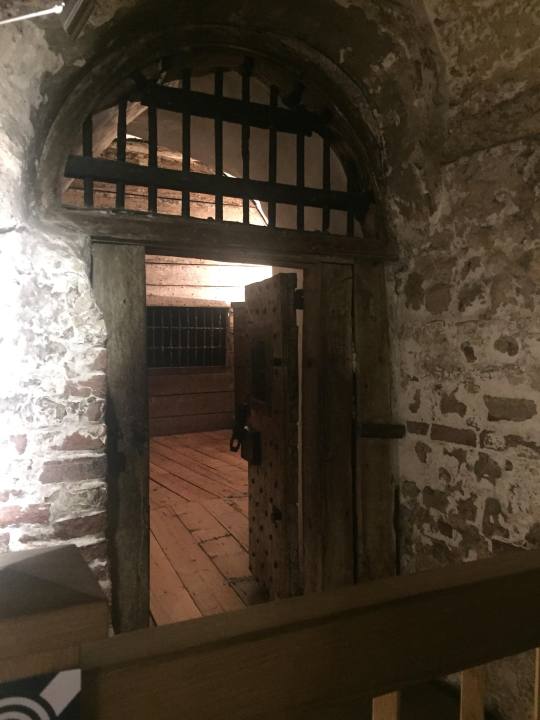

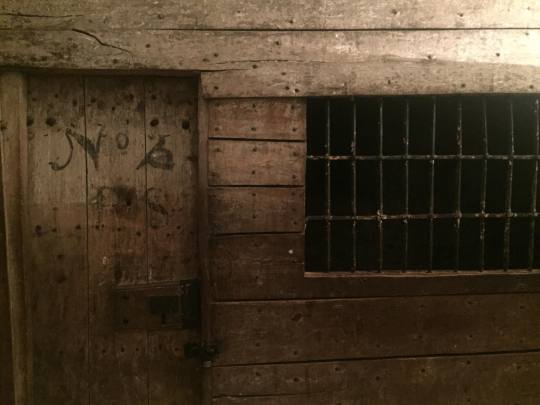
Although I don’t class myself as a superstitious person, I had difficulty gaining the courage to go into the prison, whether it was a spiritual influence or my own mind trying to scare me is something I can’t explain. The atmosphere of the cells were generally scary and its difficult to explain whether there was a darkness looming in those cells or a constant reminder that this was the place where 200 women were falsely accused and wrongly treated. Overall I couldn’t bring myself to stay longer than 30 seconds in there at a time and after discussing these events with other visitors to the prisons they too felt they couldn’t stay in there for long periods of time.
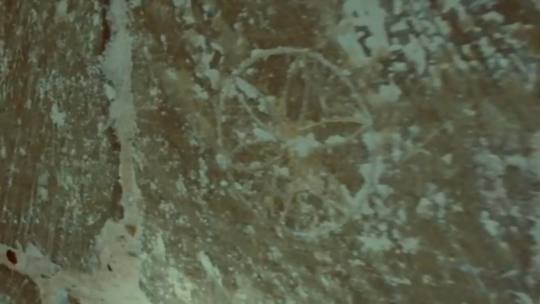

Above are images of symbols I found carved into the walls of the castle, The first one I assumed was a “Pentacle” a symbol often used in witchcraft but upon closer inspection I can confirm it is actually the “flower of life” a symbol used in alchemy.
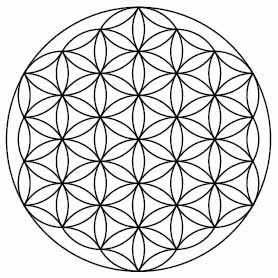
It is a geometric pattern composed of evenly spaced over lapping circles to form a six petaled flower and hexagon.
How is Colchester remembering the lives lost in the witch trials?
Like for the Salem Witch trials in the USA, Colchester is planning a memorial to honour those who were trialled for witchcraft in the form of artwork to soon be exhibited in Firstisite. The piece, encompassing moving image, sound and sculpture, will be created by installation artist Susan Pui San Lok who states the project will "explore the continuum between the folkloric and historic, and how narratives of the magical, mystical and murderous converge – andwhere wonder and fantasy turn to fear and violence."
Sources:
Websites
Tofugu, QUEEN HIMIKO: BADASS WOMEN IN JAPANESE HISTORY, https://www.tofugu.com/japan/queen-himiko/ accessed on 14.6.18
Tofugu, THE YUTA, THE NORO, and THE “OKINAWAN WITCH TRIALS” https://www.tofugu.com/japan/yuta-noro-okinawa-witch-trials/ accessed on 14.6.18
Broadly, The Cunning Female Demons and Ghosts of Ancient Japan, https://broadly.vice.com/en_us/article/qkgq57/the-cunning-female-demons-and-ghosts-of-ancient-japan accessed on 14.6.18
Beyond The Stars Astrology and Tarot, BIG IN JAPAN: GHOSTS AND WITCHES AND FOXES, OH MY!, http://beyondthestarsastrology.com/2010/11/30/big-in-japan-ghosts-and-witches-and-foxes-oh-my/ accessed on 14.6.18
0 notes
Text
Experimenting with Clay
Developing on from my animation, I decided to experiment with the use of clay to create stop motion animations like from the work of Schulnik. Plasticine has been a material used in stop motion as it’s a stiff and none drying clay making it reusable and easy to articulate.
Aardman Studios
Starting in 1972, by animators Peter Lord and David Sproxton the studio began creating animations with plasticine like the children programme Morph, the music video for Peter Gabriel’s “Sledgehammer” and Oscar winning production Wallace and Gromit “The Wrong Trousers”.

They use stop motion in a comedic way and plasticine seems to lend itself to the quirkiness of their animations due to it looking similar to play dough. In comparison to Schulnik’s animations which are dark and mysterious, Aardman manages to keep their animations bright and family friendly. This could be due to Aardman studios creating their animations in the 70′s and 80′s when animations were still considered as processes appealing to children, and Schulnik has adapted it to be more intriguing to a more mature audience. This suggests the differences in time and how plasticine has been developed into a more mature material to use in stop motion. It could also suggest the types of audiences these two animators are creating for and how they've manipulated the clay, setting and production to appeal to them.
My Clay Animations:
As this was only an experiment I chose not to take too long with these animations so created a basic model influenced by the designs of Schulnik and manipulated her to create flowing dance-like movements.
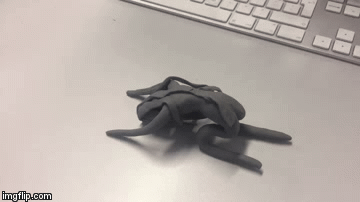
I started off with small minor movements as I found that although a more manipulative model, I found the material weak and unable to hold itself up for very long. This effected the movements I wanted to create as it meant I had to keep them minimal due to the weakness in her form.
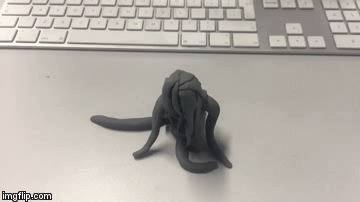

As I became more confident with the material I began to create more dramatic movements, though I was still unable to make her stand due to the weak material. On my last animation I decided to destroy my model with made her look as though she was melting, something I couldn’t achieve with my ghost model due to her being made from a hard clay.
Reflection:
Although I did create more fluent and graceful movements with the plasticine, I was more limited in the movements I could create due to how little strength the material had to enable it to stand on its own. Because of this I made the correct decision to use a more solid material as I didn’t risk breaking or bending her form out of shape, like I did with the plasticine, and I wouldn’t have been able to create her complex appearance with the plasticine like making her stand still without the risk of her drooping.
Actions:
1. Final Evaluation
2. Finish any unfinished work
Sources
Websites
Aardman, History| The Studio,https://www.aardman.com/the-studio/history/ accessed on 12.6.18
0 notes
Text
Mid Project Review
For this project, I have been exploring the influence of the supernatural and paranormal on society and researching the subjects of witchcraft and spirits. Deciding to use methods outside of my comfort zone, I have decided to explore animation and 3D model making for my final outcome.
Over this year, I have found the most useful method to record my progress through projects is to make blog posts rather than using my sketchbook as it allows me to expand my research easily and clearly, and has improved my IT, presentation and communication skills by arranging my compositions and adding recordings of my processes for clarity and interest directed towards the viewer. My posts are also presented professionally with clear copies of my work and working links, as well as original text explaining the steps I took as a designer and the research that influenced these choices.
Blogs are also a way for me to look at my peers work and make comparisons to mine to see how I could have approached a subject differently or if they have used a process that might benefit my own. These comparisons have helped me step outside my comfort zone and look into using processes that I had neglected in the past, like the use of print or animation. Already in this project I had approached different methods/ materials and it has benefitted my project by showing that as a designer I am willing to experiment with multiple processes to broaden my work and create a variety of different outcomes. After completing a new piece of work I made sure to write myself actions to help me stick to a plan and time scale which has increased my skill to work at an industry standard and fixed time plan.
Most of my research has been contextual rather than taking influence by other artists as I wanted to increase my creativity and organically conjure up my own ideas. For example I used cultural aspects from Japan, like geishas and kabuki to impact my model designs. This has had it’s benefits as I now feel I can independently respond to context and use it to create my own designs. However, I have found influence in many artists this project and have taken aspects from each of their work to inform my decisions. Looking at doll artists like the Popovy Sisters and Marina Bychkova inspired me to explore 3D model making and stop motion which is now what I hope to achieve for my final piece.
I wish to explore stop motion as I have always been influenced by the work of Harryhausen and Tim Burton but have lacked the skill and confidence in the past to really explore it in depth. However, as I wanted to step outside my comfort zone for this project, I will take the basic skills I have to create an outcome using stop motion animation and develop these skills via editing, directing and polishing my method for animating. To do this I will have to ensure that I create an effective planner to schedule my actions so that my final piece is ready for the deadline but to also motivate me to not neglect and keep up to date with blog posts, sketchbook work and any necessary research.
Although I have been predicted to achieve a merit for this project, I have been working towards a distinction standard which means that everything I need to ensure that my research and practical outcomes are not only polished, but consistent and visually show my thought process through this term.
The potential factors that may impair my final grade will be my planning which I have improved for this project as I now write a goal after every completed outcome that allows me to develop my work further and expand upon my research, another factor that I have struggled with in the past that I have hopefully improved upon. One thing that does have a negative effect soon my work is my confidence, I often doubt that my outcomes are up to a good standard which leaves me to over think and complicate my project which ends up steering me away from creating more practical outcomes using methods I haven't used before.
0 notes
Text
Animation Process:
For my animation I was reminded that subtly can be far scarier than over the top gory scenes or jump scares so I decided to research potential sequences or short films that also explore this idea of horror.
It Follows:
The 2014 movie “It Follows” by David Robert Mitchell, follows the tale of a girl who picks up a sexually transmitted curse that causes a shapeshifting monster to follow its victim slowly, mercilessly with complete determination.
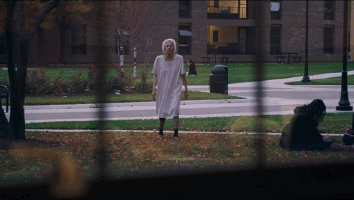
The reason I wanted to include this movie in my inspirations was because of how terrifying it is to watch. The monster is moving at a slow walking pace and in a fixed straight line to it’s victim. The emotionless being only has one goal in life and that is to stalk and kill it’s prey. Mitchell doesn’t use jump scares or scary costumes to create a terrifying monster, but composition, expression and movement. Click on the link below to watch clip:
https://www.youtube.com/watch?v=BRGZbILssWo
In the linked scene, our victim is sat calmly in class when she gazes out the window and sees a slow moving old women walking straight towards her from across the courtyard. Theres no sense of urgency for both parties, our main character assuming she's just being paranoid and having to check at least three times before she can definitely conclude that person is walking towards her, and the old woman who is seemingly in no rush to get to her is making slow, yet quick, progress to her target. Its minimalistic, yet effective and creates a tension and atmosphere that reminds the audience that although it may feel like there is no rush, there is still a limited amount of time.
“Mound” and “Eager” by Allison Schulnik

Click on links below to watch artists work:
https://www.youtube.com/watch?v=Heo7tyupmy0 (The part at 2:55 was the most inspirational part for my project)
https://www.youtube.com/watch?v=YbKasfNak4U&t=3s
Los Angel artist Allison Schulnik uses the art of clay in her stop motion to create surreal and experimental films that create dreamlike visions of sorrowful willowy characters that morph and change shape in time with the music.
I had originally intended to just create a film of my model standing still in her set, perhaps slowly appearing or moving out from a hiding place, but after watching Schulnik’s work I began to think about the possibility of having an element of dance in my animation. The way the characters move in Schulnik’s work reminded me of the scene from the VVitch where all the witches are seen chanting around a fire in a dramatic way and as Schulnik’s characters moved in almost a magical way, like they were casting spells, I felt inspired to explore this in my work.
The film Eager also uses dim lighting with drops of colours and hypnotic sound to create a magical/ surreal atmosphere, but for me the most memorable aspect of this film was the movement of the models and how graceful and elegant they looked, however there was still a sense of sadness to them that was explored through their actions and positions.
The Shining
There has always been one clip that has forever left a mark on me and that is the scene from Stanley Kubrick’s 1980, Steven King adapted film, The Shining where character Danny meets two twin sisters in the corridor. All they did was stand completely still and hold eye contact with the camera before cut scenes are shown of them dying horrifically.
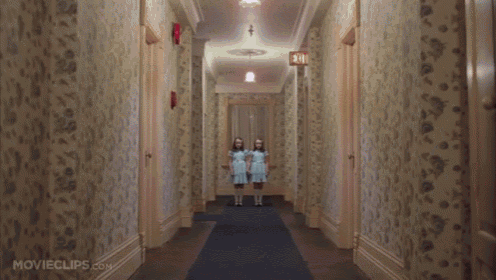
The overall effect of this scene is shocking at how minimalistic it is yet it still has an impact and was perhaps the most memorable scene from the film. The quick cut scenes show a glimpse of gore and when we cut back to the twins we find we have become closer to them when before we were a safe distance apart. By decreasing the distance apart from the threat so quickly the audience is suddenly put on a shocking realisation that they aren't safe and with the consent distortion of the cutting scenes it becomes difficult to understand how far away our character is from them and whether he is unintentionally getting closer to them.
WIFE PROJECTIONS:

Click on link below to watch Artists work:
https://www.youtube.com/watch?v=P01BXM2YdCc
WIFE is a group of three American, female performance artists that use the form of projection animation, dance and music to tell theatrical and magical stories. Like the work of Schilnik, the films use dance and movement to convey emotion and expression but it also creates an entrancing, hive-mind, performance that makes the viewer feel like they are watching some spiritual ritual due to how in sync the performers are to each other.
After watching this performance I began to want to experiment with projection as I thought it’d be an interesting process, however, having already decorated my model, I wouldn’t have any white areas to project onto and as I haven’t looked into projection, I wouldn’t have a basic idea of how to project scale wise. I concluded that perhaps projection could be explored in future projects but for now I could focus on the use of dark backgrounds with spotlights, manipulating sound to pin point key moments of the performance, and using dance and movement to convey emotion and atmosphere.
My Initial Plan for my Animation:

I want my animation to work in a similar fashion to the scene from the Shining, with my first shot being a wide shot of the full set as the camera slowly begins to creep forward towards my model. During this time as the camera beings to close in towards my model I will have quick cut scenes and subliminal messages of my model moving to create a contrast with the still shots. I will only have two active shots, which will be created via stop motion, as again, I want to be subtle and by keeping them short and minimal this will create a mystery for the viewer and also doesn’t over work the power of these scenes as too many would become boring over time.
I want the animation to flicker and glitch like theres some interference and I want the subliminal shot to be of her in her demon mask so that its not obvious to some viewers but it is to others. As for the sound, I want it to be slow and creepy to create atmosphere but during the scenes where she is moving I want the sound to resemble glitches and white noise like when a TV looses signal as this will create an intense contrast to the traditional music playing in the still scenes.
Shooting:
Lighting
Deciding to shoot the stop motion scenes first, due to them having a black background, I began to set up my set by first deciding on lighting.
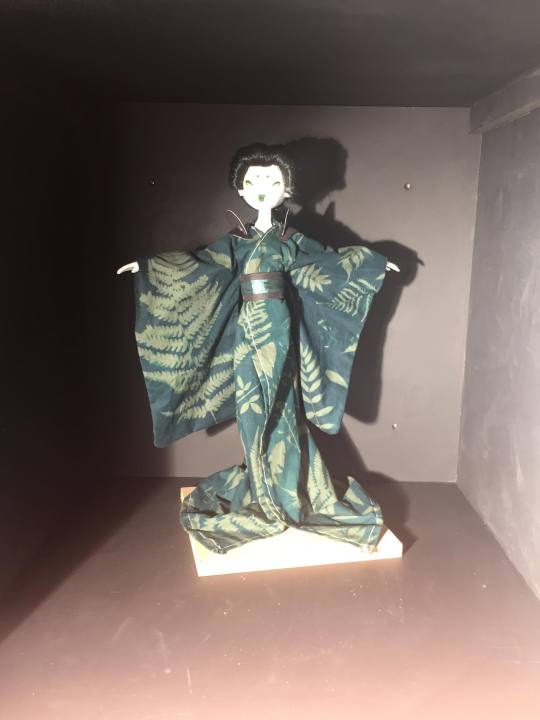
Using the first stage light, you can see that its way too bright as it causes my black box to look brown and the white skin reflects the light. As I want my lighting to be more dark and atmospheric, I traded the larger stage lights for smaller lamps that I placed a sheet of green plastic over to create a green light making the set look more eerie and forest-like.

Although her skin still reflects some of the light, it creates a more eerie glow adding to the concept of her being a spirit.
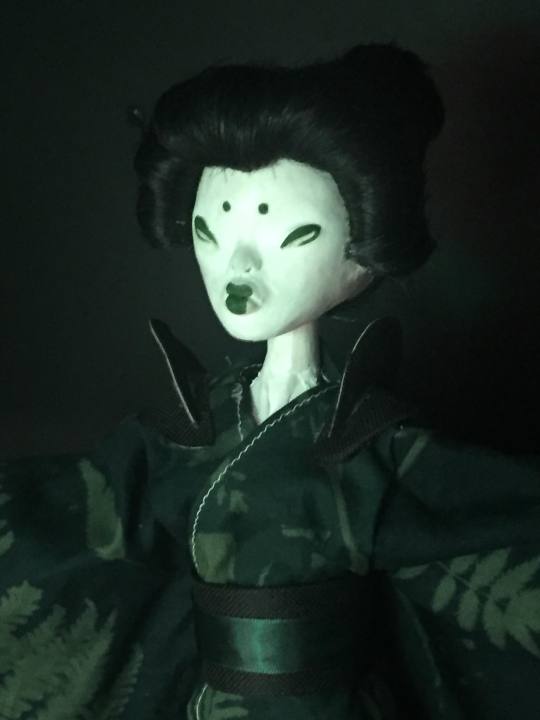
Although the green light created the atmosphere I wanted, I still felt the set needed to be more dramatic so I went out and bought two LED lights to create a glow coming from behind her, like in the diorama’s created by artists Deepti Nair and Harikrishnan Panicker.

I found that these lights were too bright when shooting my moving scenes so only used them when I was shooting my closeup as they weren’t so obvious behind the props yet still created an interesting and spooky silhouette.
Recording
https://youtu.be/WlWWPB1MY3g
Above is the recorded process of my stop motion process, as you can see I struggled with her articulation as she has very loose joints and she wouldn’t hold her position for very long so that is something that must be considered when I decide to create stop motion models in the future.
I made sure to record the stop motion as well on the stop motion app iMotion so that I could see if the photo’s I was taking via the camera flowed nicely.


The filter on the light shifts due to it not being attached tightly which may effect the quality of my photos and create unwanted shadows. However, my model flows nicely and although shifts in some areas, theres no glitching or jumping of actions.
https://youtu.be/WARdYnGF9qw
I then recorded my closeup using the Dolly slider which allowed me to create a smooth camera movement towards my scene, I took many takes of this shoot to ensure I had the best possible recorded shot. Overall the equipment was easy to use but I did struggle when it came to stability as the room I was shooting in shook overtime someone stood or walked so there is shaking in the shot which was unavoidable to record in that environment.
The shooting process took shorter than I expected which allowed me to record multiple takes so that I could choose the best scenes to use in my final piece.
Editing Process
For the editing of my film I used Premiere Pro CC which I hadn’t used before so this was an interesting new skill I learnt. I learnt the basic skills of importing, slicing and placing the sequence together which allowed me to take control of my project and create my animation to my standard. I was shown how to make my animation appear to glitch by adding in blocks of coloured shots in between the sequence to make it appear to flicker, and I also placed my mask shot in more times than intended just to get the image across to my audience. Click link below to view editing process:
https://youtu.be/TqIEVqtwDFw
At first I struggled with the software as I had never used it before but I eventually gained enough confidence to use it to the point where I was happy to add sound and even text on my own without supervision. I still struggle with the manipulation of the film and often I’d ask for help but I am proud of the effort I made to learn how to use Premiere Pro and would like to expand on these basic skills to produce more detailed animations in the future.
Adding Text:

At first, I had no intention of adding text into my animation as I have no confidence with my typography skills. However, my tutor showed me the music video “F For You” by Disclosure which features animated text that flickers and glitches. To create this form of text I would have to write out my text a minimum of four times ensuring that they are all the same in scale but differs slightly to create the movement.
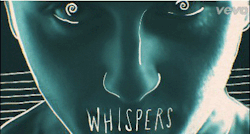
One of the reasons I was skeptical to add text was because I didn’t know what I wanted it to say as I didn’t want it to be too obvious. The only words I could come up with were “forest” or “spirit” and I felt they weren’t subtle enough to leave it to the viewers interpretation. With this in mind I decided to look into using the Kanji symbols for these words to use as my font as that way it culturally relates to my piece and will only be understandable to some viewers.
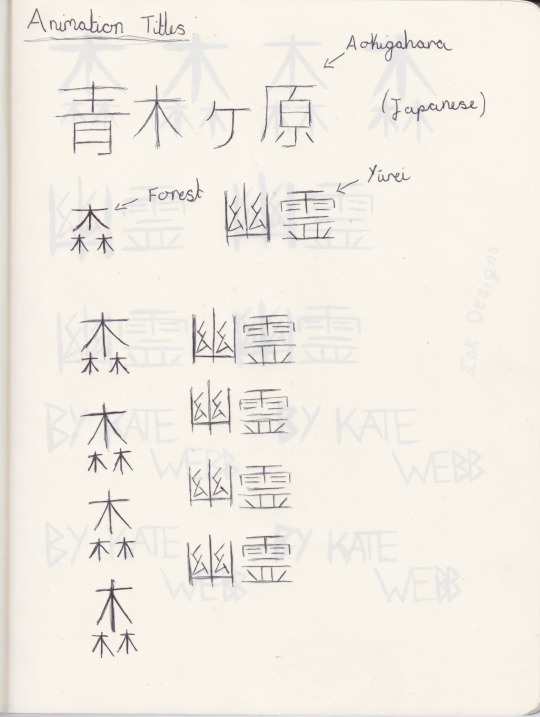
I decided to use the kanji symbol for forrest as it looks like the symbol for the Blair Witch, and the symbol for Yurei which basically means angry spirit or ghost. At first I wrote them in biro but remembering my work from the Post Up workshop, I decided to write in ink to create a more bold silhouette and to culturally resemble typography from Asia.
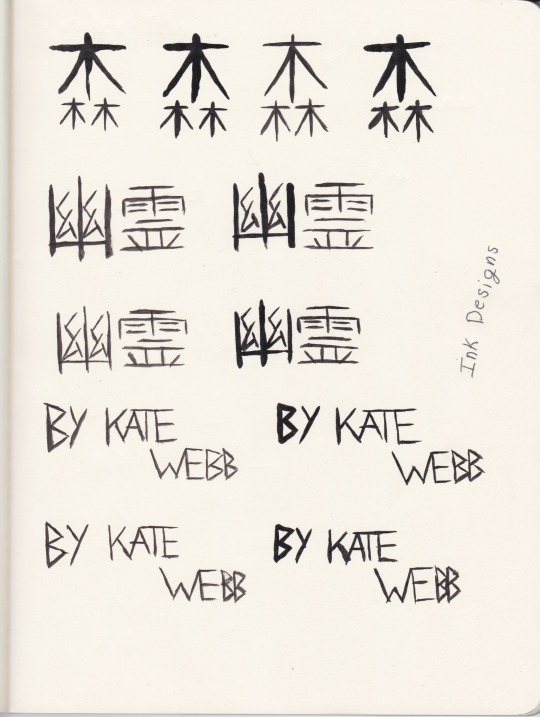
I also wrote my name with this material but sadly it doesn’t look as interesting as the kanji symbols mainly due to my hand writing which I tried to keep in tone with the symbols but they do come across as messy.
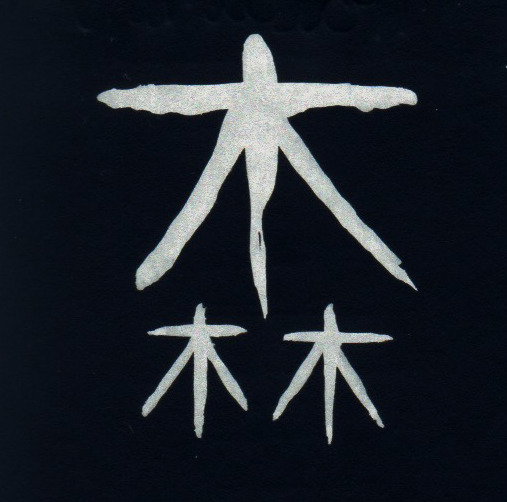
I inverted my text via Photoshop but in the end I actually screened the text over the actual animation as I felt this was more dynamic and contrasted well with the piece as if it was played before the animation began it looks like a separate piece.
Final Product:
Click on link to watch the final piece:
https://youtu.be/Bg0VDACPxrg
Overall I am very happy with my outcome as I feel it is subtle yet still creates a shocking atmosphere similar to the artists work listed above. This was done by the use of music and movement but also stage composition and lighting. The contrast with the still puppet with the moving subliminal messages surprises and causes tension which is what I wanted and resembles the scene from the Shining with elements of the performance by WIFE.
However, there is a lot I would have liked to improve on for this animation; for starters I wish I’d had a piece of music in mind before I actually began filming as this would have allowed the movement to be in sync with the music and would have perhaps effected the way I chose my model to move. I also wish I had learnt about WIFE before I had designed my model as I would have loved to have practiced in using projection as this might have allowed me to project leaves or other hand rendered animations onto her, like when I used 2D animation to create blinking eye’s on my observational trees.
The filming went to a good standard but was restrained by the articulation of my puppet which caused her to look very stiff in comparison to the work done by Schilnik who used clay to create her models which allowed them to flow more freely. I also began to notice how the shape and size of her hear made her look more cartoonish rather than elegant and surreal so again that is something that I should have altered in the designing and modelling stages of my production.
Reflection
As this is the piece I will be showing for my exhibition most of my practical work has been finished unless I decide to make any altercations from this time till the exhibition date, however I am satisfied with what I have created even though there is some things I would have done differently.
If I had planned to create my set piece whilst designing my model, I could have made them so they contrasted better with each other rather than the set having to be rushed through. I would have also liked to experiment with clay models like Schilnik, to see if I would have produced more fluent movements.
Actions:
1. Experiment with clay to compared it to the movements of my model
2. Perhaps explore projection with the clay animation?
3. Begin to think about how I could exhibit my work
4. Write evaluation on this terms project.
5. Finish any last minute work and blog posts and begin to present my work in my folder.
Sources:
Websites
Allison Schulnik, Index, http://www.allisonschulnik.com/# accessed on 7.6.18
WIFEWIFEWIFE, About WIFE, http://cargocollective.com/WIFEWIFEWIFE/ABOUT-WIFE accessed on 7.6.18
Videos
Alvaro Gomez (2016), It Follows- Old Maid Scene, https://www.youtube.com/watch?v=BRGZbILssWo accessed on 7.6.18
garaco p. Fleshy (2014), EAGER, https://www.youtube.com/watch?v=YbKasfNak4U&t=3s accessed on 7.6.18
WIFEPROJECTIONS (2012), WIFE “The Grey Ones”, https://www.youtube.com/watch?v=P01BXM2YdCc accessed on 7.6.18
0 notes
Text
Set Design
To produce my stop motion animation, I need to create a set that will match my models design.
First Initial Ideas:
At first I had wanted to just go outside and record in an actual forest, however, it was pointed out to me that I wouldn’t be able to control natural weather conditions that could cause shadows and movement in the recording process that I didn't want. After discussing with my tutor, he suggested I attempt to make a set in the form of a “diorama”.
What is a “Diorama”?
“-a model representing a scene with three-dimensional figures, either in miniature or as a large-scale museum exhibit.”

Diorama’s are a representative, set piece depicting a scene in 3D model form. Most basic diorama’s are made from shoe boxes with 3D models inside them and it was suggested that I create my set piece inside a cube to stimulate the idea of claustrophobia and hylophobia.
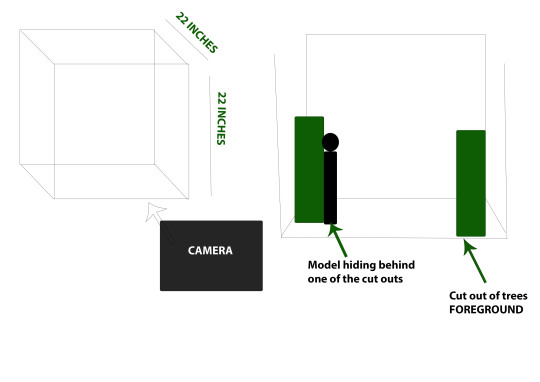
Above is a diagram of how I plan to composite my set. It will be 22 inches cubed to fit my model inside, and will have cut outs of trees for my model to stand behind as I don’t want her in the foreground but rather in the background so the viewer isn’t drawn to her instantly. The camera will be positioned in front of it and will hopefully seem like its surrounded by the set.
How will I decorate my set?
Looking at the sets used in Laika’s film, Kubo and the Two Strings, you can see that the set is completely 3D and the scale is very large in comparison to the models.
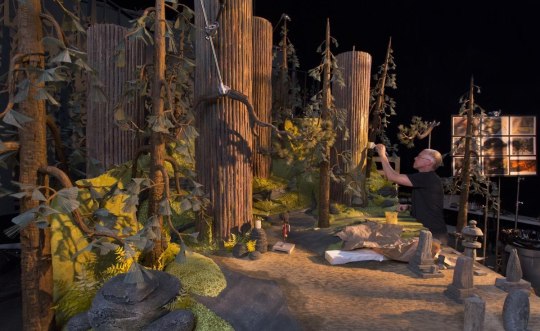
My model however is much larger than the ones from that movie and as my resources and time are limited, I had to reduce my set to just 22inches for her to be able to fit inside it. As much as I would love to create a large scaled piece, I have to remember that I have peers who also intend to create a stop motion production and it would be unfair for me to take up so much time and space. This is one of the reasons I had originally intended to shoot in an actual out door space but I know that wouldn’t be possible due to weather conditions.
I decided to look at paper sets, like the one below designed by Hari Panicker and Deepti Nair. Cutting silhouettes and using light to create definition allows the flat 2D shapes to become 3D.
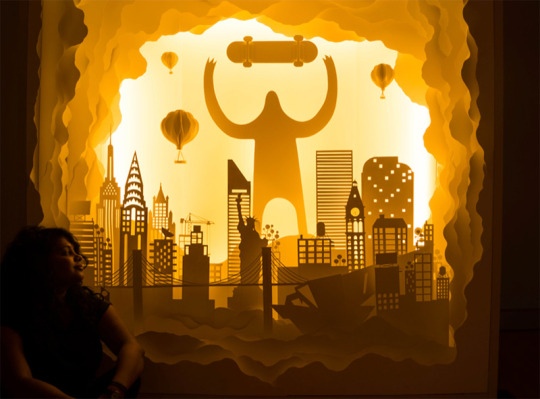
Although I find this design to be highly successful I feel my model wouldn’t match the simplicity of these silhouettes and other than working in cyanotype, I haven’t worked with silhouettes in this project. I would like to play with my lighting in a similar way to this piece by having more lighting in the background than the foreground which helps show the dimension of the set.
Coming to the conclusion that silhouettes might be too simple for my set, I began to look at forest sets used in theatre as they have a limited scale yet are still able to manipulate it to create the right atmosphere.
Below is one of my favourite set designs by Brett J. Banakis for the play As You Like It by William Shakespear. The set mixes 2D panels and 3D trees together to create a condensed scenery. Forests are tightly packed and can look disjointed due to the amount of different shapes and dimensions and this set plays with that concept by hanging panels of trees in front of 3D trees. It also occurred to me that birch trees create a more mysterious atmosphere due to their unusual colouring and shape and although the trees in Aokigahara aren’t birch, I feel these trees would suit my model better due to the contrast with her white skin tone.
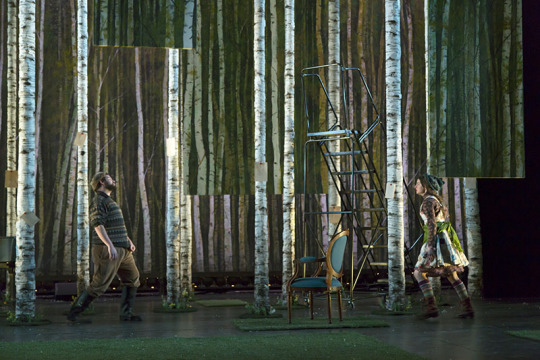
Taking inspiration from the set above, I decided to return back to my observational tree drawings and use them in my set.
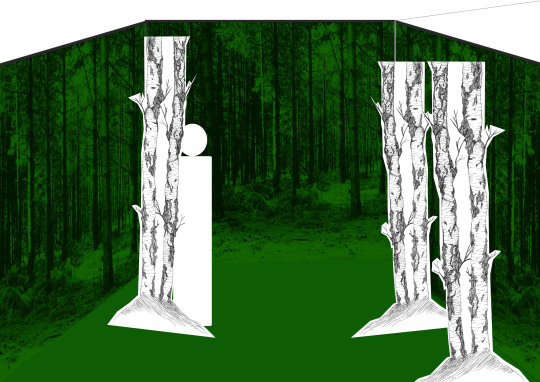
Above, would have been my set design, however, I realised I’d be unable to print the background over A3 and the trees would have to be larger than A3 due to the box being 22inches length and width. It was suggested to me that I print the pieces separately, but I felt this would effect the quality of my work.
I didn’t want to spend that much time on my set so I began to think of a much simpler design that would still translate the image of a condensed forrest.

I found this set piece on Pinterest and liked how similar it looked to the designs from Kubo and the Two Strings due to its simplicity. I was also entered in the use of shapes, especially in the background how they have literally just sliced rectangular shapes from panels to make them appear like the 3D trees in the foreground.

For my set design, I will be creating a set using components from the found set above. I will also be combining my observational drawings by sticking them onto my 3D trees to make them look like birch trees. I will still be hiding my model behind the 3D trees and will be using minimal light as possible or placing lights inside the set piece. The contrast with the mostly black and white set piece with the green of my model with make her noticeable by my audience and will add a threatening contrast to the scenery.
Making Process:
I was assisted with making my box from wood of 22inches length and width and was even able to create a detachable lid to allow me to move and shift lighting and props if needed. I then painted the inside black like my design but used matte stage paint to avoid a reflection from the paint.
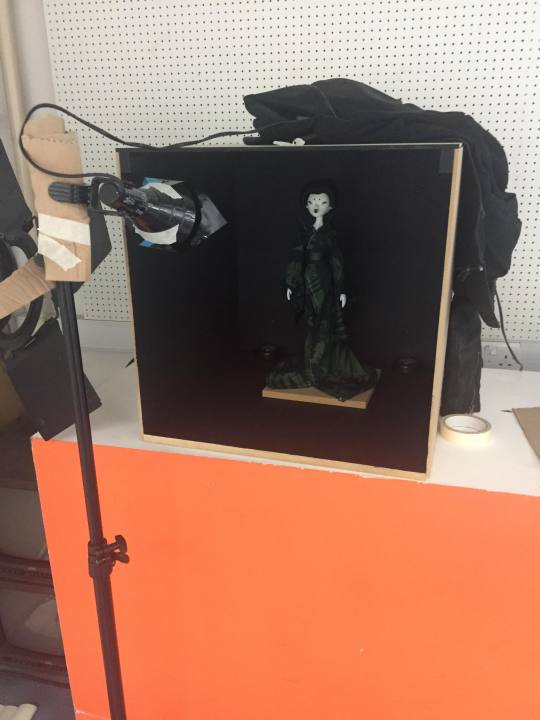
I left my box as it was as I wanted to do some filming with just the black background (this will be explained in the animation blog post).
Next I began to make prop pieces for my box to create the forest landscape. As I stated before, I wasn’t sure how to go about creating these as I couldn’t print trees large enough via digital methods. Instead I drew several tree textures like from my observational drawings before photocopying them and cutting them in different shapes to use as a texture for my trees. For the trunks I rolled up cartridge paper (to ensure they were sturdy) before placing them besides my model to ensure they were the right width.

Once happy with my width I taped them shut before decorating them with my textures and some horizontal lines to make them look like birch trees.
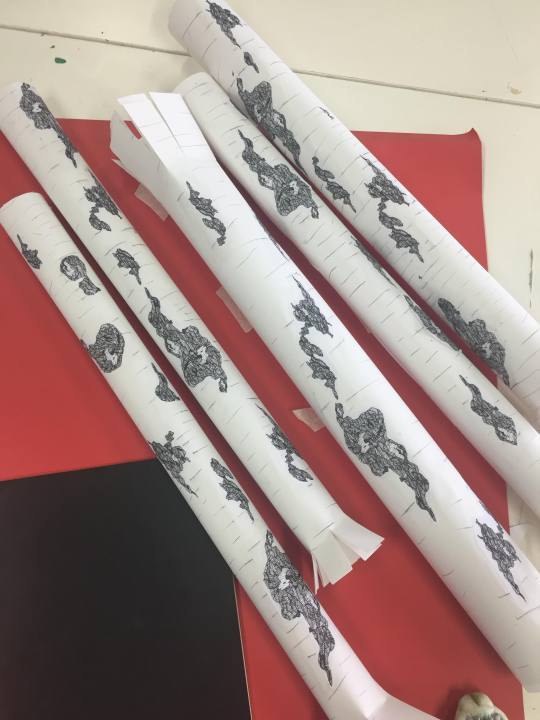
I also cut slits on the bottom of the trees so that they'd stand more stable in my set, and it also made them appear to look root like.
The back set pieces were simply just panels of paper with thin rectangular strips cut from them to make them look like distant trees.
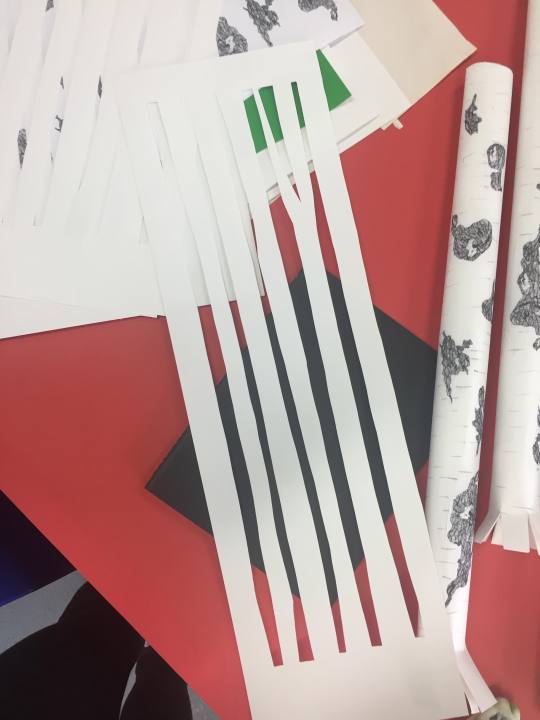
Because I wanted to record some shots with the black background I won’t be assembling my set till I begin the recording process as I can then resemble some areas and fix anything that doesn’t look quite right.
Actions:
1. Begin the filming process
2. Mid project review
Sources
Websites
Brett J. Banakis, As You Like It, http://brettjbanakis.com/index.php?/theater/as-you-like-it/ accessed 6. 5.18
Hindustantimes, These city-based artists are crafting magical worlds out of paper, https://www.hindustantimes.com/art-and-culture/these-city-based-artists-are-crafting-magical-worlds-out-of-paper/story-xpqUnzoobBOl0zq3LcMkZN.html accessed 6.5.18
0 notes
Text
Model Making Process
Planning and Experiments:
After a discussion with my Tutor, he suggested I try to scale up my model to a larger piece after showing me examples.



These heads are made from a variety of materials such as form, papermache, milliputi and plaster. The pros of using such materials is that they're light weight and enable you to create a head structure with limited materials.
However, when I applied the scale of the head to the rest of the body I found that my model would have to stand at least 90cm tall and as I wanted to use real hair and cyanotype process on fabric, I was certain that I would run out of resources. I was also confused about the articulation and how I would build a set around her due to her large scale.

Never the less, I did make my own head using papermache and miliputi.
I began by scrunching up a ball of newspaper to make a basic head shape before flattening the surface with papermache.
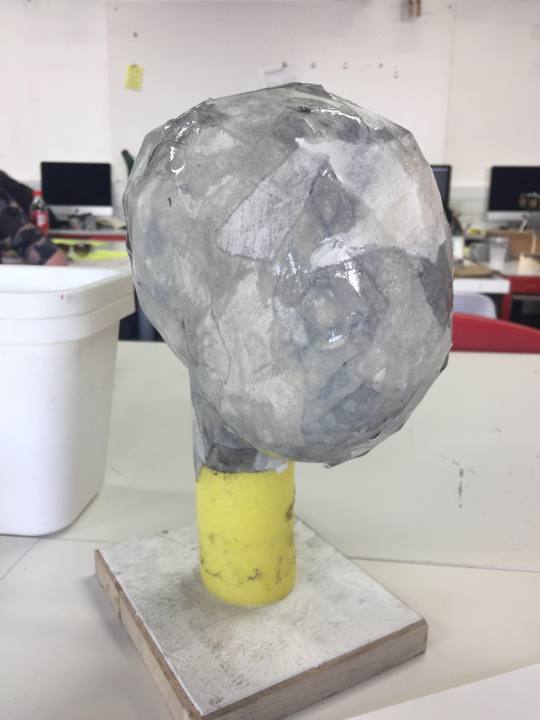
To add facial features I began to layer slabs of Miliputi onto the head. Miliputi is a really useful material as it air dries and is light weight. However, it is very expensive and only comes in small amounts and I found out the hard way that if you add a large amount to the newspaper base, this causes the head to become overly heavy and unable to hold itself up. I also made the mistake of positioning the neck piece to the back of the head causing it to be unable to keep itself upright. To correct this I could have sanded this down but then I’d risk loosing the facial features I worked hard to create.
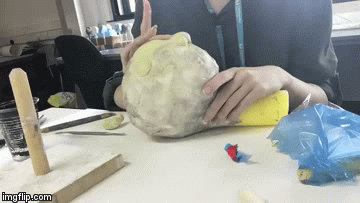
Because of this I decided not to take the progress of my work any further as I wouldn’t be able to use it for my final piece which I needed to make.
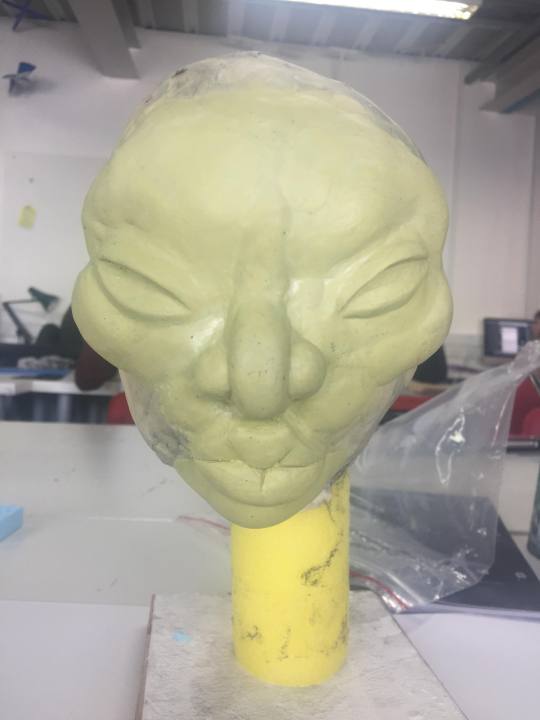
Actual Piece:
Whilst experimenting with my first model I came across the clay “Fimo” which is a similar constancy to Miliputi only less sticky and you have to bake it in order for it to dry. I began practicing sculpting by making two small heads and found difficulty working in that scale.
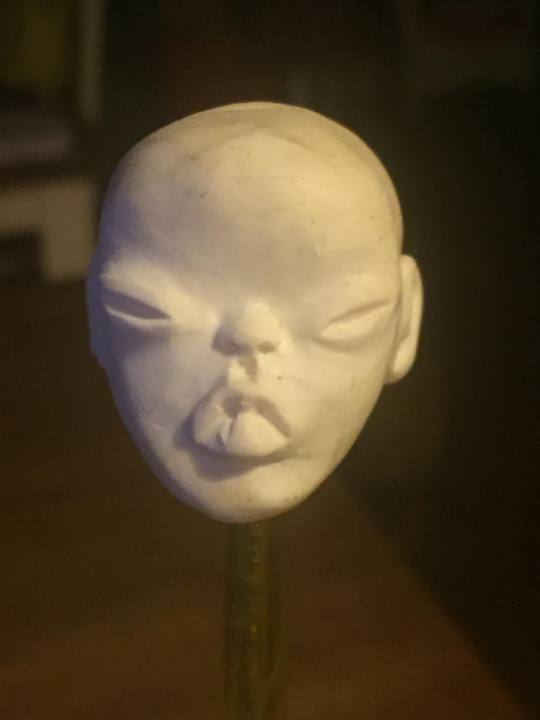
I wanted my model to have a thicker nose with big lips to make her appear more surreal but on this scale it made it look clumsy and exaggerated to the point of an immature cartoon. To improve this I decided to scale up the head but found I had a limited amount of clay to do so, with this in mind I began to plan how my model would be made from this material.
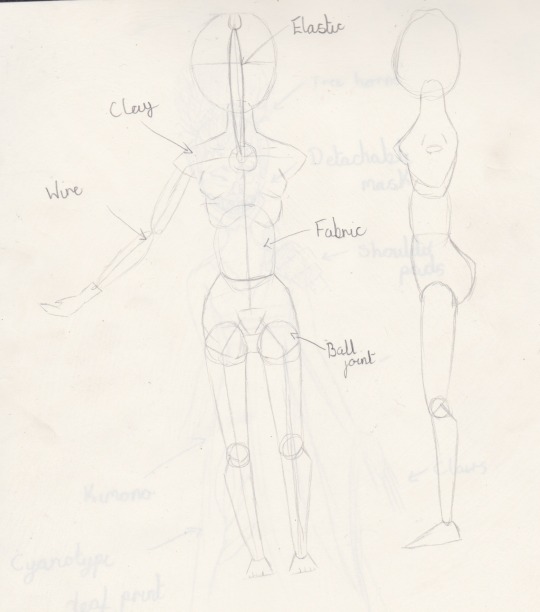
The idea was to create a hollow doll with a wire armature and trading out clay body parts with a mix of fabric ones. Originally the head was supposed to have a hook in the top side of the head that would connect to the neck piece via elastic.
I began the head sculpt by rolling up a ball of tin foil slightly smaller than what I had envisioned for the head and began to coat the ball in a thick layer of the clay building up the facial features on it. After baking I then used a scalpel and cut a section out of the top on the head before removing the tin foil.
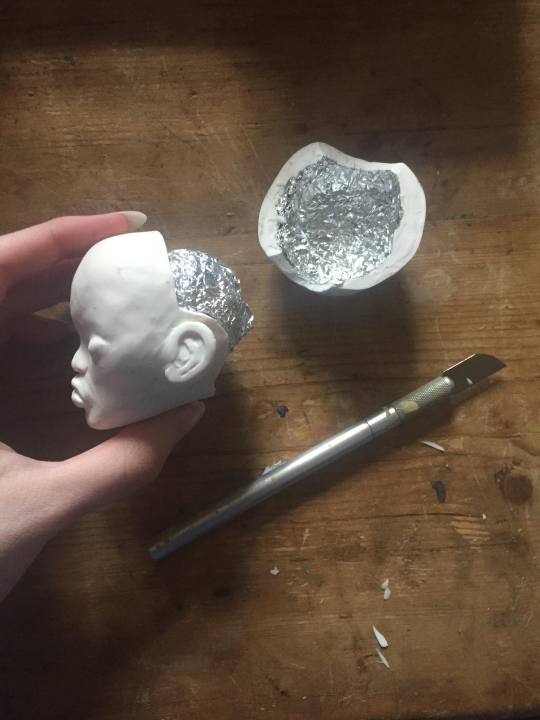
By doing this, my model was light weight and used the minimal amount of materials. The inside of the head was very messy due to the texture left by the tin foil but overall I deemed this a reliable method.
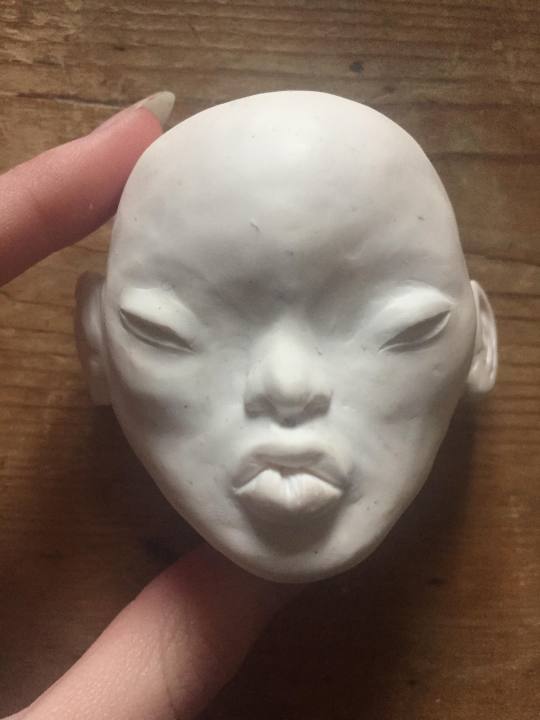

By scaling up the head, I was able to create more minimal details and it created more subtle and delicate features.
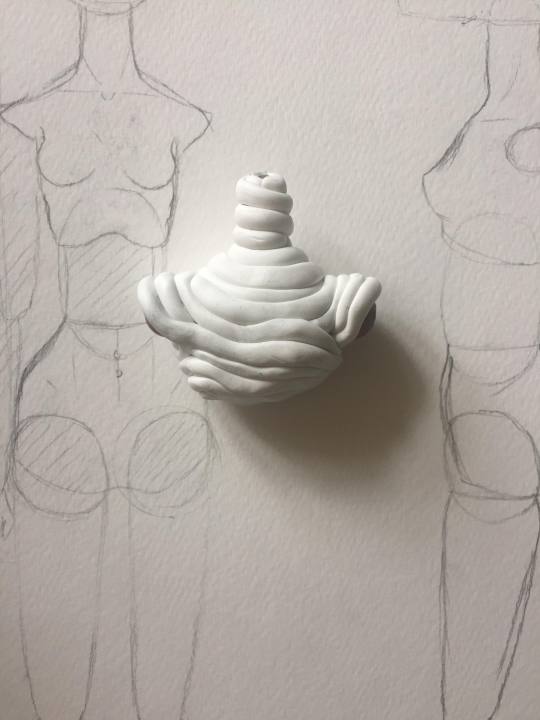
When it came to constructing the rest of the body I was careful to leave gaps where it would join to other limbs and I kept to my blue print to ensure nothing would be out of proportion. To control this I used the coiling method where you wrap a long roll of clay around the pieces before smoothing it out. I also placed two balls where the arms would connect and I made sure to cut away any excess clay from under the torso. I also created her demon mask in this way:
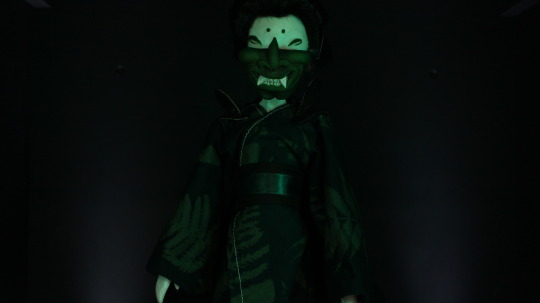
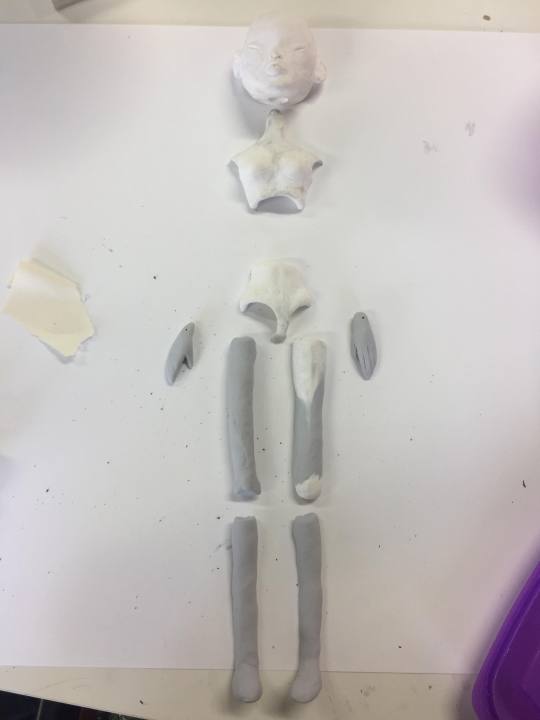
After constructing all of my pieces I then began to think about the armature and how it would move. After consulting my tutor I used aluminium wire coiled to place inside the shell of my clay parts, I sealed it shut with hot glue before adding more miliputi to ensure it wouldn't move or slip out.
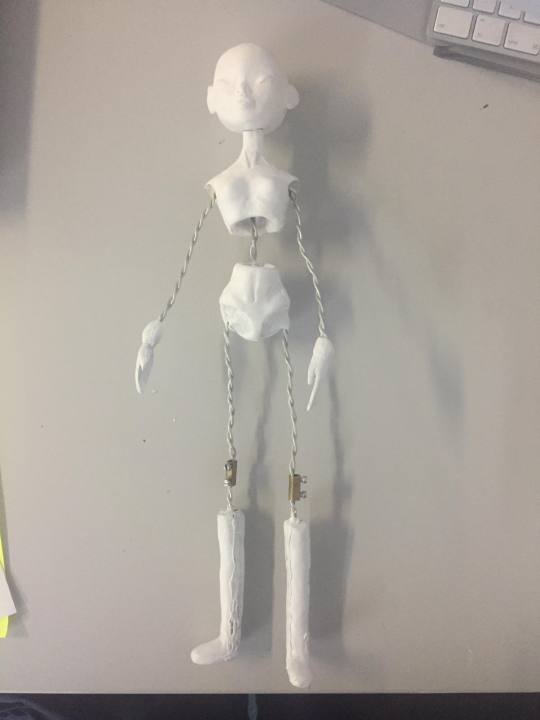
As the armature wasn’t long enough for the legs I had to extend them with two metal pegs which caused a bit of weakness with the legs. I also decided to scrap the thigh clay areas as they were restricting movement.
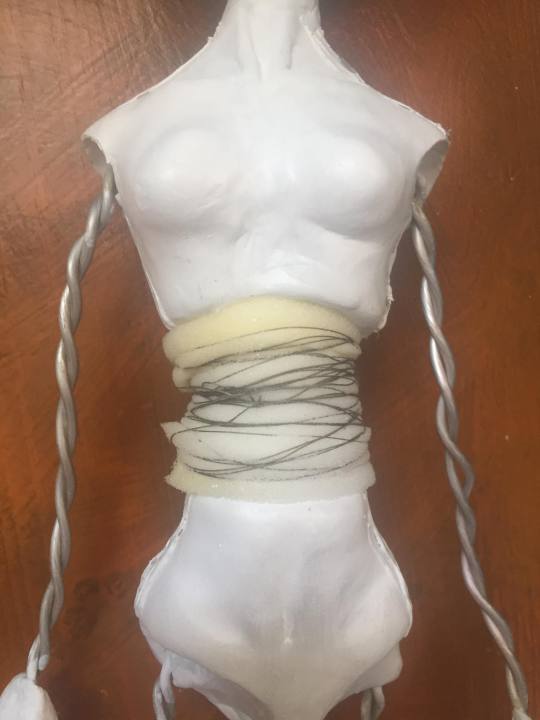
As the middle was weak due to it only being one coil of wire holding up the head and the torso, I wrapped sponge around it before tying it with string. This helped it keep its shape and restricted the risk of bending or the wire snapping.
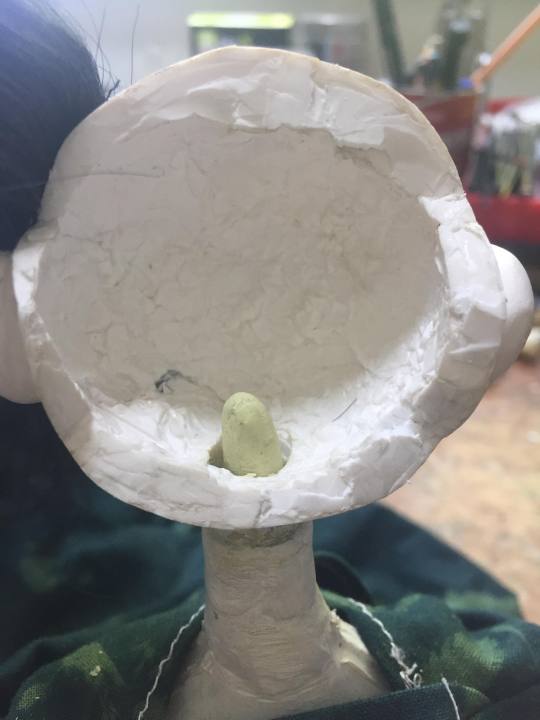
Going back to the connection of the head to the neck, I decided to lengthen the neck joint with miliputi before rolling a ball of the clay, letting it dry and then drilling a hole into it to allow it to slot onto the neck hole.

Although now I think I should have looked for alternative ways to connect the head and the neck, as its not very strong, it does still work. To connect the back of the head I used superglue which was a firm fix.
Decoration:
After painting the entire model white with acrylic paint, I began to think about how I would accessorise my model. Going back to my inspirations I decided to create a kimono using the cyanotype process.
I first bought some green cotton fabric and did a quick experiment on the fabric to see if the cyanotype would show up on the fabric.
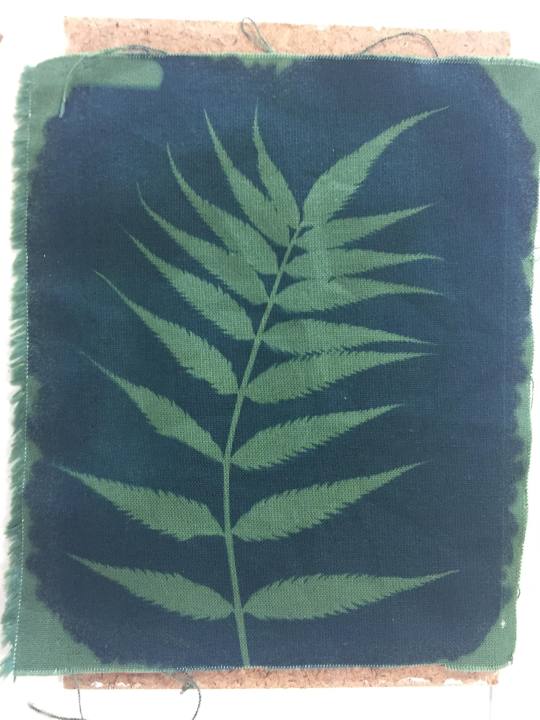
It worked well but the fabric wasn’t easy to wet with the cyanotype due to it being cheap and thick so I ended up using more cyanotype than I had wanted, however the end results were what I was hoping to achieve and although the fabric looks slightly blue, you can easily say its just dark green.
Realising that I would have to use a lot of cyanotype I decided to create a paper version of the kimono so that I could alter it and use the process on the pieces of fabric I cut out. As I said before, I have made kimonos in the past so have a basic understanding of the structure and forms used in it’s pattern, I still found a reference pattern though to get a basic idea.

Measuring my dolls body I made decisions on seam allowance, length and width, as I wanted the kimono to be quite long so that it would cover her legs and feet to give the illusion that she is floating.
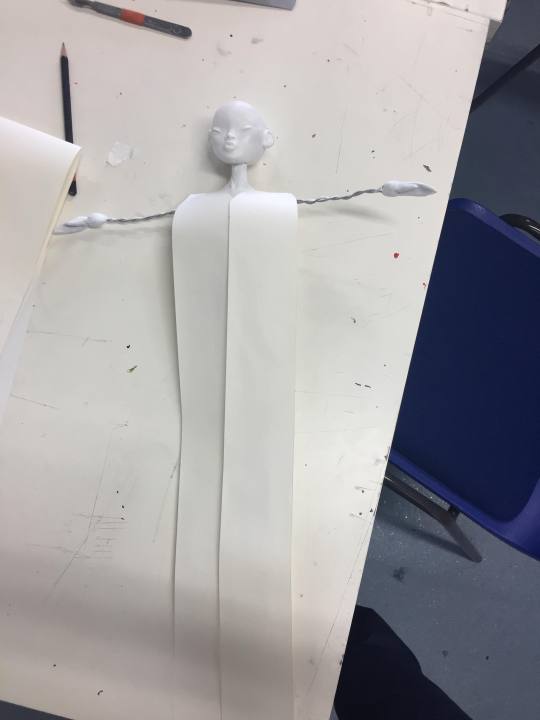
The sleeves were easy to construct as I just needed to know the length and width and then double it to create a long rectangle. The bodice was the hardest to create, as you can see from the image above, there is no shape or flair in the bottom and if I were to just construct a rectangular bodice it would bunch and look highly unflattering. the panels also didn’t cross over each other enough which would mean I wouldn’t be able to wrap it like a traditional kimono.

To improve this I added more material to allow it to wrap and I also added triangular inserts to the sides to give it more flair. The shoulders were also taken in so the kimono would sit better on the tops of her shoulders.

With one last fitting, I pinned the pattern onto the fabric before cutting it out leaving room for seam allowance. After all the pieces were cut out I began the cyanotype process.

One of the issues with working with such a large amount of frantic were the small scale of the frames which meant I wasn’t able to keep the leaves as flat to the fabric as I wanted.
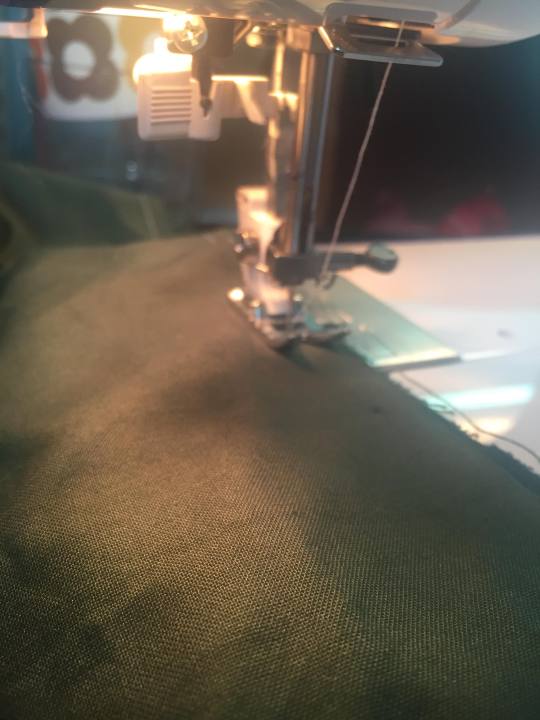
When all the pieces were cut I stitched them together using a sewing machine to use minimal time and for a neat finish. I used white cotton to match with the white skin.
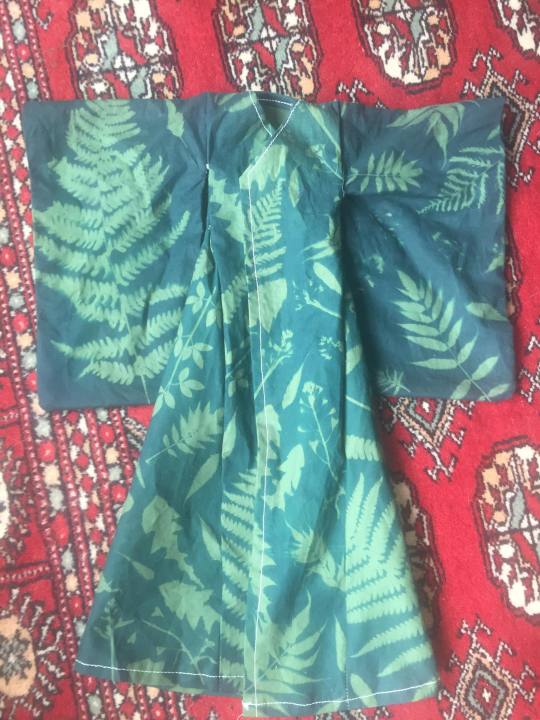
Putting the clothing aside, I began to work on creating her hair. I watched a doll artist named Mozekyto on Youtube and learnt about using yarn to make doll hair. To cut time I decided to buy yarn that was already in wefts but as there were none in black, I thought I could dye it. This didn’t work as the wool was nylon and didn’t hold any of the black dye. Wanting to keep to schedule, I decided to make do with what I had by finding a black wig in the dressing up box, cutting the wefts from the lace, making sure none of the hair was accidentally damaged or cut, before straightening in ready to attach to the head.

I marked around the head where I planned to stick the hair to create the style I wanted before I stuck them on the head.
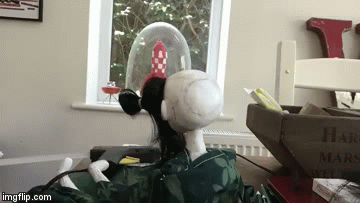
Because the type of hair I used was poor in quality it left loose ends and was very thick making it difficult to work with. If I’d bought the black wool first time and hand made the wefts I feel I would have achieved a better outcome, I should have also painted the covered hair areas black to avoid her white scalp from showing through.
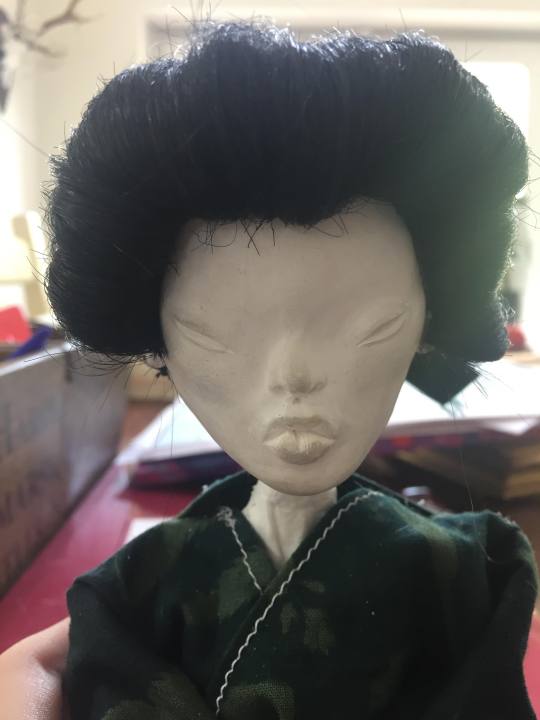

Face:
Watching videos from you tubers such as Dollightful and Mozekyto helped me choose materials to use on her face such as pastels and watercolour pencils. However, these doll artists used a product called Mr. Super Clear which is used to prime objects before you draw or paint on them. I wasn’t able to get hold of such a product but I remembered how pastel drawings are often sealed with hairspray so I thought this would work. However, I quickly learnt that it made no difference to my work and actually assisted in scraping off the white paint off her skin. I had luckily experimented with using pastels and pencils on my smaller faces and found the surface area of the face wasn’t smooth enough and without being able to build another layer with the sealant I didn’t have, I was unable to build up colour with my pastels. Instead I turned to acrylics and although I ended up with a similar makeup design than I had hoped, I still think it’s effective due to its simplicity.

I kept the eyes white but I don’t think their as dramatic as they could have been so I should add gloss to give them shine and to add another texture.
Dressing:
Whilst assembling my model, I began to add small accessories like her obi which was made with a folded playing card, material from an old guitar case, hot glue and a ribbon. I also decided to make the should pads in the same way but they were different from my original design as I wasn’t sure how to construct them so I simplified the design but they are still visually effective.
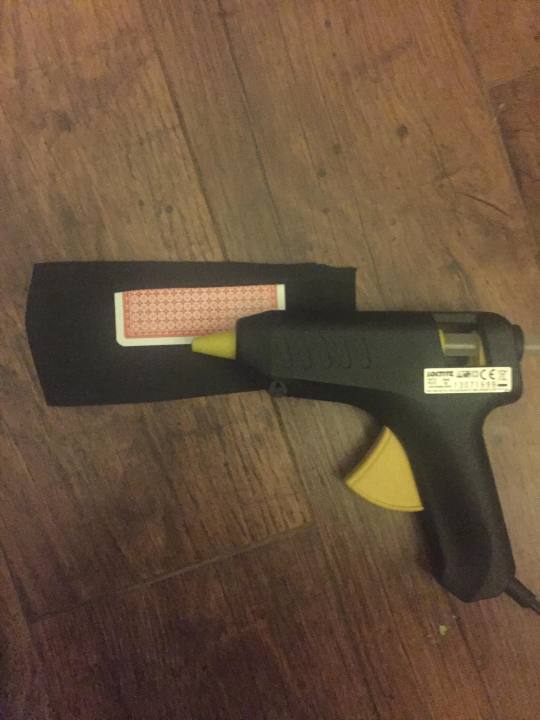
After creating a stand I could finally call her complete.
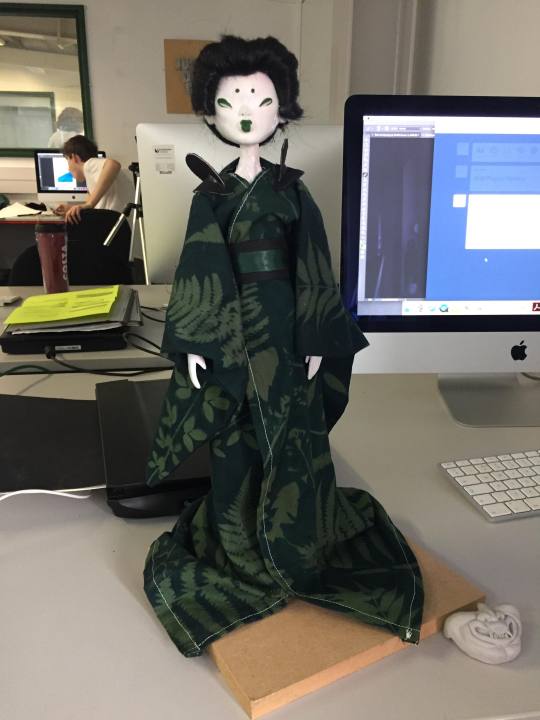
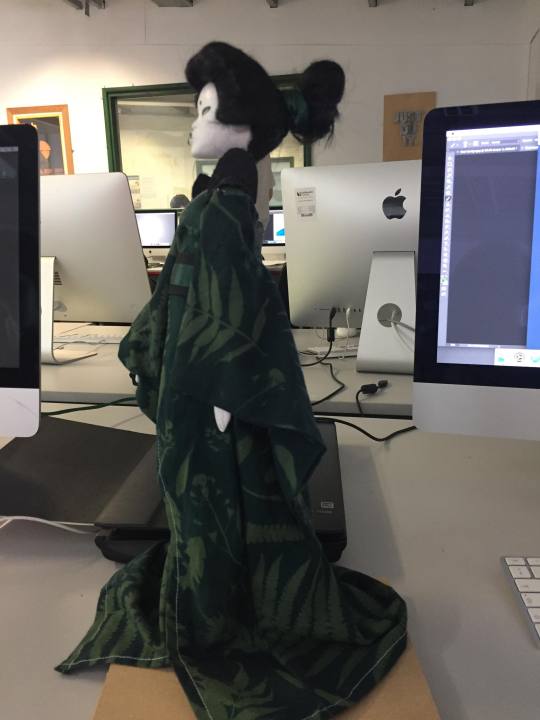
Reflection:
Overall I am very pleased with the outcome, obviously I made some mistakes with the materials and I misjudged my design a few times but overall, she is aesthetically interesting, she is possible and mimics the design concepts my audience suggested. I still have yet to create her demon mask but I want to create that from Fimo as miliputi is too sticky to work with on a small scale.
Actions:
1. Make her demon mask
2. Begin to design her set and look at other sets to get inspiration
3. Think about how I want to shoot my animation
4. Shoot animation
5. Edit animation and think about sound and effects
Sources
Videos
Mozekyto (2016), How to Make a Doll Wig | Making Yarn Wefts | Mozekyto, https://www.youtube.com/watch?v=FdXay72gpS0 accessed 24.5.18
Dollightful (2016), All Materials for Doll Customising, https://www.youtube.com/watch?v=iBtrDdHA8y8 accessed on 24.5.18
Dollightful (2016), Your First Custom : Drawing the Face Step-by-Step, https://www.youtube.com/watch?v=60XBHFX-LaQ accessed on 24.5.18
0 notes
Text
Designing Process
For this project I want to attempt to make a 3D model of a forest spirit inspired by the Japanese suicide forest, Aokigahara.
Addressing my Audience:
Before I start designing my model, I need to address my audience. Taking into consideration the context behind this piece its already clear that this won’t be a suitable subject for children under the age of 12 to see as it incorporates ideas of death and suicide as well as monsters and ghosts which young children can become easily scared of.
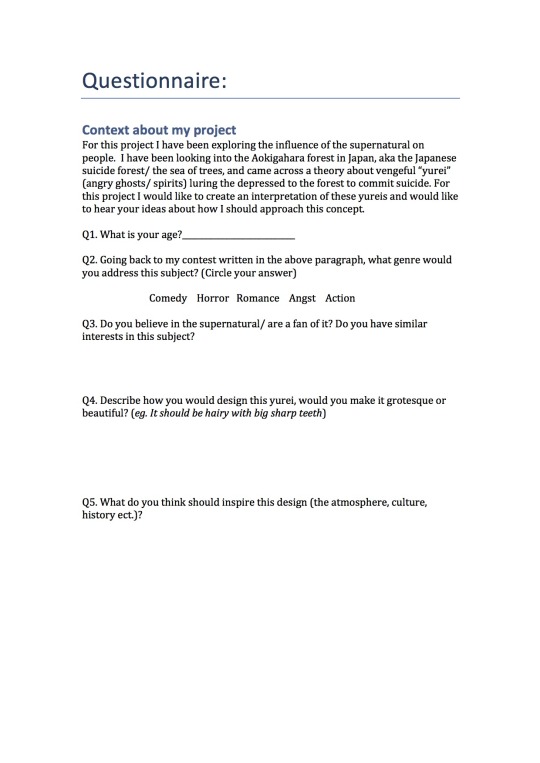
To narrow down my audience from other age groups I created a questionnaire specifically asking the viewer their age, interests and how they would approach this subject. I asked this to inspire my own designs and to see if it differs depending on age and whether that person believes in the supernatural.
I asked elderly public, young teens, young adults and adults to see if there would be a difference on views depending on their age. My research disproved this theory as all people seemed interested and were enthusiastic with their answers, even if younger teens had a more immature view on my context. However, I did find that there was a common belief of the supernatural in each person whether that be in mythology or spirits.
Because of this my target audience is going to be fans of paranormal horror over the age of 16, so that it will be viewed in a more mature way. An interesting view of this subject was from one of my elderly viewers who said that he believed in the supernatural due to religion and although many don’t believe in God anymore, I feel this is one of the reasons people still believe in the paranormal.
In terms of genre; angst and horror were the most popular of votes due to the use of ghouls but also because of the theme of suicide. Many chose the appearance of a beautiful spirit that would lure its victims to it before revealing its true grotesque form and historical, cultural and atmospheric subjects should be used to influence my work. It was also suggested that I take inspiration from nature to use in my designs.
Inspiration that I took for my designs:
Due to the spirit being based in a Japanese forest I took inspiration from Japanese traditional dress and costume.
Geisha:
The most stereotypical and known style of dress in Japan is the geisha, a female entertainer with skills in the arts and conversation. She is not a common prostitute as she represents Japans beauty standards on pale skin and elegant and petite features.
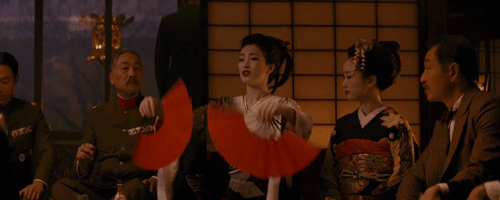
First appearing in the 1700′s, geisha were originally men who would entertain at parties with singing, dancing and conversation, however female prostitutes working in Brothels began to use the name and started practicing art of entertainment via different means and not just sex.
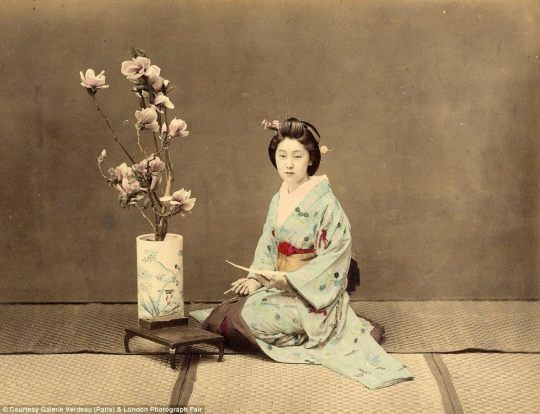
This effected the popularity of brothels and prostitutes and also caused confusion amongst customers leading the government to create strict rules on the hours and where they worked, dress code and they were also not allowed to be hired singly to avoid them from having sex (which isn’t a part of the job) with their customers which was supposed to reduce their popularity but instead it made them more desirable. In fact those who the geisha chooses to have sex with, she must bind with in a ceremony similar to a wedding ceremony.
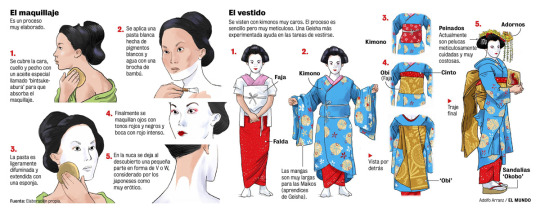
Geisha dress according to their age, popularity and ranking. For example, Maiko, which are apprentice geisha, where brighter, more colourful kimono with platform sandals known as okobo in comparison to their mentors known as Geikos. They paint their faces white with red lipstick and eye makeup with elaborate hairstyles decorated with numerous hair pins and ornaments.
Kabuki:
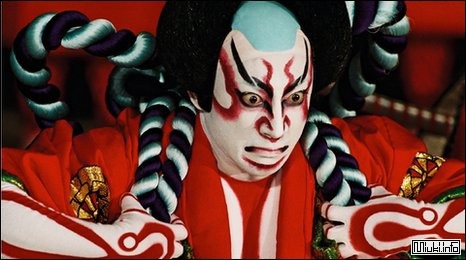
A form of traditional Japanese theatre, mixed with music, dancing and acting, beginning in early 17th century, when a female dancer named Okuni performed parodies of Buddhist prayers and gained great popularity. However the sensuous character of the dances and prostitution of the actresses became disruptive for the government who banned women from performing by replacing them with young boys before finally giving the roles to older men which has continued to be the case till this day.
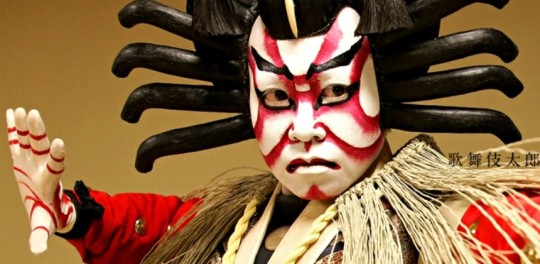
Elaborate sets and costumes are used to present these dramas and are specific depending on the characters personality. For example the character of the lion, the actor has long fluffy hair that he whips around in a dance like manner.

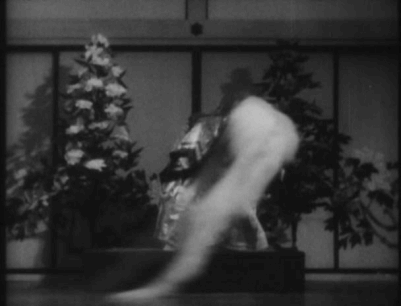
They all wear white and red face paint similar to that of a geisha but in a more absurd and masculine fashion. They also dress in traditional Japanese kimonos and sandals. Depending on the role and story often the dress are warrior like and used to create a bulky body structure.
Kimono:
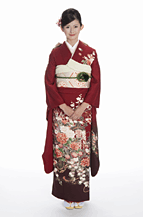
An instantly recognisable garment from Japan that has been around for many centuries of Japan and evolved from many different designs. It is a wrap around coat like dress fastened by an obi around the middle with long sleeves. It was once traditional everyday dress in Japan until the country became Westionised in the 18th century.
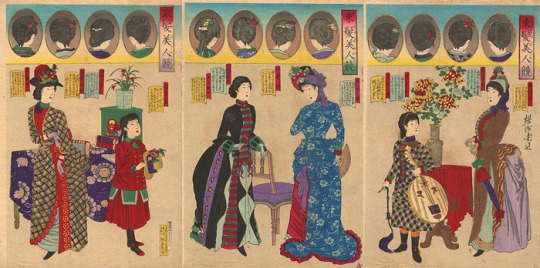
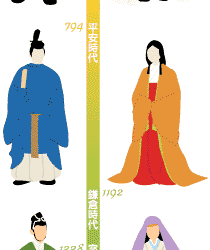
Made specifically from silk or wood-block printed cotton, they come in all different colours and patterns, depending on the occasion.

Shironuri:

A subculture of the Harajuku fashion style in Japan, Shironuri, meaning painted in white, takes inspiration from the geisha makeup, gothic attire and elements of nature.
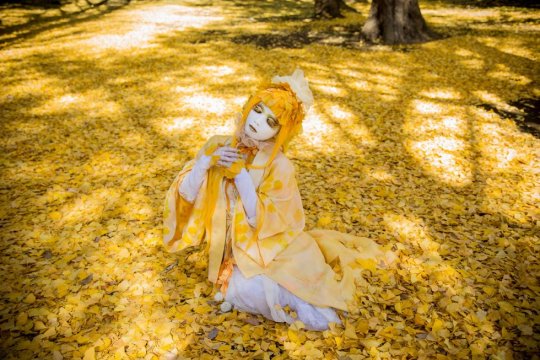
Minori, a wearer of the style, states that growing up in the countryside lead her to becoming interested in nature and she decided to mix shironuri with botanicals by placing petals on her cheek or drawing vines down her face. She also dresses in frilly Victorian style fashion in pastel tones to contrast with the delicacy of botanicals like flower petals.

Dryad:
A dryad is a nymph/ nature spirit from Greek mythology, who lives in trees and takes the form of a beautiful young woman. Considered minor and mortal goddesses they have long life spans but are deeply and supernaturally connected to the trees they call home, and are limited to the space of the tree or the forest the tree grows in.
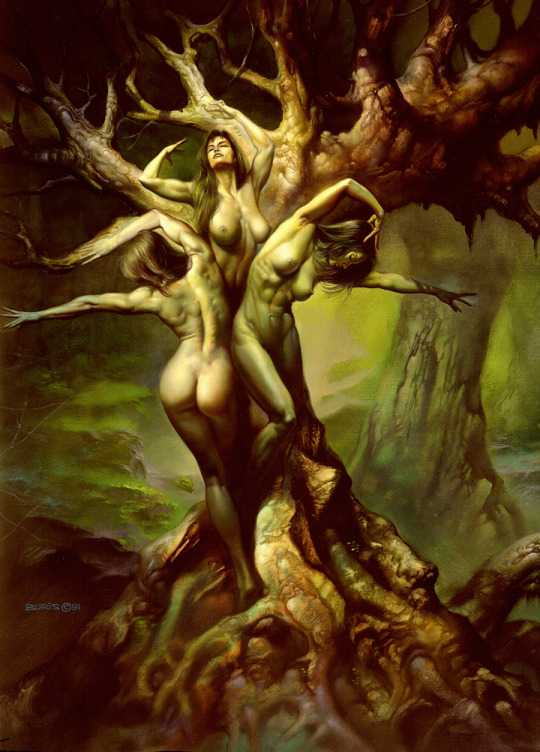
If the tree dies, then the dryad could die along with it and when a mortal cuts down the tree and causes death of a Dryad, then that mortal is usually punished unless he or she attempted to make peace with or appease the Dryad. They are mischievously spirits and fierce protectors of the trees and nature.
Wendigo:
Wendigo’s are creatures from Algonquian Native American folklores surrounding hunger and cannibalism. Living in cold and forest conditions, the wendigo is skeletal in body and stands tall and some depictions portray the Wendigo as deer like with antlers.
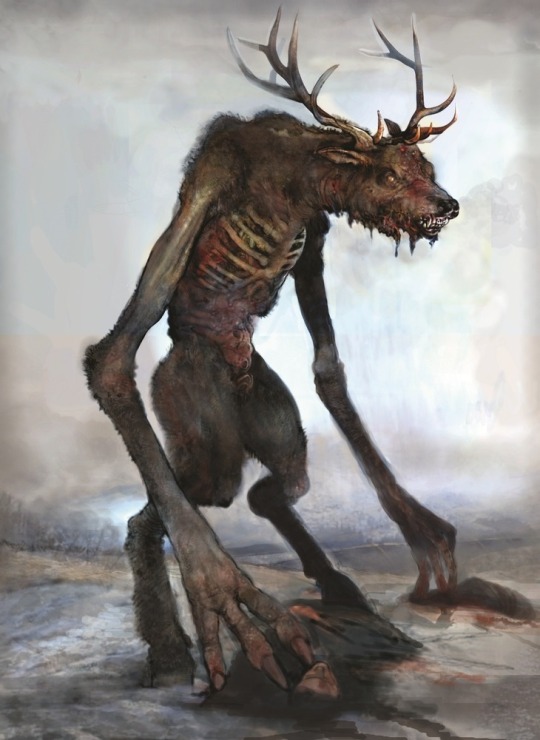
In 2015′s video game, Until Dawn, the wendigo are unisexual creatures with a long scrawny and hairless body with razor sharp teeth and glossy eyes. Their skin is also bullet proof and they loose all human characteristics.

In David Bruckner’s 2017′s movie, The Ritual, based in a Sweden forest the monster is based on Norse mythology and is apparently the son of God Loki. Designed by concept artist Keith Thompson, a freelance designer who creates characters with a surreal, cryptic style and steam-punk nature, the monster is stag like but an odd design element is the fact that the monster has human hands.

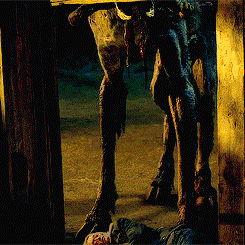
The Birch:
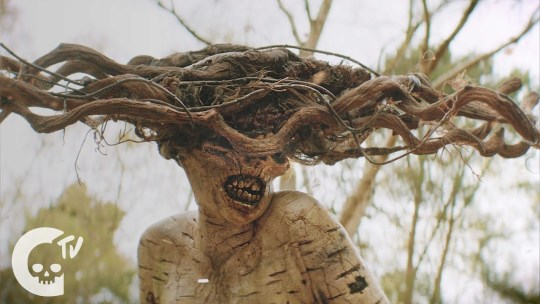
2016 short horror film by Ben Franklin and Anthony Melton, depicts the tale of a bullied schoolboy who summons an ancient tree spirit to take revenge.
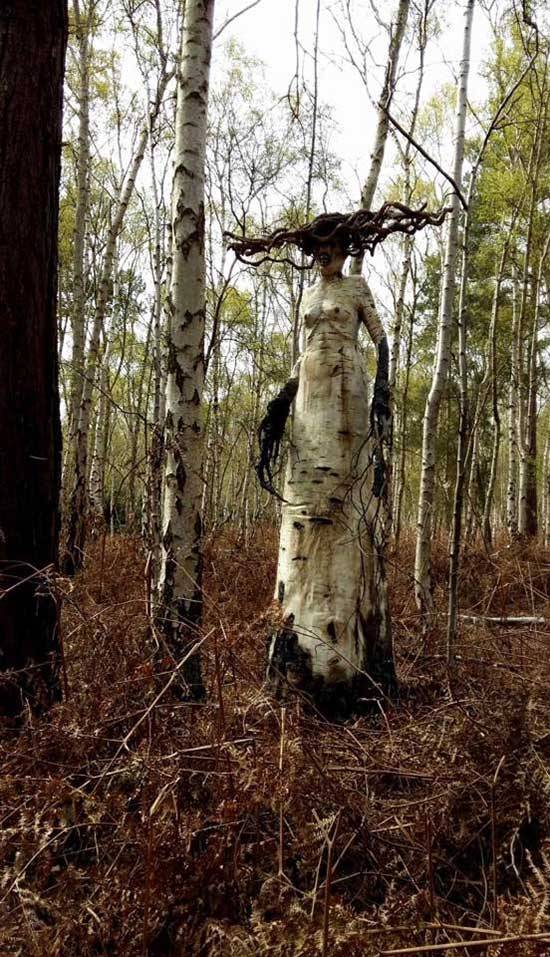
The design of the spirit is that of a female, skeletal tree with branches that form it’s hair/ the top of it’s head. Her appearance is sickly and scary yet the form is still feminine and you can recognise the creatures sex via these human and lady body shapes.
Designing:
Taking into account what my audience has said, I began drawing my first initial designs. Most of my audience wanted to see a beautiful ghost that could lure their victims to their deaths so I decided to look at geisha’s which used to be the standard of perfection and beauty in Japan.

Above are my first initial designs, I drew inspiration Japanese actress and model, Rila Fukushima, due to her unique and alien like facial features.
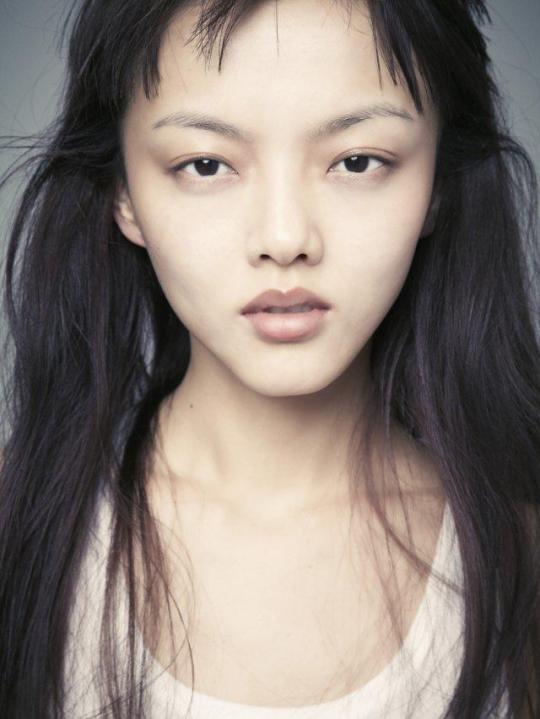
I decided to draw more beautiful ghosts rather than grotesque creatures like the wending or the monster from the Ritual, after I received feedback that I should make my ghost more subtle as this would create a feeling of unease rather than shock my audience as the feeling would wear off and they would no longer be frightened.
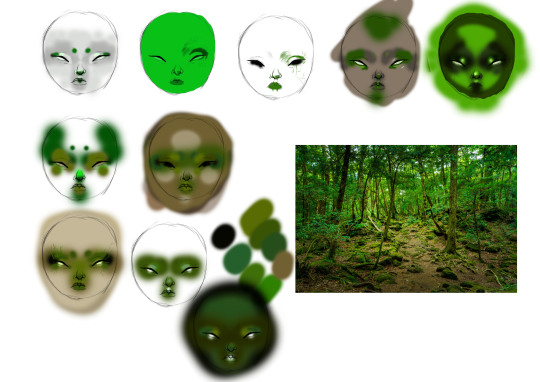
Once happy with my initial ideas I began to test out colour schemes using colours from the Aokigahara forest. After showing my colour schemes to my audience I received feedback that the white skin tones were the most popular due to the relationship with geisha’s. The white eyes were also the most popular as they hold life in comparison to the dull black eyes. I incorporated the vine makeup technique used in the Shirionuri subculture and was surprised that people actually disliked this stating they’d seen that done before and didn’t feel it added anything to the design.
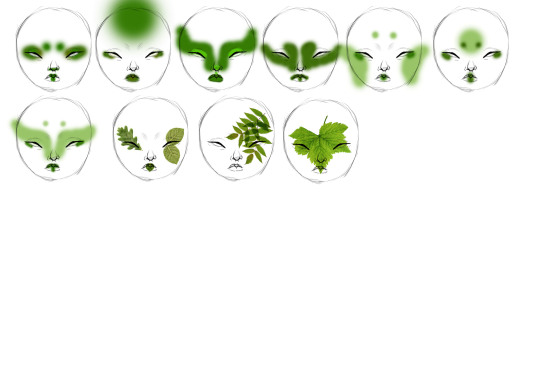
My next colour studies were created with the white skin tones and I began to take influence from Kabuki makeup which allowed me to experiment further with contours and facial structures. I also experimented with collage by placing leaves over area’s of the face but my audience wasn’t as keen as they preferred the more Japanese influenced makeup.
Final Design and Reflection:
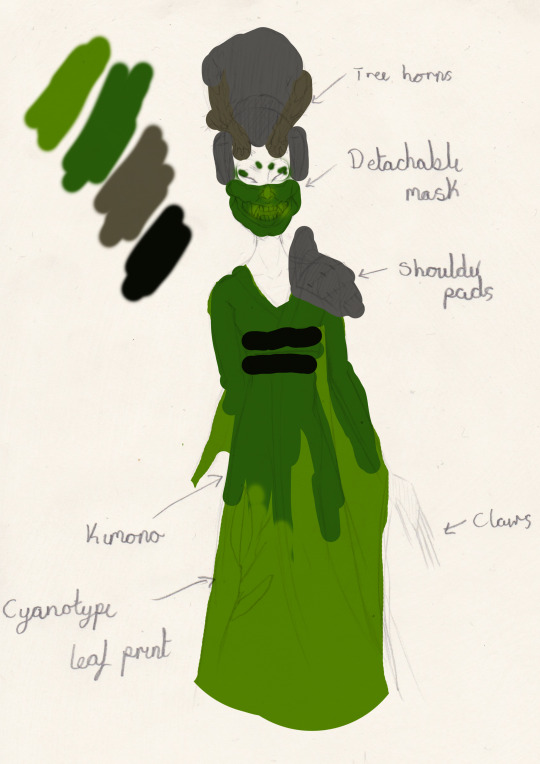
Above is a rough sketch and coloured design of what I hope my final piece will look like. The makeup will be geisha like but in a green colour scheme and the mask will also be green. I liked the idea of the tree like horns but whether this will translate through to my final product is something to think about.
I want the kimono to be created via the cyanotype process but I will have to test the chemical on green fabric to see if it works as well as it does on white. I also don’t want the pattern to be blue so I’m hoping the colour will be a dark green otherwise I will have to darken it with coffee.
After watching doll customising videos I learnt that you can create doll hair from yarn or wool as it has a stiffer, fluffier texture which makes it easier to style, and as I’m creating a geisha hair style this material should make the styling process easier.
The accessories will be the long claw like nails which I have seen artists create via plastic found in packaging. The shoulder pieces are still being decided on as I don’t know whether to include them but they do give an interesting silhouette and are a modern take on the traditional kimono. Another thing I will have to think about is the kimono and how I will make it. Although I can sew and have made patterns for clothes in the past, I need to get the pattern exact as I will have only one shot at making the kimono due to the cyanotype being an expensive chemical.
As for the structure of the body I will need to create a blue print to decide on articulation and form as I do want to animate this model. I would like to create a ball jointed model like the Popovy dolls, however, with my lack of experience in 3D models I may have to simplify this idea due to time, materials and knowledge.
Actions:
1. Create a blue print for my design pointing out articulation and form
2. Look at potential materials and processes I could use to create this model
3. Begin to create model or experiment models.
Sources:
Websites
History Undressed, The history and Culture of Japanese Geisha, http://www.historyundressed.com/2008/08/history-and-culture-of-japanese-geisha.html accessed on 24.5.18
Encyclopedia Britannica, Kabuki, https://www.britannica.com/art/Kabuki accessed on 24.5.18
Victoria and Albert Museum, A History of the Kimono, http://www.vam.ac.uk/content/articles/h/a-history-of-the-kimono/ accessed on 24.5.18
Mythology. net, Dryad, https://mythology.net/greek/greek-creatures/dryad/ accessed on 24.5.18
ati, The Native American Legend Of The Wendigo — The Frostbitten Monster Of Your Nightmares, http://allthatsinteresting.com/wendigo accessed on 24.5.18
Collider, ‘The Ritual’: Let’s Talk About That Insane Movie Monster, http://collider.com/the-ritual-movie-monster-explained/ accessed on 24.5.18
IMDb, The Birch (2016), https://www.imdb.com/title/tt5723584/ accessed on 24.5.18
Videos
Tokyo Fashion (2012), Minori’s World- Japanese Shirt-Nuri Subculture Interview & Photo Shoot, https://www.youtube.com/watch?v=Dwi5OhZJmFI accessed on 24.5.18
CryptTV (2017), The Birch | Scary Short Horror Film | Crypt TV, https://www.youtube.com/watch?v=SxQj0DumF8Y accessed on 24.5.18
0 notes
Text
Trip
With one of my peers, we decided to go to creepy and atmospheric places with a connection to the supernatural to collect primary imagery to assist in our projects.
First Location: Rendlesham Forest
History- In December 1980 there were several UFO sightings in Rendlesham forest. This occurred during the cold war so military was sensitive during that time but since then there has been numerous sightings around the area.

We followed the UFO trail in naive hope that we might come across something surreal or alien, sadly all we saw were trees but the secluded atmosphere and thickness of the forest created a tension that caused us to be on high alert to any noise or movement.

I took photos of any compositions I thought I could use in the future of my project. Starting with coloured photos and using filters to get a sense of the colour scheme of forests, I later shot in black and white as I felt this picked up more texture and detail of the trees and also created a vintage composition and created more tension.
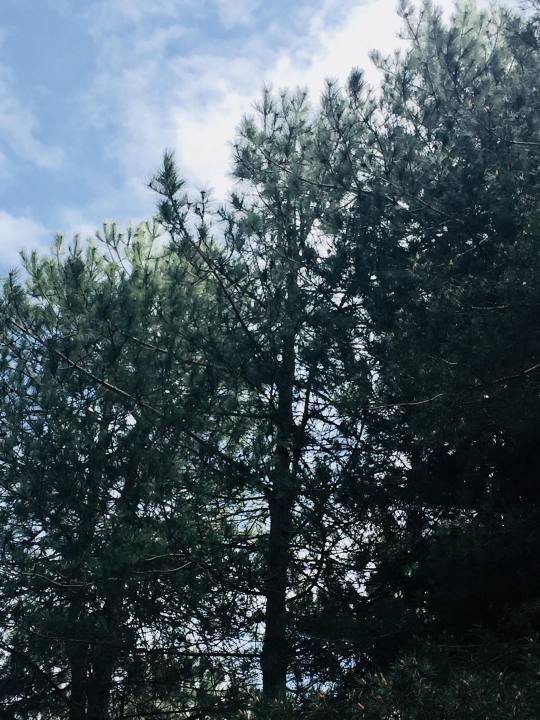


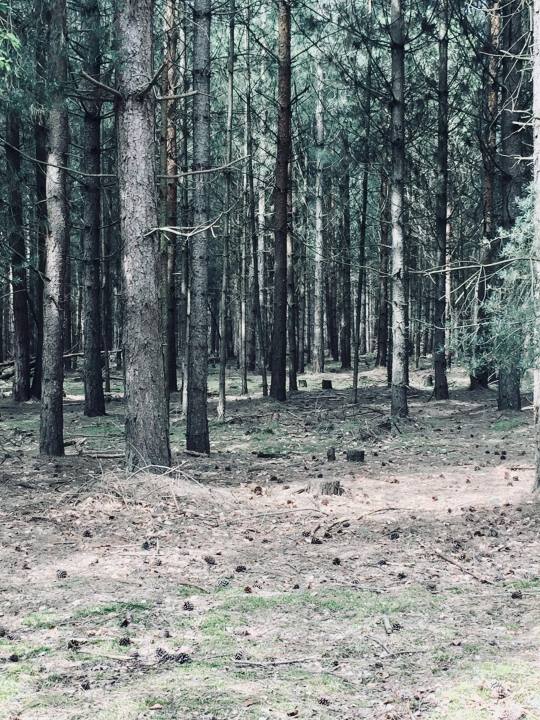

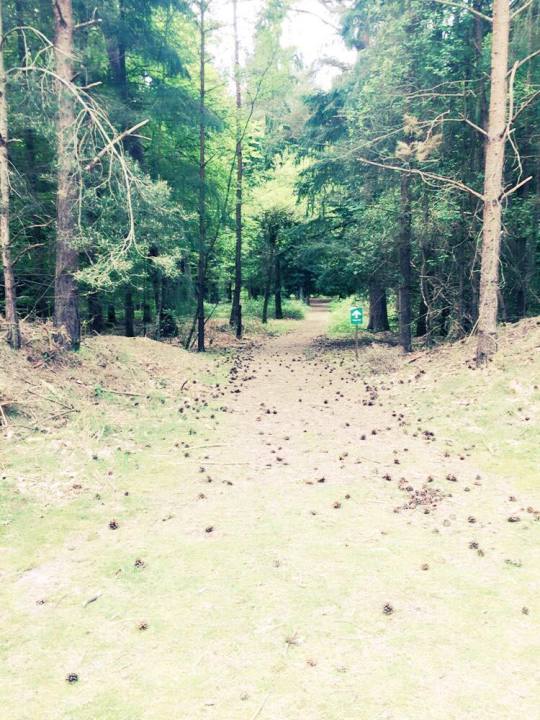
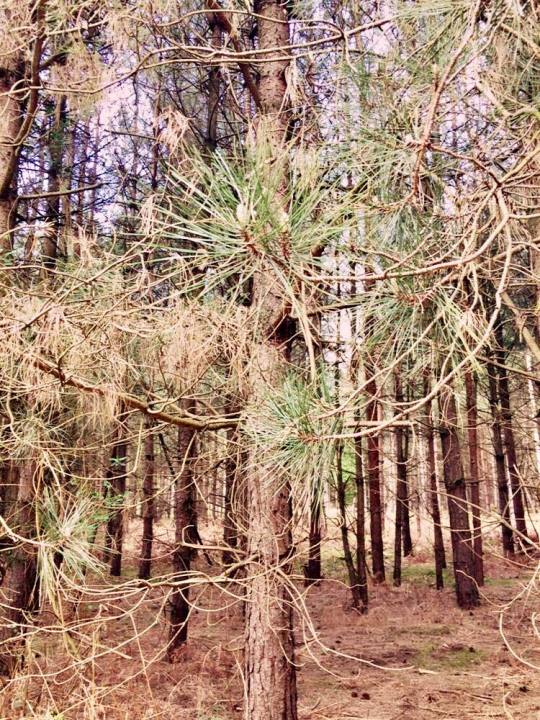
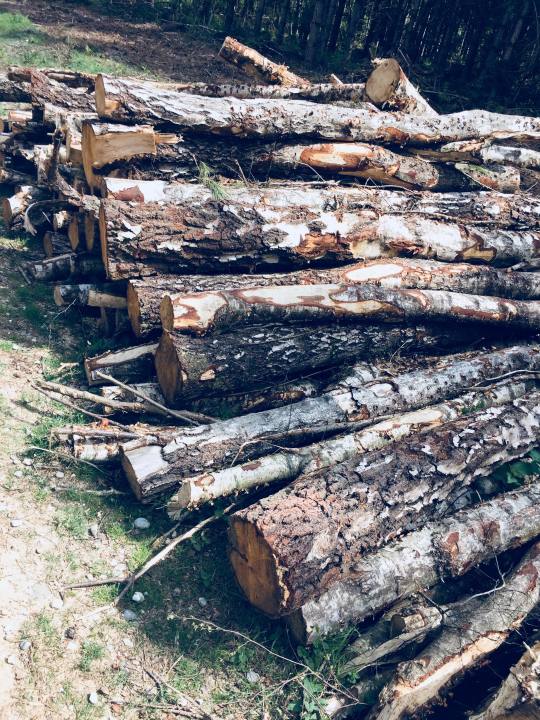
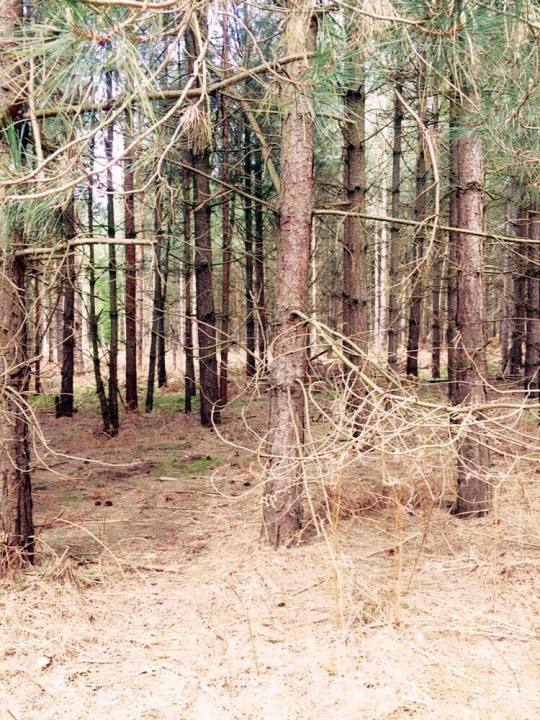
The colour scheme in these photos is a mixture of browns and dark greens. In the Aokigahara forest, there is apparently more green and I expect the shapes of the trees are different. It’s also said that the Japanese forest floor isn’t as flat as Rendalsham due to caves, rivers and cliffs.
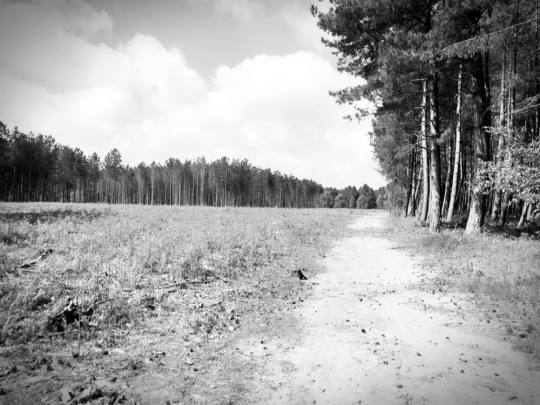
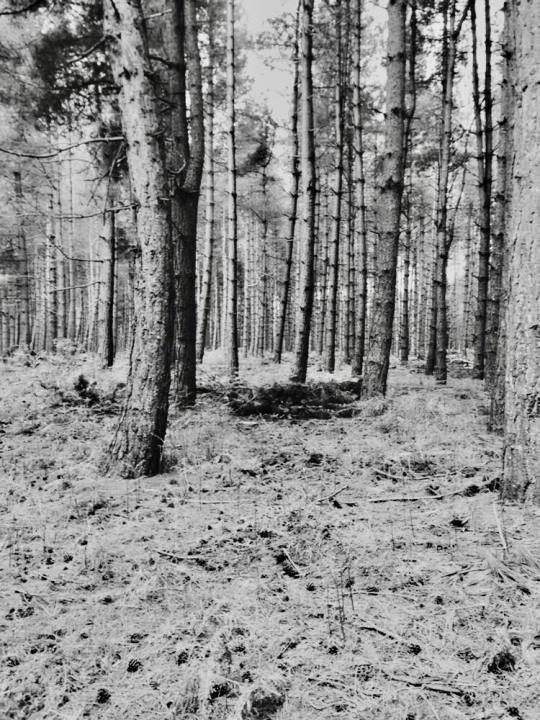
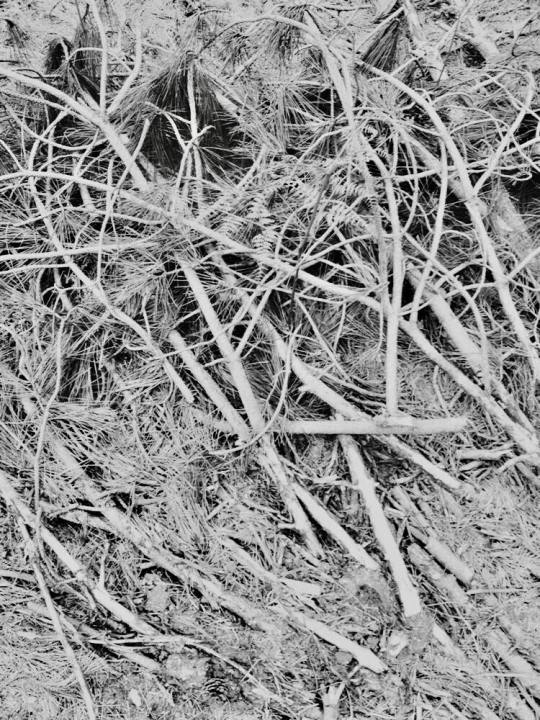
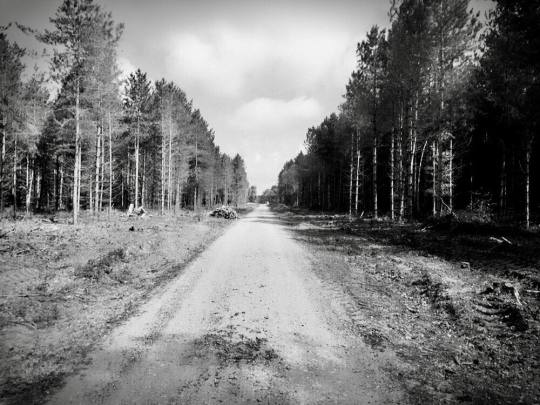
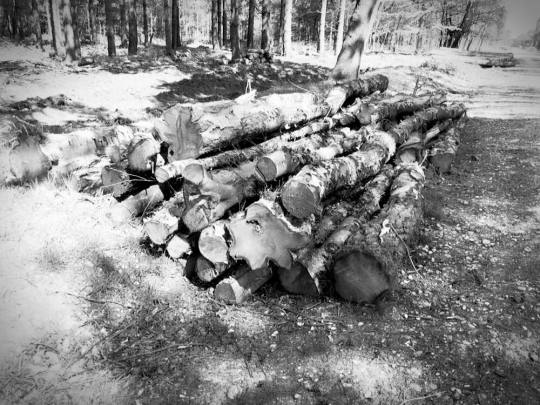
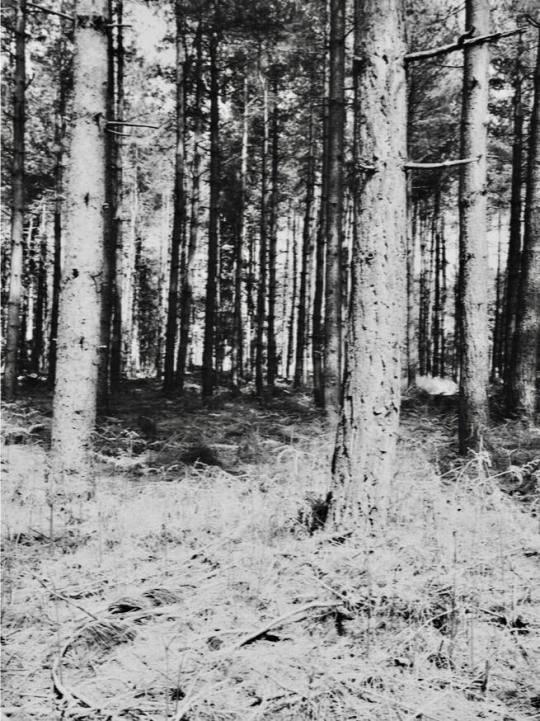

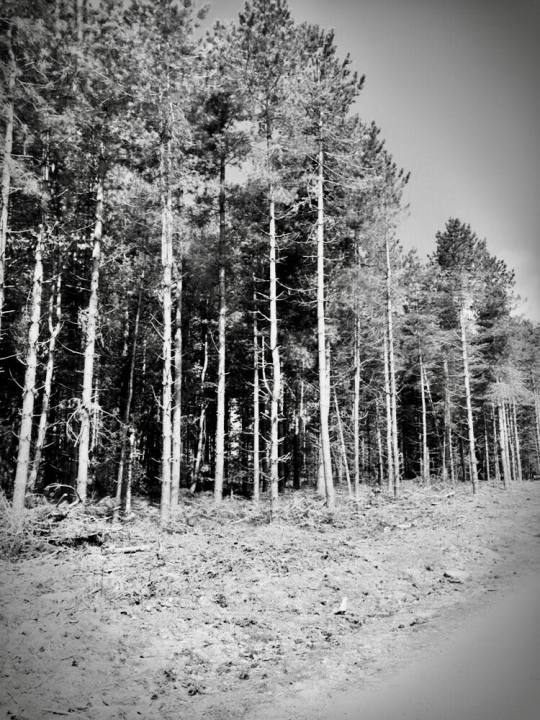
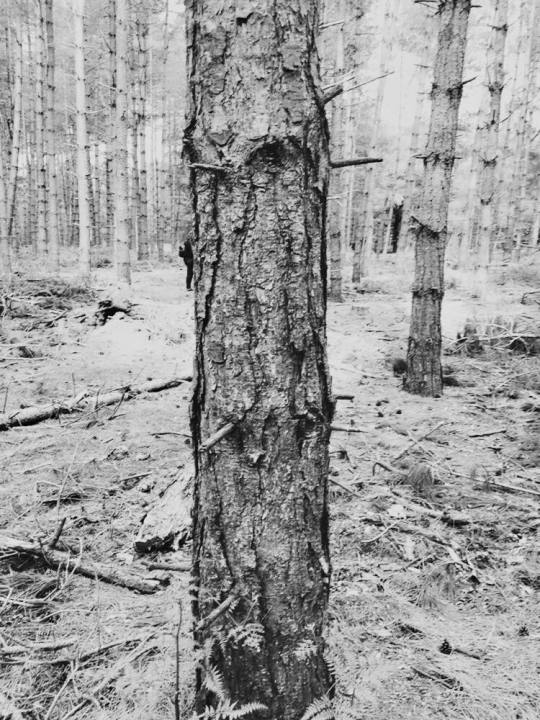
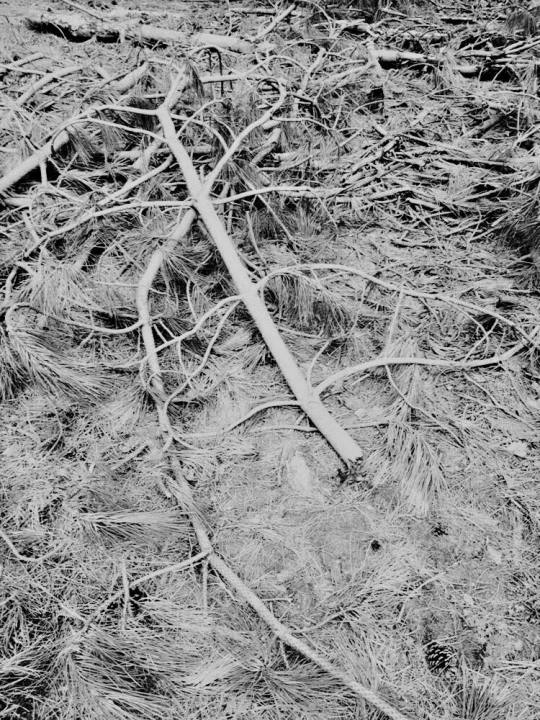
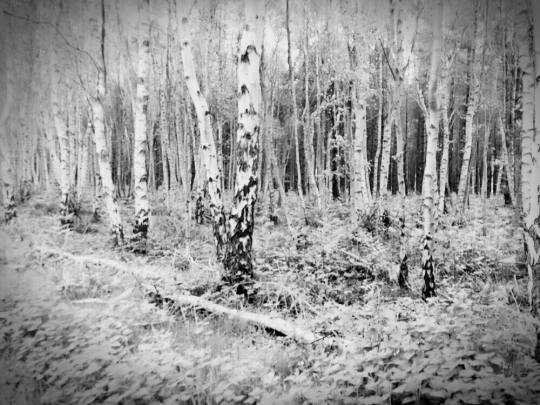
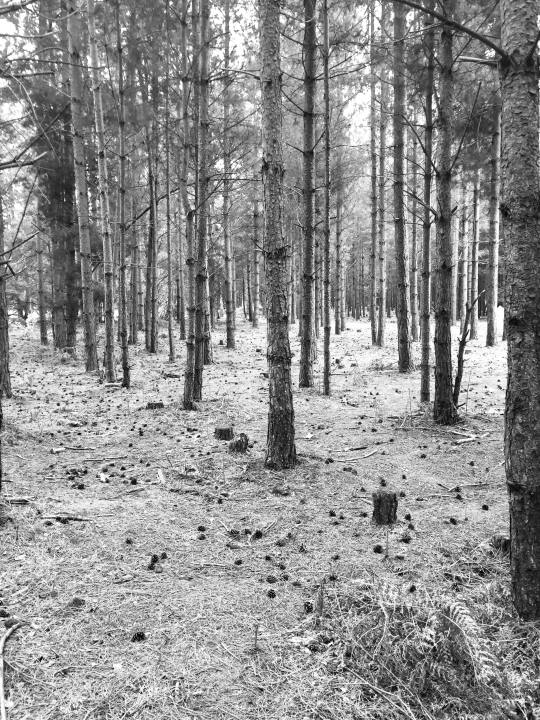
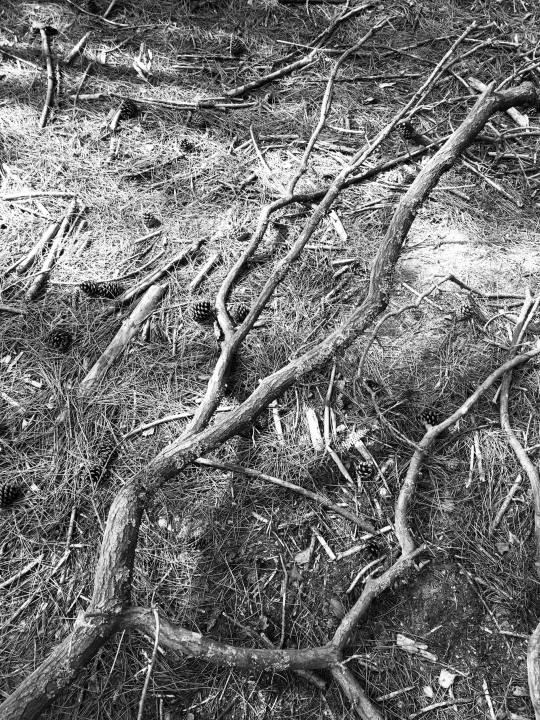
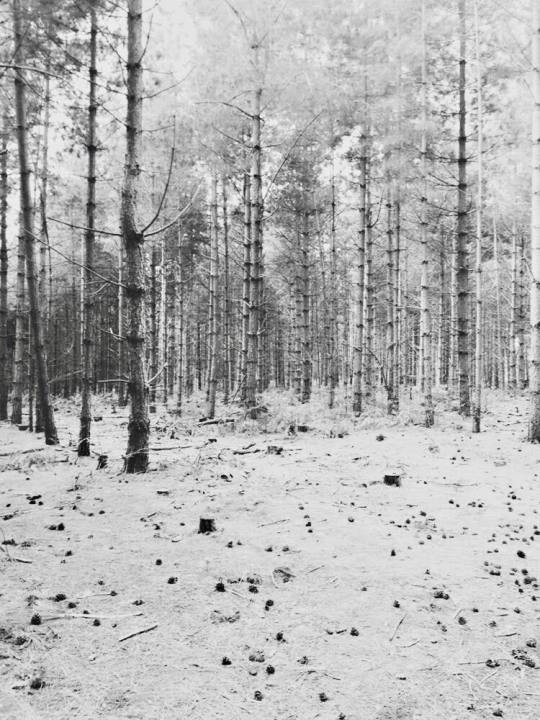
Second Location: Shingle Street
History- During WWII it was said that Nazi troops invaded the Suffolk coast and the coast of Shingle street was one of them. This theory arose when it was rumoured that British troops had set the suffolk sea coast “on fire” (an experiment carried out during WWI), which is when rumours of Nazi corpses washing up on shores started spreading through the media. The evacuation of Shingle street caused many to believe secret experiments were begin carried out on the beach, in particularly the row of white houses along the beach front are said to be secret labs for the British Military.
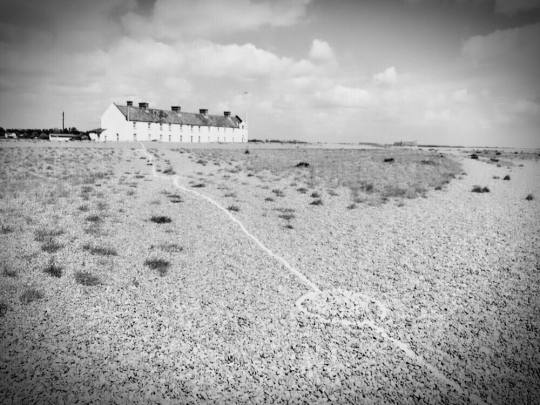

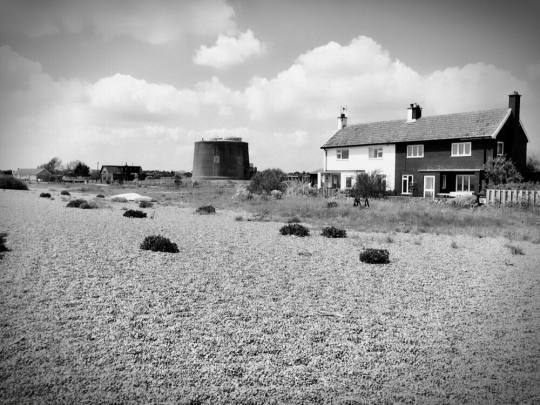
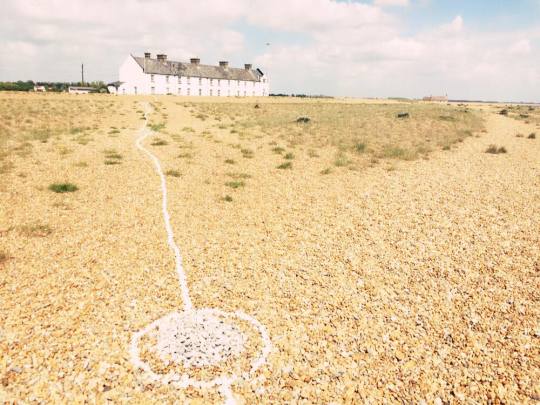
Although we didn’t find any dead Nazis, me and my peer did find strange trails with white shells from the white cottages to the sea, resembling ritual like markings. The beach was also empty and silent creating an uncomfortable silence. The white cottages stood out in juxtaposition against the military like bunkers that lined the beach which did lead us to theorise that they weren’t as innocent as they looked.
Reflection
This trip was a huge assistance with my project, I will mostly take inspiration from Rendalsham forrest due to my project being based around the Aokigahara forest, however, I will still be taking inspiration from Shingle Street due to its minimalistic atmosphere and compositions.
Actions
1. In response to my Cyanotype experiments, I want to attempt to create photo cyanotype images using these primary images.
2. Use this images to inspire me when designing my 3D model by looking at shape, form, colour and structure.
Sources:
Websites
Ipswich Star, Dead Nazis at Shingle Street? ‘Still bunkum’, http://www.ipswichstar.co.uk/news/dead-nazis-at-shingle-street-still-bunkum-1-4400113 accessed on 13.5.18
The Telegraph, Britain's Roswell: the truth behind the Rendlesham Forest UFO incident, https://www.telegraph.co.uk/culture/film/film-news/11415831/Rendlesham-Forest-UFO-incident-truth-conspiracies.html accessed on 13.5.18
1 note
·
View note
Text
Chemical Experiments
For this experiment, I will be using the chemical Cyanotype a photographic printing process that produces a cyan-blue print.
Artist
Anna Atkins (1799- 1871):
British botanist and, arguable, the first female photographer, Atkins was inspired by her father who was a scientist and after meeting photographer William Henry Fox Talbot and Sir John Herschel whom invented cyanotype. Atkins began to use cyanotype to print botanical illustrations and was later invited to join the Botanical Society in London in 1839, one of the few scientific societies which was open to women.
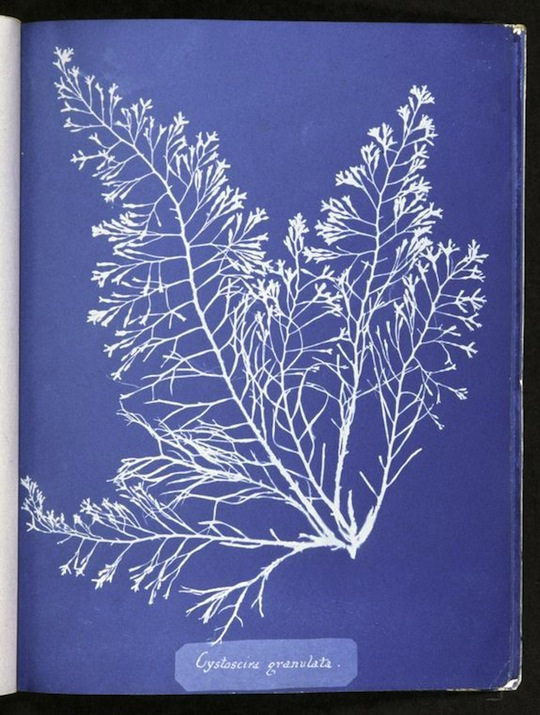
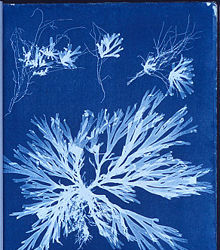
Atkins manages to create very translucent pieces and every detail no mater how thin can be seen in her work which is something I need to stride to create when creating my pieces.
The Process
To begin the process we first evenly spread the chemical across the paper before leaving it to dry in a dim area to avoid any UV exposure. Whilst waiting for it to dry I gathered leaves and trigs that will lay flat before placing them on the now dry Cyanotype paper.
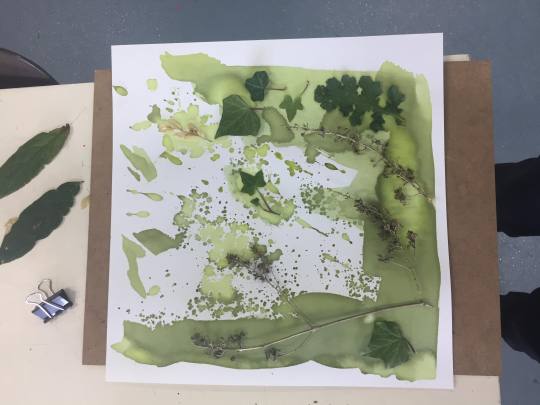
Placing the composition in a tight glass frame we then leave it for 15 minutes in direct sunlight where the exposed cyanotype will turn a dark green/ brown and the areas covered by the leaves and twigs will remain unaffected.

Afterwards we remove the twigs, leaves and frame before rinsing the work under a tap and placing it in bleach to change the composition to change it to a cyan blue silhouette. Click on Link below to see the process:
https://youtu.be/2k1f7VSasUg
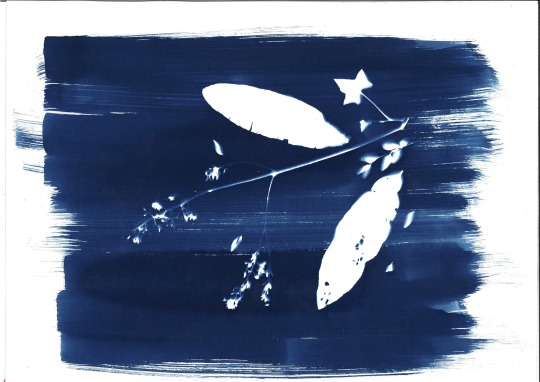
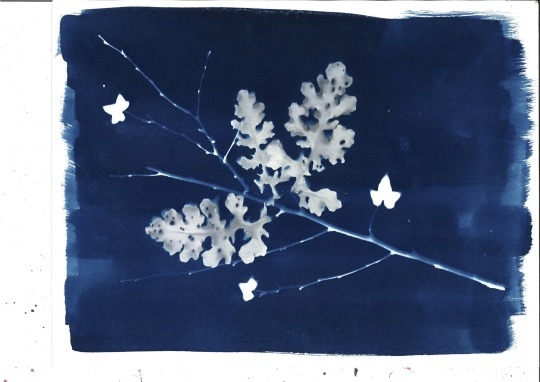
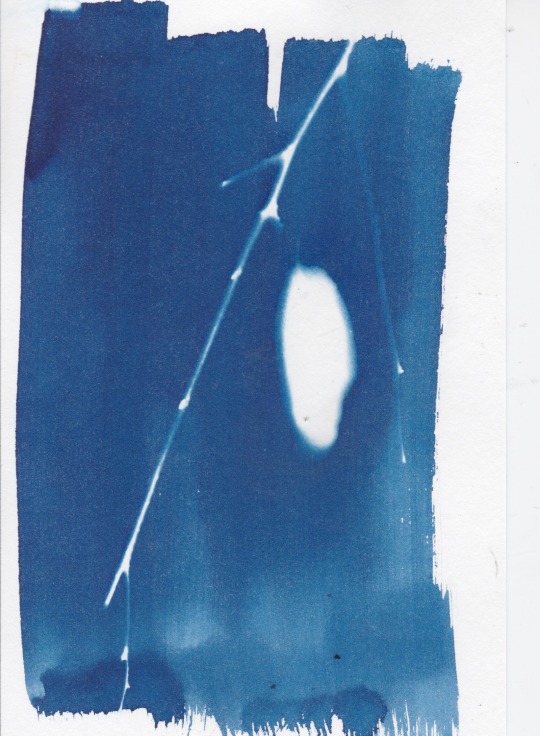

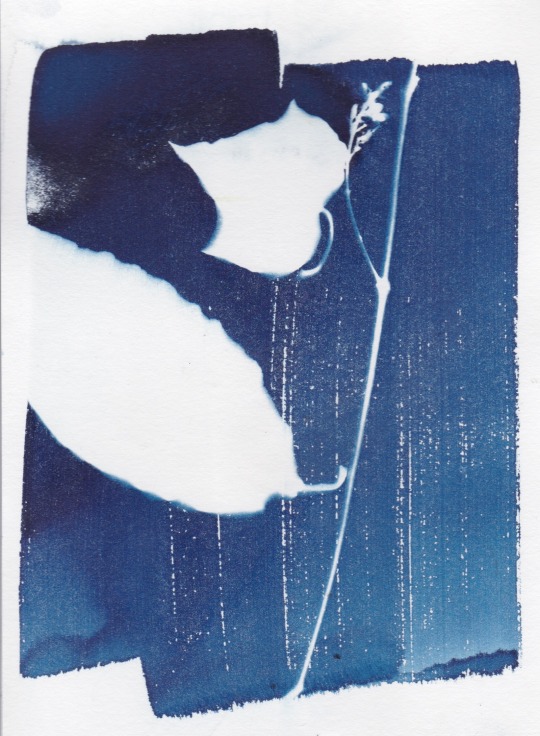

The result of this process created a beautiful blue and left a delicate silhouette of the nature I used. Overall it reminded me of the blue and white “delft” pottery you see in Holland due to the colour and nature related designs.
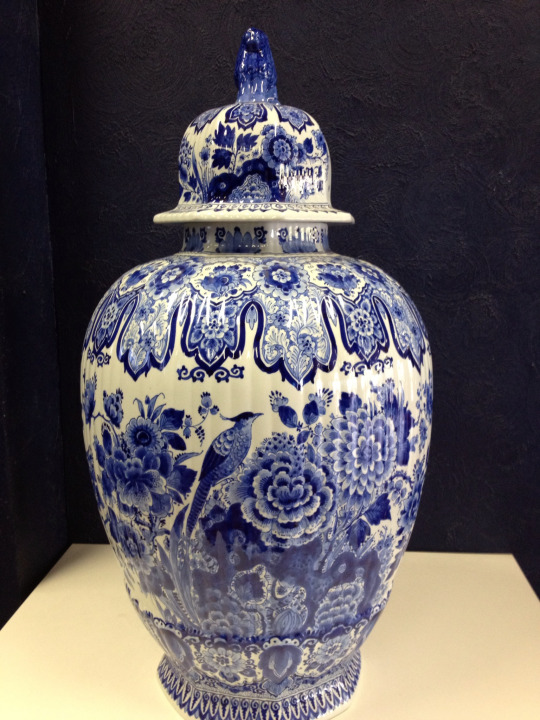
Above is a Delft pot from Holland. The colours are similar to that of the Cyanotype.
I then began to experiment with other ways of applying the cyanotype via splats and drips which created energetic and exciting pieces.
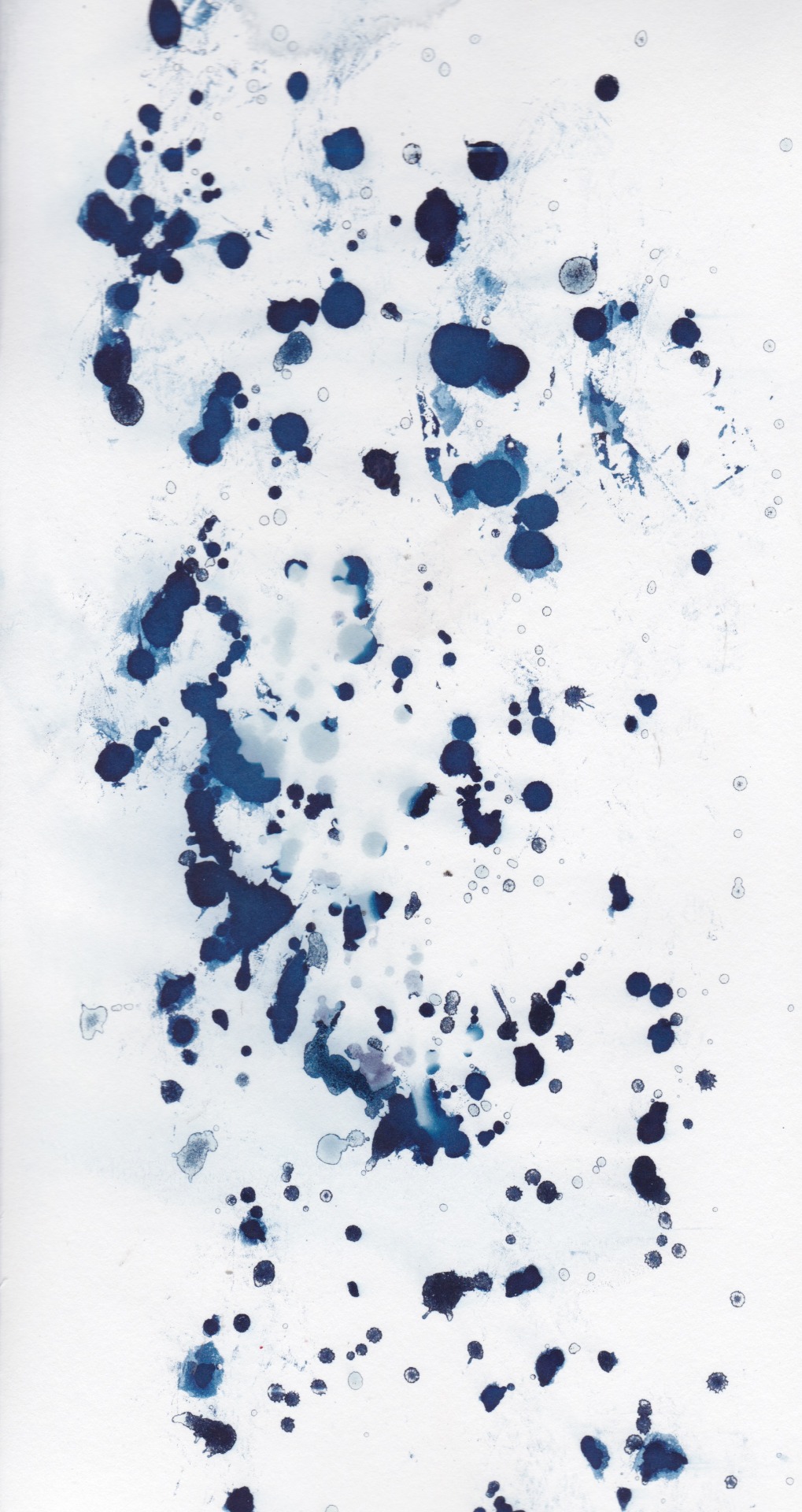
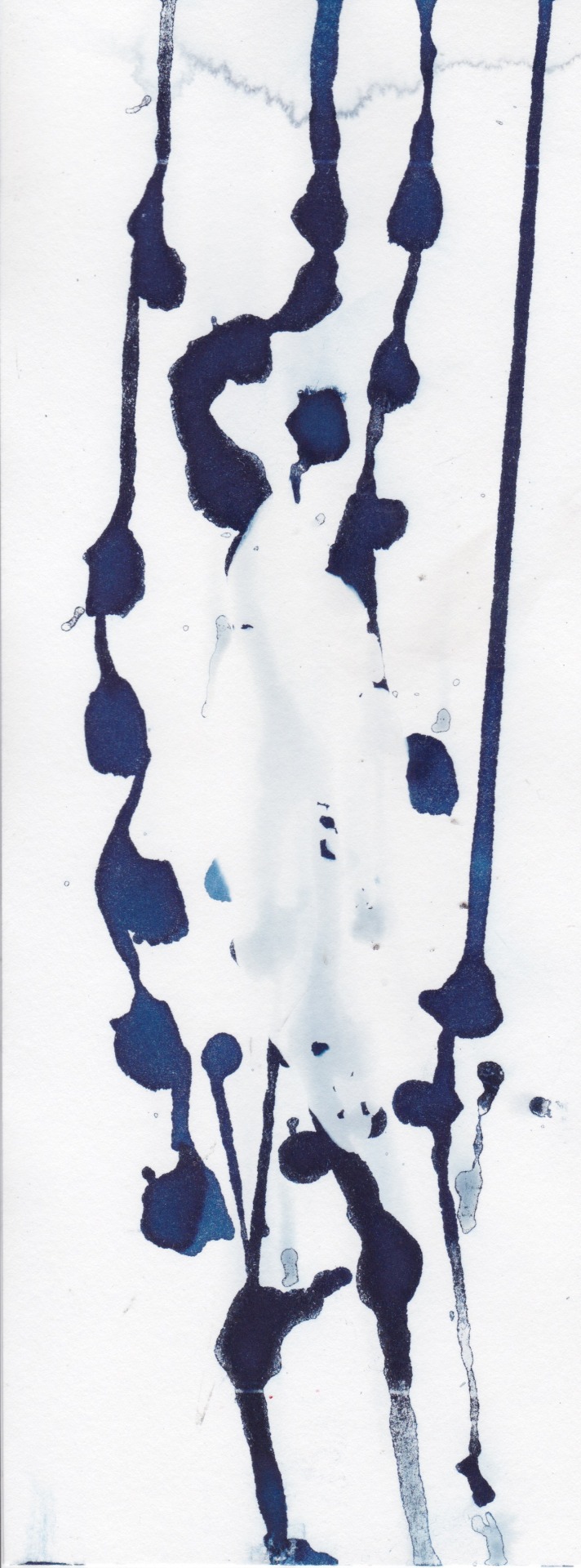


I loved the energy of these pieces and how well it compromised with the shapes of the nature items used in the silhouettes.
To develop this process further I began to experiment with using coffee to turn the blue black, and then using this method on different materials like tracing paper, newsprint, cardboard and fabric.

Material- Paper mixed with coffee to turn Cyanotype black.

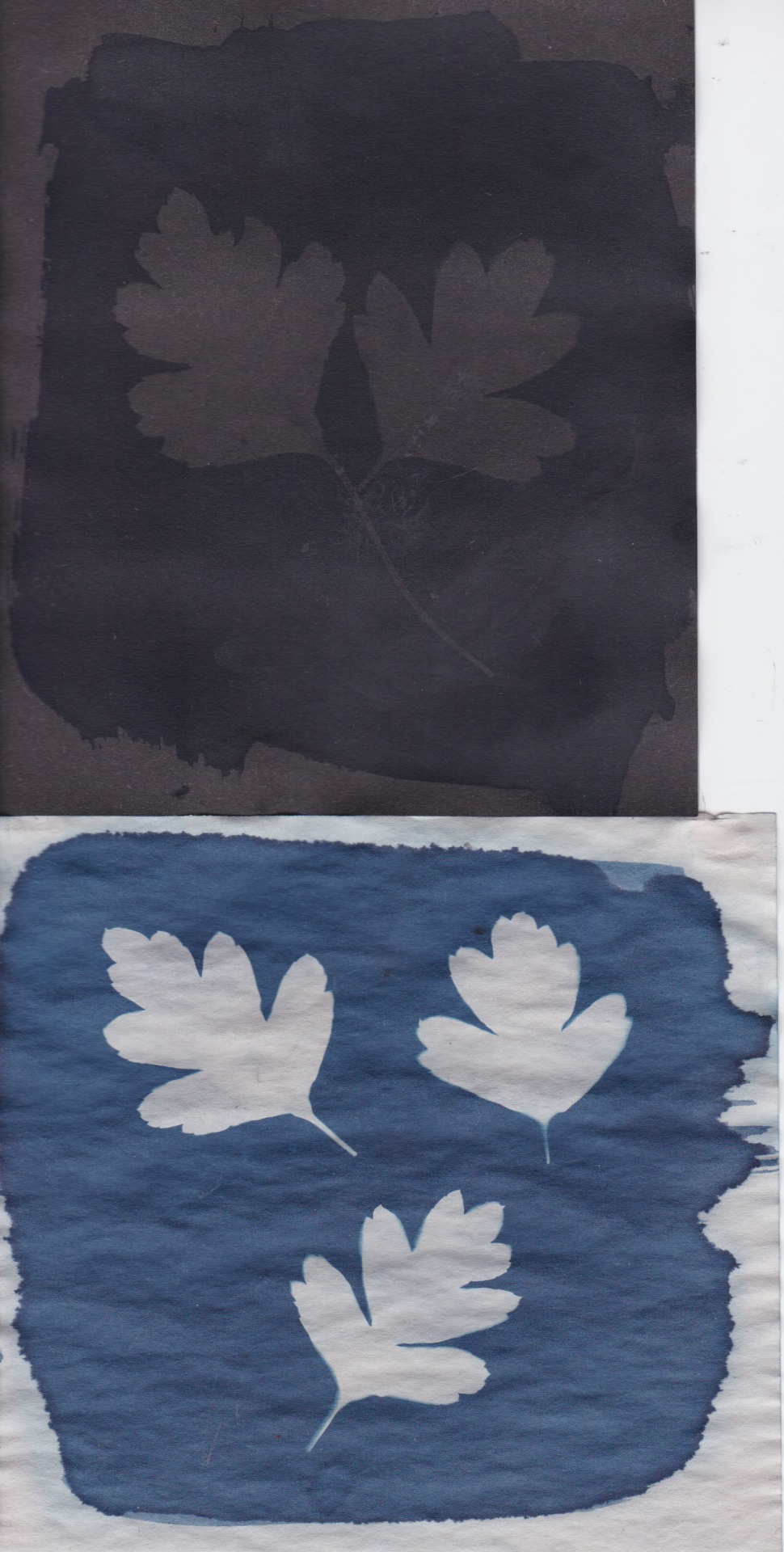
Newsprint and black sugar paper.
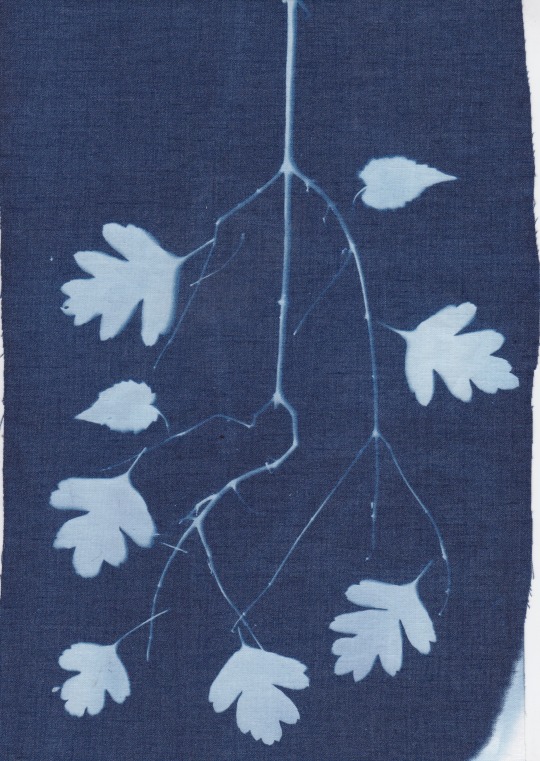
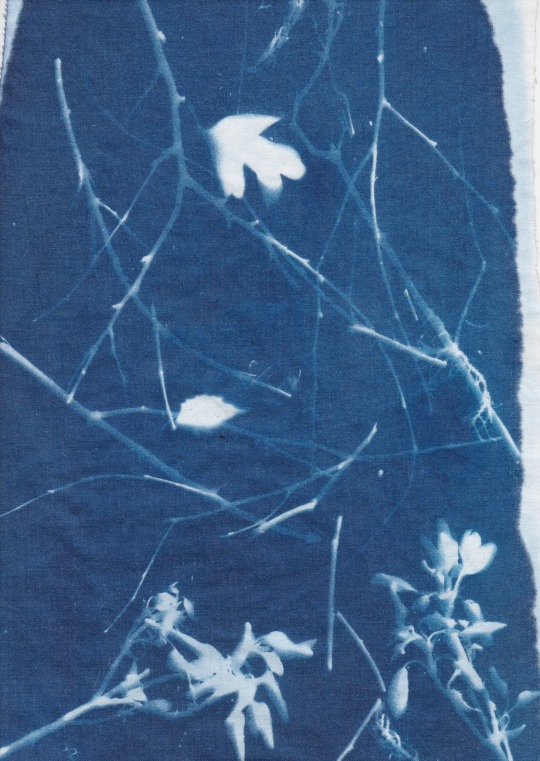
Cyanotype on fabric; this took longer to do as you had to wait for the fabric to completely dry before doing the UV stage. Apart from that it created the same effect as cyanotype on paper.
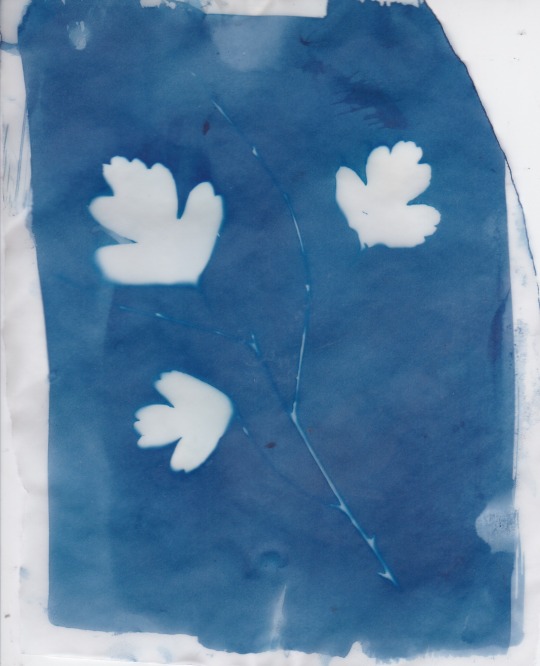
Cyanotype on tracing paper, creates a lighter blue than when its placed on other materials and was difficult to use as the tracing paper bumped and bent when wet and drying meaning it wouldn’t lie flat.
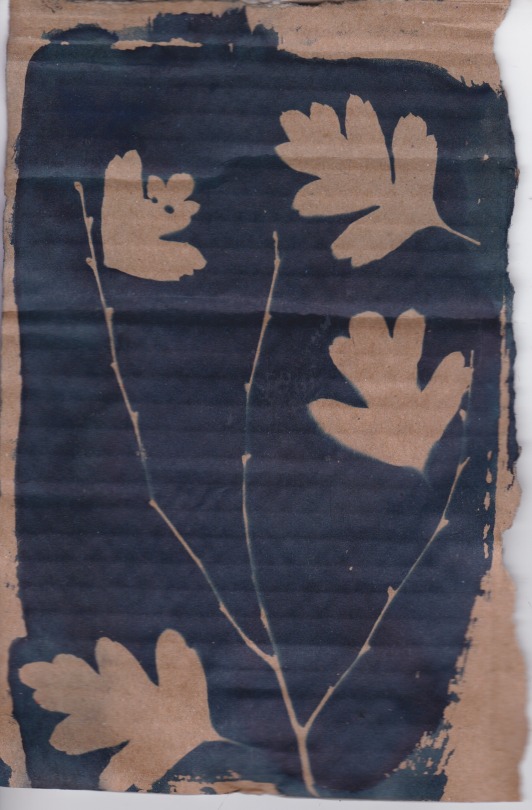
On cardboard it created a dark navy blue meaning I didn’t have to place it in a coffee bath to turn it black.


Coffee newsprint; because of how thin newsprint is this meant I had to be careful when placing it under the tap or leaving it for too long in the coffee as it would rip. However, the white areas of the newsprint turned brown which made it look old and contrasted nicely with the black.
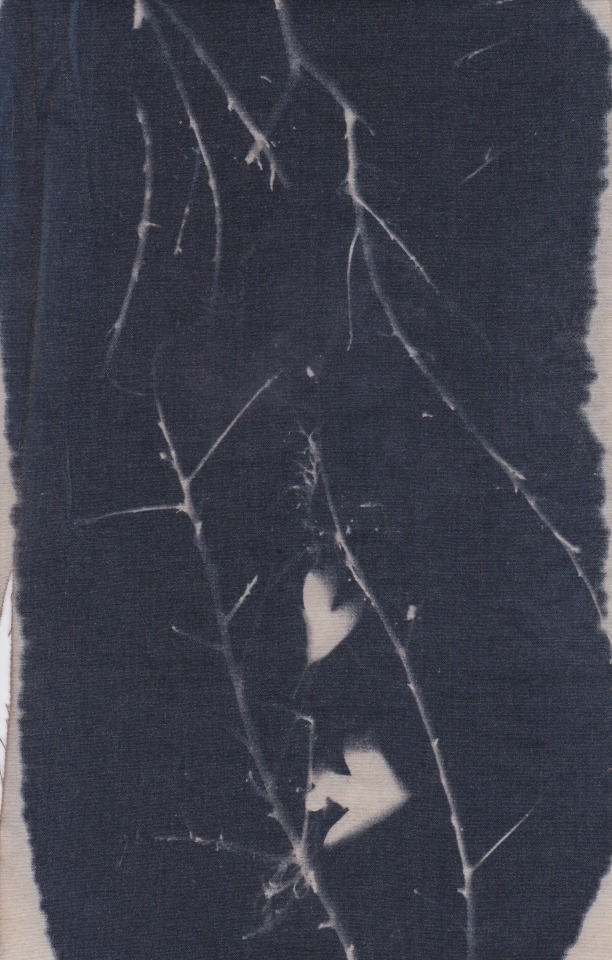
Coffee bath and fabric; this worked as well as paper and newsprint but in order for me to get a pitch black like with the other materials I would have to leave it in the coffee for far longer to really soak up the liquid as it was still slightly blue.
Reflection
As I am planning to create a 3D model for my final piece, I want to apply this process and perhaps create an outfit for my model. As much as I adore the cyan blue, the setting for my model will be in the forrest so I will be using the coffee to change the tone to black and perhaps I can apply tones of green to it. In comparison to Atkins work, I found mine weren’t as aesthetically pleasing due to the delicacy and evenness of her compositions. To solve this problem in the fate I should choose flatter botanicals as this will stop UV from reaching areas I want to be kept white.
Actions
1. Apply the shapes and silhouettes created by nature to my model designs
2. Begin to experiment with shapes and structures with these pieces to see how I could possibly use them to create a costume for my model
3. I know that this process can work with photographs so perhaps this is another process I can use.
Sources
Websites
The Public Domain Review, Cyanotypes of British Algae by Anna Atkins (1843), https://publicdomainreview.org/collections/cyanotypes-of-british-algae-by-anna-atkins-1843/ accessed on 13.5.18
0 notes
Text
“Abstract Aesthetics”
Brief
For this workshop we will be creating a variety of abstract, hand rendered, experiments which will test our knowledge of aesthetic composition.
Artists
Kazmir Malevich:
Russian artist from 1879-1935, is an abstract painter who uses geometric shapes in stark shapes to create modern compositions. Starting as a landscape and religious work, Malevich evolved his work into his distorted shapes and conceptual paintings.
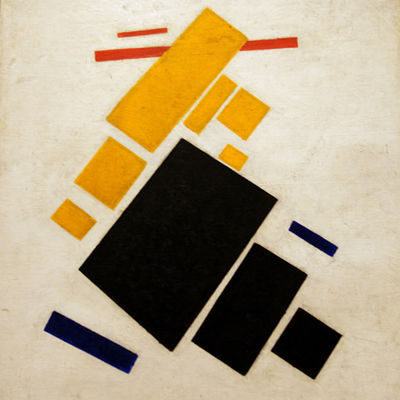
Sol LeWitt:
American artist from the 60′s, Sol LeWitt, was linked to numerous art movements with his abstract line wall drawings and his “structures” (sculptures) that were various 3D shapes with sections missing to create a new form.
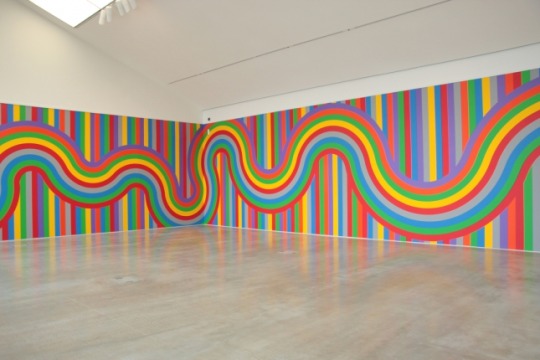
Eltono:
French street, graffiti artist. Eltono, creates bold murals of bright colours and structured shapes that slide and fit together to form an energetic composition.

When comparing all three of these artists, the use of structured shapes with sharp corners and edges is prominent. Each composition from these artists work uses the shapes in a way that does not create realistic form, which differs it from the art of the cubism movement. Although busy, the work isn’t over crowded and is minimalistic as they have embraced accident and chance yet still applied precision.
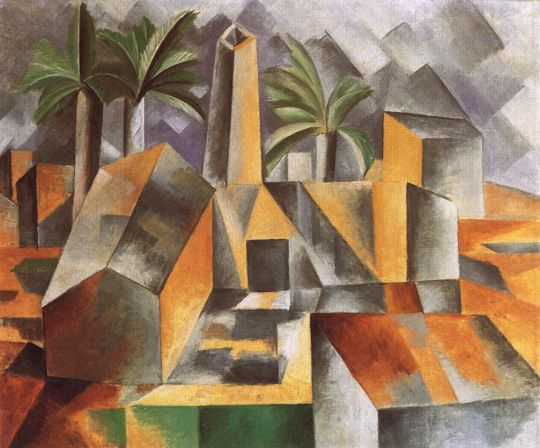
Above is the “Factory at Horta de Ebro” by Pablo Picasso. Cubism has more relation to form as you can see the structure of a building and trees unlike the work of these three artists whom creates work based on aesthetic composition.
Task 1:
Taking inspiration from these artists work we then began to experiment with our own.
Using white and black squares of paper we cut one o the colours into four equal strips before laying them onto the other to create a four series piece of abstract compositions of geometric patterns.
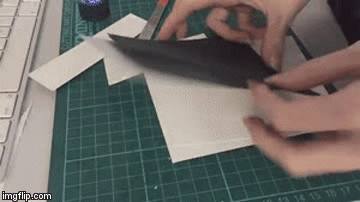
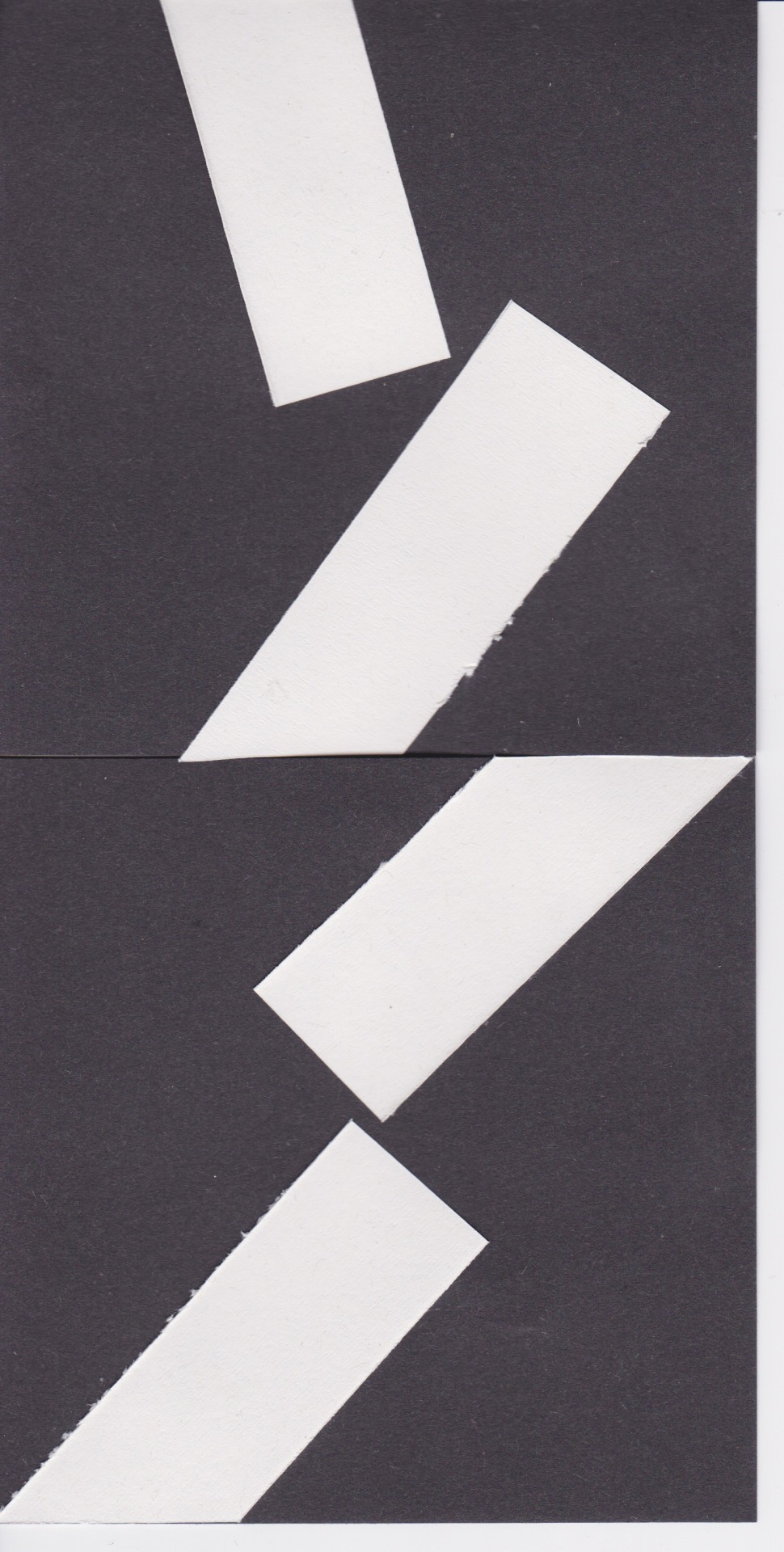

Deciding to create my work white on black, as it created a bold contrast to the usual black on white patterns you see. My first two designs are very similar to one another and aren’t as interesting as my last two as I felt more confident with using more strips to create more elaborate patterns.
Task 2:
Taking our first workshop into consideration we then used the same method of cutting out strips but instead of creating sharp and structured patterns we ripped the strips to create more organic shapes.



By ripping and resizing the strips of paper, this gave me more freedom when designing my abstract pieces. Keeping to my concept of white on black, I found this emphasised the tares in the paper and also created a texture that made my pieces interactive.
Task 3:
Using the same processes as above, we then cut the paper into very thin strips to create tight compositions with multiple lines.
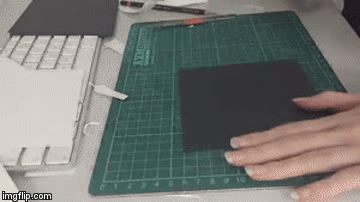

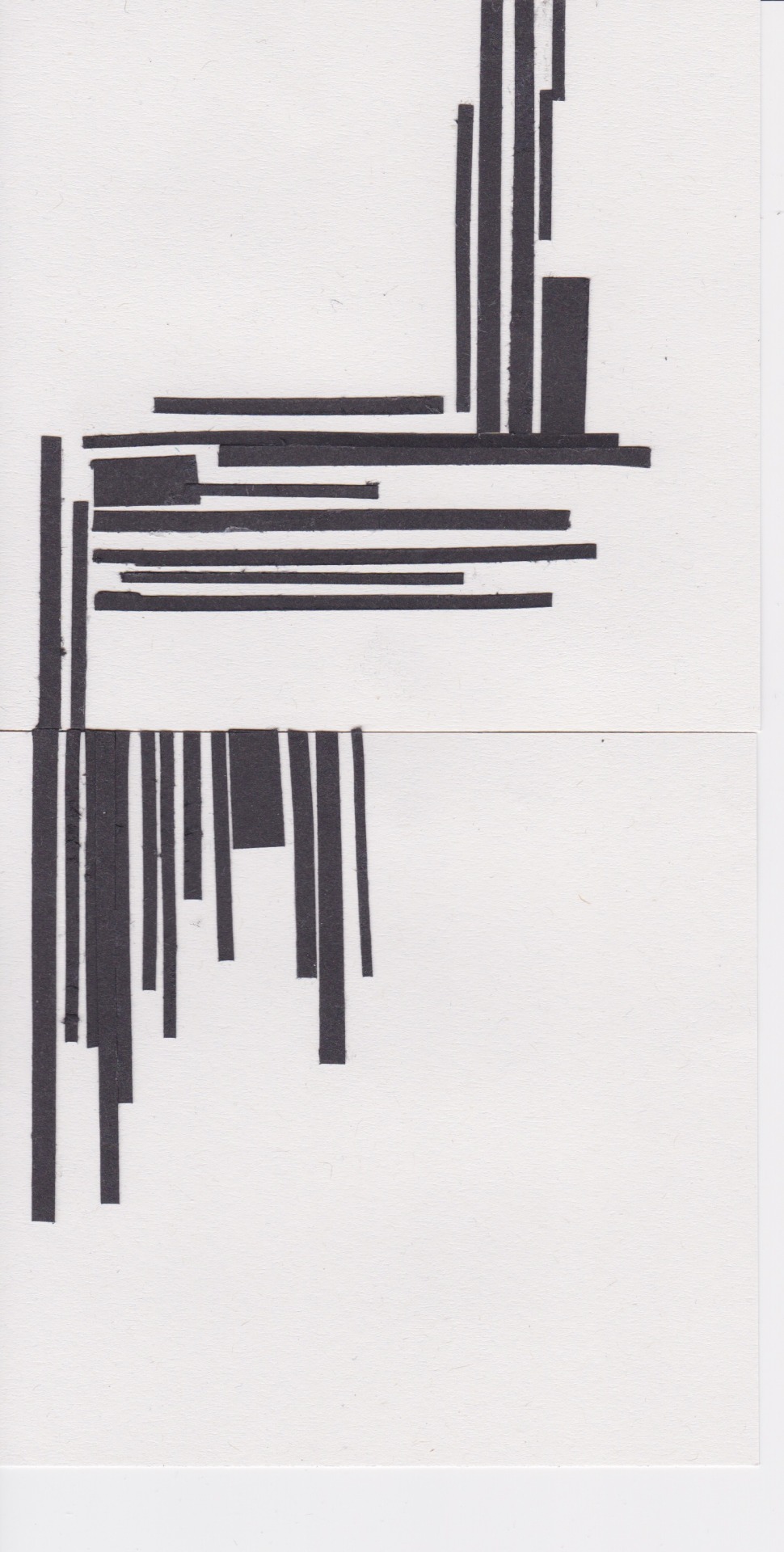
Deciding to change to black on white, I created a series of lined images that joined all 4 images together. The designs resembles the effect you get when you drip paint down a page but more geometric. Out of all three tasks this was my favourite due to the simplicity of the compositions and looked similar to the work by Sol LeWitt.
Group Showing

Placing my work next to my peers was an interesting process as we all had similar compositions yet took different approaches. As a whole, the work blends into each other and as a viewer its hard to choose a focus point. In terms of pattern it creates a geometric and abstract design that could easily be transferred to textiles or developed into character designs.
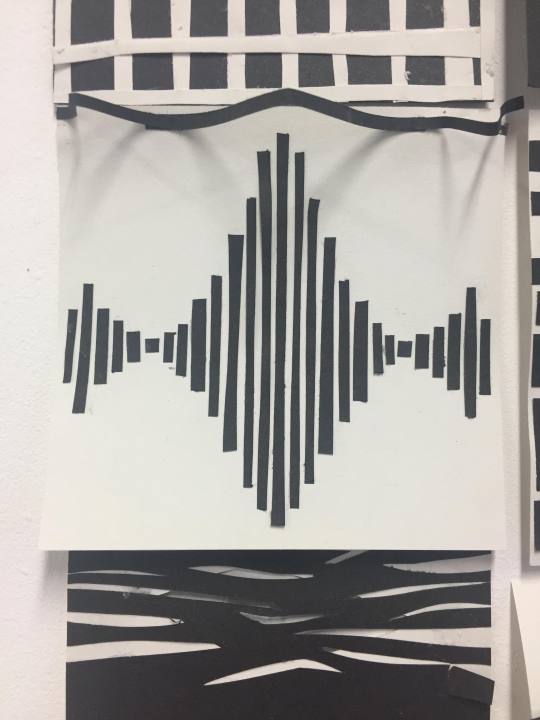
Comparing my work to that of my peers, image above, they had developed their work to mix 3D elements with 2D which was an interesting concept and has inspired me to explore more paper techniques in the future.
Reflection
Each task allowed me to experiment with abstract designs in a different concept from the geometric to the organic. I found my designs to be minimalistic and although looked planned and structured they were created spontaneously which shows that I rely on aesthetic instinct when working. My work didn’t differ from my peers but I don’t think anyones did, much like how every tree is different yet when there are hundreds they look the same. In fact the work I chose to compare my own to was chosen due to it’s similarities to my own.
Actions:
1. Explore paper processes like origami
2. Look for abstract patterns in nature and apply them to my own work.
Sources:
Websites
Tate, Malevich, http://www.tate.org.uk/whats-on/tate-modern/exhibition/malevich accessed on 10.5.18
Lisson Gallery, Sol LeWitt, https://www.lissongallery.com/artists/sol-lewitt accessed on 10.5.18
Eltono, Information, http://www.eltono.com/en/info/ accessed on 10.5.18
0 notes
Text
Dolls in the Supernatural
Whilst I was researching voodoo and witchcraft I found they had a common ground in the use of dolls.
Voodoo Dolls and Poppets:
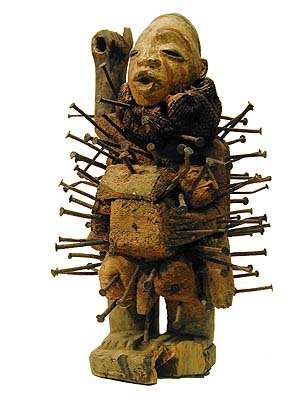
The use of voodoo dolls comes from Africa, they are dolls created by various materials and then struck by pins or needles in an attempt to harm the person it represents, however, it’s origins are unclear. Speculation about the use of voodoo dolls has been made false and most practicers have claimed that voodoo dolls were created as a way to scare superstitious slave owners by claiming they would curse them. In fact the use of voodoo dolls has been proven to be fake which has been emphasised in Hollywood media.

Poppets are also a doll used in a similar way to voodoo dolls, however they are not associated with the voodoo practice (poppets inspired the idea of voodoo dolls) and are more used via witches and wiccans. The term poppet comes from the Latin word girl or doll, and are used in a similar way to voodoo dolls for good and evil depending on the spell you want to cast on the victim. The spell also effects the materials to make the doll from, most are made from cloth but are filled with specific herds that cast the spell.

The fear of poppets and voodoo dolls had an effect on society in the 16th century, in Holland, dolls and even gingerbread men cut in the shapes of humans were banned as it was rumoured that they were being created in the image of others to be used in rituals and evil spells.
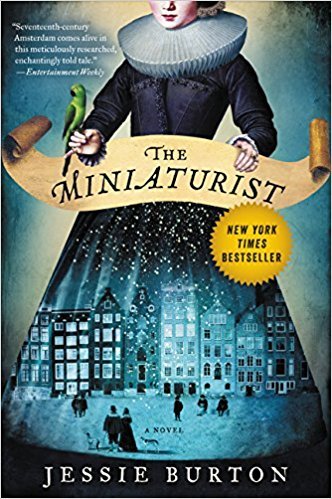
- This subject was explored in the fictional story “The Minimalist” by Jessie Burton who based the story on a the 17th century dolls house, owned by the rich Petronella Oortman of Amsterdam which is in the Rijksmuseum, which were given as gifts to wealthy ladies and girls during the 16th and 17th century.
Doll Island (Mexico) and other haunted destinations
In the south of Mexico, between the canals of Xochimico is the alleged haunted, Isla de las Munecas aka the Doll Island, home to hundreds of abandoned dolls, all hung up as a sign of respect to a girl who drowned near the island.
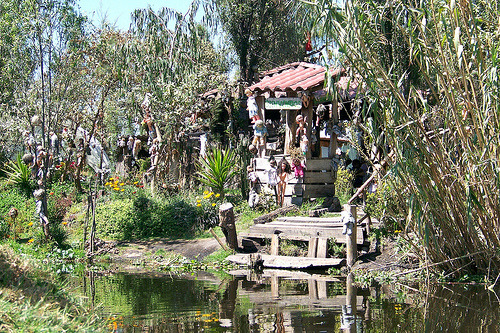
The caretaker of the island,Don Julian Santana Barrera, began the collection of washed up dolls and dolls parts after he witnessed the girls death and soon after found a doll floating in the canals a week later which he believed possessed the spirit of the doll. He was later found dead, drowned in the same spot the girl had supposably died.
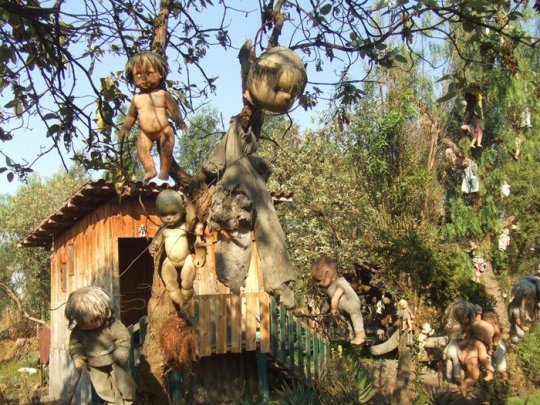
Locals claim the little girl possesses all the dolls on the island and claim their heads move and their eyes blink on their own. Although the intention’s of Julien were innocent, the destination has been labeled nightmarish and a tourist attraction for those interested in the supernatural.
Other unusual destinations
The Winchester house:
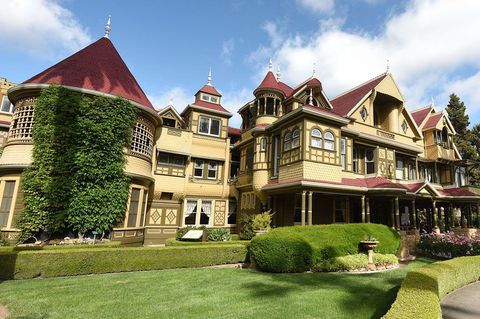
Sarah Lockwood Winchester, wife of gun magnet and invented of the the Winchester rifle (the gun that won the west) designed the California mansion in 1886. Before the construction of the mansion Winchester lost her father in law, her husband and her child in a short amount of time. After these events she saw a medium who told her that she was cursed by those killed by the rifle and that she must move west and build a house based on the directions the spirits give her.

The mansion had 500 rooms (though due to remodelling it now only has 160) and the design of the house is designed and built in haphazard fashion with staircases that lead into the ceiling, windows overlooking other rooms and doors on the top floor that lead straight to an outside drop.


Above are photos of the strange planning and structure inside the house such as the doors that lead to no where and the stairs that lead into the ceiling.
Theories surrounding the odd design of the maze like mansion span from Sarah suffering from arthritis, to her constantly changing her mind with building due to her distraught and depression after her families death, to trying to confuse the spirits that haunt her, however, there is no proof that she was ever interested in spiritualists.
Overtoun bridge:
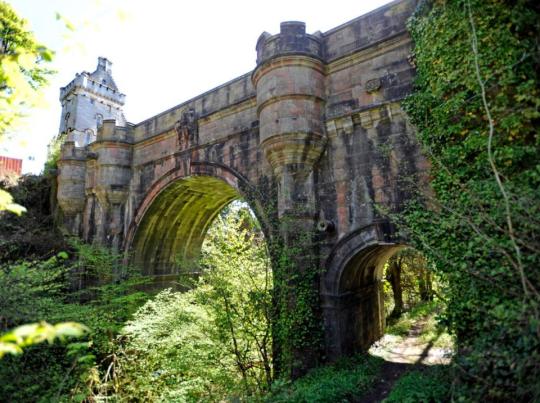
In Scotland theres a 19th century castle called Overtoun House which has been often used as a hospital, however, the supernatural activity goes on at the nearby Overtoun Bridge which was built in 1895. Since the 1950′s fifty dogs have leaped to their deaths and over 600 have jumped off the structure and survived. All the dogs that jumped were long-nosed breeds with an exceptional sense of smell and reportable jump from the same spot, always on a clear, sunny day.
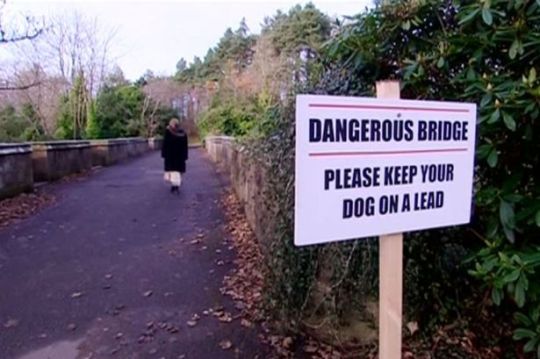
A scientist theorised that there is a strong scent of mink from under the bridge that only those types of dogs can smell on a dry sunny day making a final verdict of misadventure rather than suicide, however the theory still doesn’t explain why the dogs jump from the same spot on the bridge. There is a theory surrounding the Celtic belief of the “thin place” which is where heaven and earth are reputed to be close and as dogs are more sensitive than humans they are able to sense this supernatural force which they attempt to jump through to.
Haunted dolls
The supernatural if often linked to the bible, as it mentions demons and possession. However, when I asked whether demons can possess inanimate objects, such as dolls, there is no specific mention of this action in the bible yet there have been a number of reported possessed objects through the years, especially when it comes to dolls.
Annabelle: In the Horror movie franchise The Conjuring and Annabelle, the doll is made from china and (although has a very creepy appearance) resembles a little girl. However, the real doll is a raggedy Anne doll given to a girl named Donnie from her mother who found her in a hobby store.
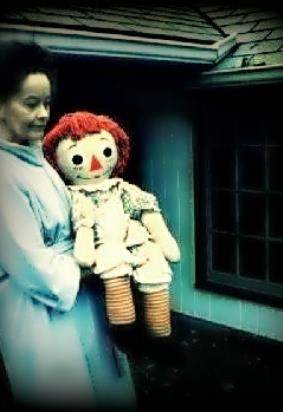
Lorraine Warren carrying Annabelle
Donnie lived in an apartment with her friends Angie and Lou and odd occurrences would begin to happen such as the doll moving on it’s own, messages being left and written on parchment paper in childish writing. Lou was a particular target for the doll and was injured by it on several occasions. The doll is now based in demonologists Ed and Lorraine Warrens Occult Museum in Monroe, Connecticut. There, the doll is locked in a glass case where it is blessed often by a priest.
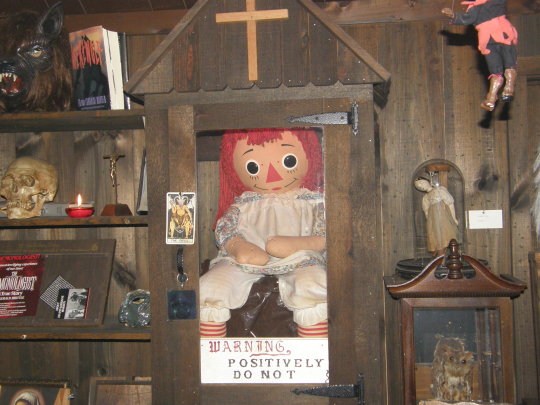
Annabelle in her cabinet
Okiku:

Brought in 1918 in Japan, by a 17 year old boy who gifted the doll to his younger 2 year old sister, Okiku, who loved the doll but the following year she died of a cold. The doll, now named Okiku after her owner, was resided to the Mannenji temple in the town of Iwamizawa (Hokkaido prefecture) since 1938 where the temple claims Okiku’s hair which when it first arrived was a bob, suddenly grew to 25cm reaching the dolls knees. Even with constant trimming the dolls hair continuously grows presenting the theory that the little girl who first owned the doll has now taken refuge inside the doll. Scientists have even proven that the hair is child’s hair.
Doll Artists
Enchanted Dolls made by Marina Bychkova

Canadian and Russian artist, Marina Bychkova creates handmade, articulated, porcelain dolls and decorates them with precious metals, gem stones, antique textiles and found objects. Her dolls take an average of 500 hours to make and she takes inspiration from Russian and Chinese Folklores which she creates costumes based on.
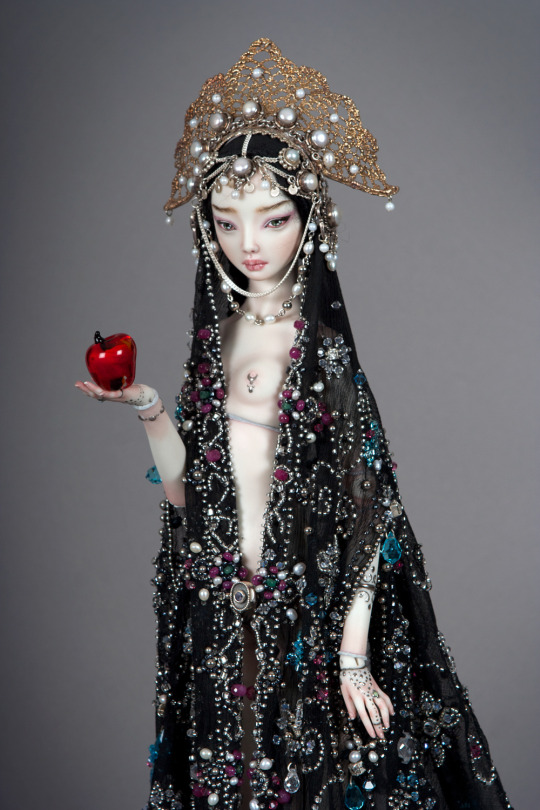
Unlike mainstream children's dolls, Bychkova’s dolls are dainty and realistic with simplistic facial features and detailed bodies. Her work resembles Jane Ray and Ivan Bilibin’s illustrations due to their fantasy element and the softness of their appearances. Some of her dolls even have elaborate tattoos carved into their bodies similar to the body art Ray incorporates into her dolls.
Azusa Chiyoda
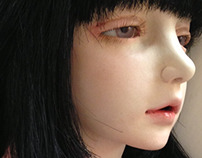
Tokyo based artist, Azusa Chiyoda creates realistic dolls from natural stone clay, “La Doll”, and layers of oil paint as well as bamboo spatula and carving knives. Taking inspiration from Japanese culture, Chiyoda dresses her dolls in kimono’s and some have elements of Japanese demons in their appearances like horns.
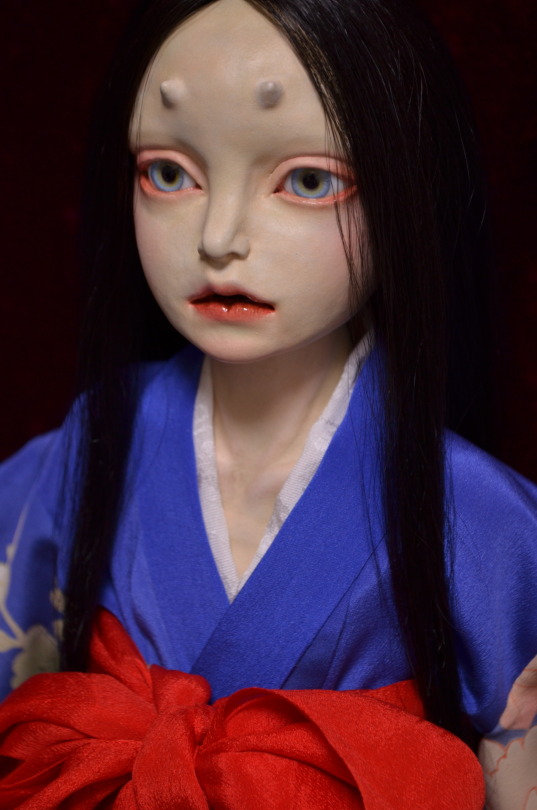
In comparison to Bychkova’s work, Chiyoda’s dolls aren’t as dainty maybe due to inspiration from Kokeshi Dolls, a traditional Japanese doll carved from wood with a round head and long cylinder body with no arms or legs. This is similar to the structure of Chiyoda’s dolls who have larger heads and rather straight bodies with little shape or curves.
Popovy Sisters

Russian, twin sisters, Ekaterina and Elena Popovy, handcraft hyperreal, posable dolls that combine elements of fantasy, fashion and fetish within their dolls designs. Having become inspired when they first received the popular Barbie doll, they became fascinated with the concept of making dolls clothing and changing Barbies hairstyles. Their first doll was created after visiting a doll exhibition which influenced them to take a class on how to make dolls.

In comparison to Bychkova’s work, Popovy dolls have similar body shapes that are delicate and model like, however they differ due to Popovy colliding their gentle yet exaggerated girl figures with complex, often aggressive predatory haute couture costumes and extravagant shoes with incredibly high heels. They also take more inspiration from catwalk fashion rather than just fantasy and folklore. There is elements of fantasy in their work but it’s presented in a more high fashion way that looks similar to clothing by Alexander McQueen.
Alexander McQueen (Fashion Designer)
London based fashion designer, Alexander McQueen, designed his fashion, taking elements from nature, the supernatural, culture, history and folklore to create bold shapes and structures in his clothing and wasn’t afraid to take references from body modifications to create new silhouettes.
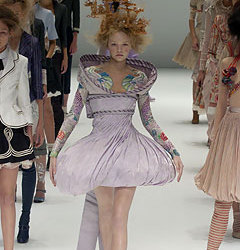
He has an ability to take grotesque subjects, like his collection “Highland Rape”, and turn it into something beautiful like artist Damien Hirst who uses butterflies to create patterns in a similar way to McQueen.

Damien Hirst’s butterfly work
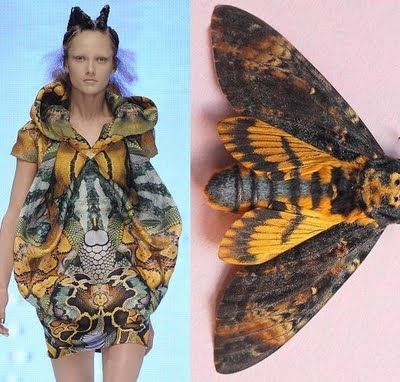
Like the Popovy sisters fashion, McQueen’s clothing is definitely style over function as he uses materials like shells or wood to create his fashion which adds elements of nature within his work.
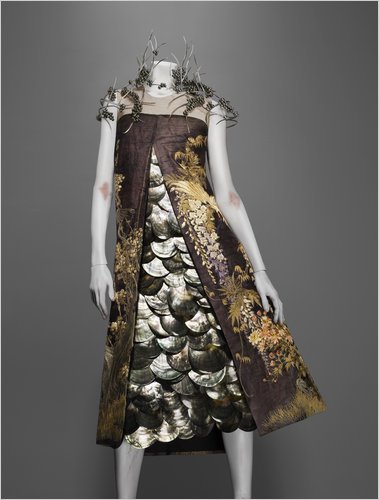
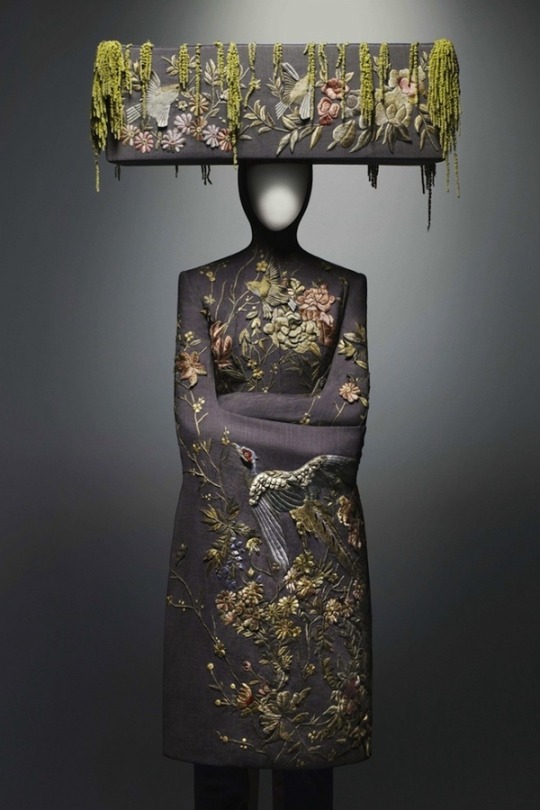
He also includes work of a more gothic atmosphere with his edgy and sharp cuts and references to subversive themes that are violent.
3D stop motion
Because I am exploring dolls I want to look at to use of 3D stop motion which will convert 3D models in 4D. Stop motion is an animation process where you manipulate an object between each frame to make it appear moving.
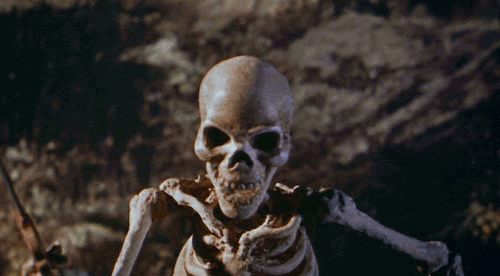
Ray Harryhausen an American, motion pictures special effects artist began to experiment with stop motion at a young age when he saw 1933 King Kong movie created by Willis H. O’Brian. Working in mostly plasticine, which is a movable coloured clay, Harryhausen’s most notable work appears in 1963 movie Jason and the Argonauts and 1981 film Clash of the Titans.
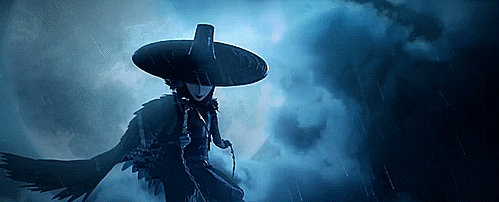
Harryhausen has inspired the work of millions of stop motion directors, including Travis Knight, an american director who worked on films like 2012 ParaNorman and 2016 Kubo and the Two Strings. Kubo and the Two Strings is based in Japan and takes inspiration from the cultures mythology and traditional art and clothing such as origami. ParaNorman also explores supernatural themes like ghosts and witches which relates back to my themes.
In comparison to Harryhausen’s work Knight uses 3D models with a wide range of facial expressions to swap to for each frame which although lengthens the process, allows the models to be more detailed in appearance and able to stay in form more easily.

This way of working is similar to the stop motion style used in Californian movie director, Tim Burton’s movies. Burton creates work in surreal and nightmarish fashion such as the Corpse Bride and the Nightmare Before Christmas that included halloween like characters and surreal storylines.
Reflection
3D is a process I want to explore and I feel dolls would be a good way to represent my themes of witchcraft and ghosts. I can develop this 3D model into 3D stop motion to create a horror animation similar to Burton and Knight. In terms of designing my model I need to establish what it is I want to create and begin to find elements that I want to incorporate in my design and create a series of concept designs for it taking inspiration from the doll artists I researched and McQueens work.
Actions:
1. Begin the process of designing my forest spirit, making notes of any influences and also write a biography for that spirit.
2. Begin to explore materials I could potentially use to create my model from
3. Think about form in nature and how this may influence my designs.
Sources
Websites
Typepad, A brief history of Voodoo Dolls, http://voodoodolls.typepad.com/voodoo_dolls/2007/04/a_brief_history.html accessed on 5.5.18
Live Science, Voodoo: Facts About a Misunderstood Religion, https://www.livescience.com/40803-voodoo-facts.html accessed on 5.5.18
Everything Under the Moon, All About Poppets~ (Voodoo Dolls), http://www.everythingunderthemoon.net/spells/all-about-poppets.htm accessed on 4.5.18
OXJane, Jessie Burton Is A Debut Author To Watch, https://www.xojane.com/entertainment/jessie-burton-is-a-debut-author-to-watch accessed on 4.5.18
Isla de las Muñecas (Island of the Dolls) in Mexico, About, http://www.isladelasmunecas.com accessed on 5.5.18
OMG Facts, The Mystery Of Scotland’s Dog Suicide Bridge, http://omgfacts.com/the-mystery-of-scotlands-dog-suicide-bridge/ accessed on 6.5.18
Daily Mail, Why have so many dogs leapt to their deaths from Overtoun Bridge?http://www.dailymail.co.uk/news/article-411038/Why-dogs-leapt-deaths-Overtoun-Bridge.html accessed on 6.5.18
Country Living, The Bizarre History of California's Winchester Mystery House, https://www.countryliving.com/life/travel/a45210/winchester-mystery-house/ accessed on 4.5.18
Thought Catalog, 7 Famously Haunted Dolls That Will Ruin Your Life, https://thoughtcatalog.com/christine-stockton/2014/08/famously-haunted-dolls-that-will-ruin-your-life/5/ accessed on 6.5.18
Warrens, Annabelle, http://www.warrens.net/annabelle/ accessed on 6.5.18
Vogue, 10 Questions for the Popovy Sisters, Identical Twin Doll-Makers From Russia With Some Serious Fashion Cred,https://www.vogue.com/article/global-100-popovy-sisters-doll-makers-from-russia accessed on 6.5.18
IMDb, Tim Burton, https://www.imdb.com/name/nm0000318/bio?ref_=nm_ov_bio_sm accessed on 6.5.18
IMDb, Ray Harryhausen, https://www.imdb.com/name/nm0366063/ accessed on 6.5.18
IMDb, Travis Knight, https://www.imdb.com/name/nm1325899/?ref_=nv_sr_1 accessed on 6.5.18
Videos
INSIDER (2017), Creepy But Realistic Japanese Dolls, https://www.youtube.com/watch?v=woDOtbYYqhM accessed on 6.5.18
OhMore Story (2018), Enchanted Dolls by Marina Byckova, https://www.youtube.com/watch?v=TJLknO23cpM accessed on 6.5.18
Books
Wilcox C., 2015, Alexander McQueen, London
0 notes
Text
Hylophobia Response:
In this blog post, I will be responding to the research I did on Hylophobia and it’s connection to witchcraft.
Developing from my comic panels and exploring work done by Jamie Hewlett, I went down to the local woods in my area and drew observational drawings of trees using a fineliner.


Following Hewlett’s drawing style of creating the rough texture of the tree trucks via repeated patterns and mark making. By doing this my drawings are given more definition and look more 3D. The overall look of these trees is illustrative and they have a fantasy element to them due to the graphic hand rendered approach.
Dry Point

In the past I have used Dry-point print as a method of illustration due to its raw hand rendered results. Starting by etching my observational drawings of trees into the silicone, I then inked the plate which resulted in the image below. The overall composition is interesting and I’m pleased that this method has picked up the detail of the trees texture. The appearance is very mystical and creepy and I feel the dry point printing process has given it an atmosphere of mystery. Even the marks made by left over ink on the palette has given it a fog like texture.

Satisfied with the results I then began to experiment with them to see what outcomes could be developed. I first copied the image onto black sugar paper and then poured bleach over the image which chemically reacted with the paper turning it white but it didn’t react to the printing marks which allowed the detail to be seen easily. This method created tone in my work and also created a nice contrast to the rawness of the dry-point and the looseness of the bleach effect.
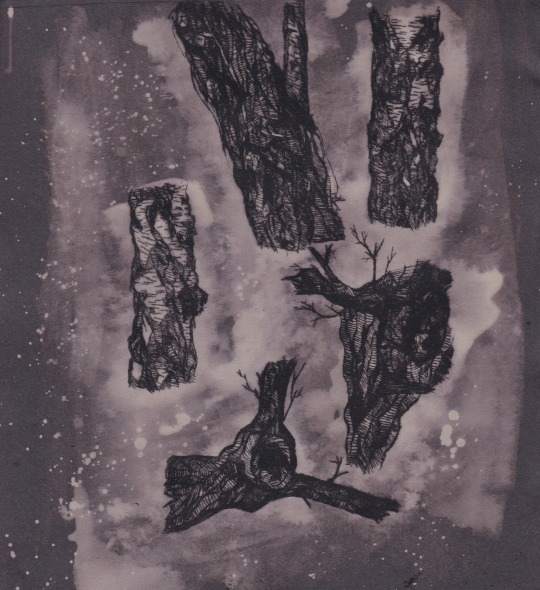
Animation
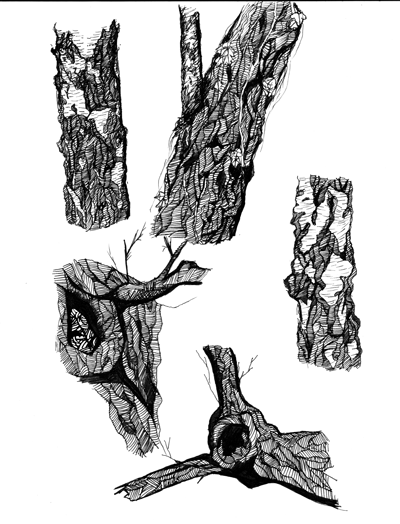
Taking inspiration from our Avatar artist, Lilli Carre, I decided to develop my observational drawings into a 2D animated gif. Looking at the shapes of the trees I imagined the circular patterns to open up like eyes and found that eyes have a common relationship to witchcraft and spiritual practice (e.g. the third eye).
Any problems?
I decided to use the 2D drawing, animation method to contrast with the hand rendered drawing style of the trees which was a slow process and I found difficulty in lining up each frame due to the amount of detail in the texture. This can be seen with the tree in the right hand corner which isn’t as sharp and clean as the one above it, however, I find this shows individuality as it gives them different personalities. With the drypoint, I struggled due to my lack of understanding of tools and processes but after producing these outcomes I now feel more experienced in this field.
Will I use these methods in the future of this project?
I found my gif to be successful as it’s very illustrative and also creates a fantasy like atmosphere. It also allows me to create more hand rendered work that I can develop into 4D work. My drypoint created illustrative designs as well and I wouldn’t mind converting it also into a 4D design but that would take time to etch out each frame so for this project that is highly unlikely. I would like to attempt to create some more witch inspired work so I should look into how witches and witchcraft has been recorded in art through history.
Response to Hylophobia:
Whilst reading about forests and their connection to witchcraft, I came across the Aokigahara forest in Japan, just North of Mt. Fuji, also known as the sea of trees due to its thick forage and is one of the highest recorded places for people to commit suicide in.

Above is a photo of said forest, as you can see its very dense and green and as it is 35km squared in size, many become easily lost if they stray from the path.
Japan has always had a relationship with suicide and mental health and has one of the highest recorded suicide rates in the world particularly with men. That being said, it is peculiar that many Japanese citizens choose to travel miles away from their homes to commit suicide in this specific forest.

Sitting at the base of Mt. Fuji, the forest was chosen as a setting in 1960′s tragic romance novel Kuroi Jukai by Seichō Matsumoto for the main character to commit suicide. This seemed to start a sinister trend in Japanese culture and was also dubbed as the “perfect place to die” in the 1993 novel The Complete Suicide Manual by Wataru Tsurumi; the book is commonly found with suicide victims in the forest. The novel was written to describe the stress of living in Japanese society due to the pressure of working, isolation and lack of support for those suffering from depression.
However, before the novel was published, the Japanese were known for performing honourable suicides, like when Samurai’s would commit “seppuku” or kamikaze pilots. In terms of religion, Christianity didn’t have too much of a big effect on Japanese culture so suicide was never seen as a sin but a more honourable death as many see it as a way of taking responsibility. Euthanasia was also a common practice (although some believe this is just a folklore) which is where families would abandon their elderly women. Some also believe this might be the reason the forest is haunted with yurei, vengeful spirits and ghosts who lure saddened victims to their deaths. This believe was explored in the 2016 movie The Forest by Jason Zada.

The movie plays on themes and symbols of the forest, such as the use of tents and ribbon trails which visitors leave when unsure if they want to commit suicide.
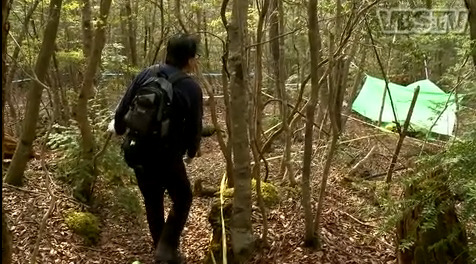
Japans Relationship with Nature
In the industrial cities of Tokyo, nature is hard to find as every inch of land is covered in concrete and has a modern building built on top of it. That being said, Japan has always had a harmonious relationship with nature as it plays a major role in their religion and landscape. Although technology has drifted them away from nature, they still protect and engage in it with activities such as forest bathing which is where you actively immerse yourself in a forest environment as it is proven to lower heart rate and blood pressure to relax you and release positive hormones. Nature is also continuously presented in traditional Japanese art, textiles and even architecture.
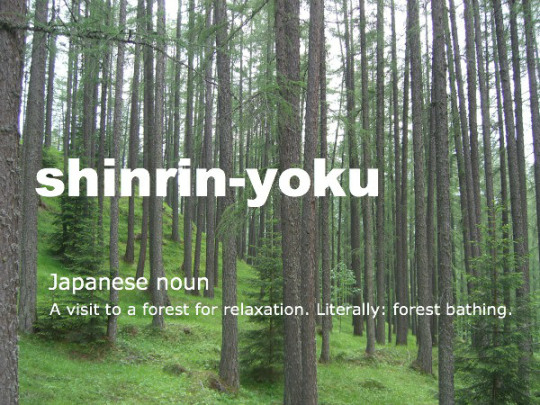
Japan’s relationship with mental health:
Up until the 90′s, Mental health in Japan wasn’t heard of outside of Psychiatric circles and depression was considered a physical condition rather than a mental one. Even today with the increase of mental health awareness in Japan, mental health is still not discussed and men are of high risk of suicide due to pressures of work and loneliness.

Menhara-chan designed by artist Bisuko
Yami Kawai (translates to sickly cute in english) is a��Harajuku street style subculture from Japan promoting mental health awareness within their clothing and motifs. The Harajuku clothing style is very popular in Japan due to its use of bright childlike clothing and over use of accessaries and Yami Kawai dresses in a similar way mainly with the colour scheme of black and pastel pink. Their clothes are also covered in motifs that reference suicide and depressed feelings. The mascot of the subculture, Menhera-Chan designed by artist Bisuko created the character to be a stereotypical cute anime girl with undertones of suicide and self harm references in her design.
Yurei

A yurei’s appearance often differs depending on the circumstances on their death but they appear much like they did in their human life, retaining the features and the clothing they wore when they died or were buried, in most cases, white burial kimono’s or uniforms of fallen warriors. They also sometimes wear a white triangle on their head but this isn’t a very popular perception anymore. Occasionally they have bloody wounds indicative of the way they died and their hair is usually long if they are female. They are translucent and only very faintly visible, and in most cases they are so faint that they appear to have no feet.
They only haunt one particular place or person. In the case of a place it is often where they died or are buried and in the case of a person it is often their killer, or sometimes their loved ones. Yūrei only exist to haunt, and they remain “stuck” in this world until they can be put to rest. Some yūrei are so reluctant to accept their deaths that they haunt their living family, bringing misfortune and unhappiness for the rest of their family members’ lives.

Above is an interpretation from the 2002 Japanese horror film Ju-on; The Grudge, of a yurei.
Japanese spirits and supernatural creatures
List of potential Japanese spirits to explore:
Abura-akago – An infant ghost who licks the oil out of andon lamps.
Akateko – A red hand dangling out of a tree.
Arikura-no-baba – An old woman with magical powers.
Datsue-ba – An old woman in the Underworld who removes clothes (or skin if unclothed) of the dead.
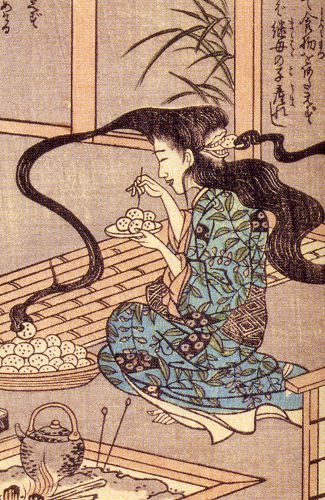
(Above)Futakuchi-onna – The two-mouthed woman.

(Above)Gashadokuro – A giant skeleton that is the spirit of the unburied dead. Also known as Gaikotsu.
Hanako-san – A spirit of a young World War II–era girl who haunts school restrooms.

(Above)Hannya – A noh mask representing a jealous female demon.
Hyakki Yakō – The demons night parade.
Jikininki – Ghosts that eats human corpses.
Jorōgumo – A spider-woman.
Jubokko – A vampiric tree.
Kodama – A spirit that lives in a tree.
Kubikajiri – Female corpse-chewing graveyard spirit.

(Above)Kuchisake-onna – The slit-mouthed woman.
Oiwa – The ghost of a woman with a distorted face who was murdered by her husband.
Onryō – A vengeful ghost formed from powerful feelings like rage or sorrow.


(1st picture is a representation of the creature, second image is a monster from movie Pan’s Labyrinth that’s appearance is similar to the first)Te-no-me – A ghost of a blind man with his eyes on his hands.


(Accurate representation above and a scene from 2005 film Memoirs of a Geisha. In this scene, the main character performs a dance that tells the story of a woman who suspects her husband of infidelity and waits outside in the snow to catch her husband leaving his mistress; unfortunately a blizzard sweeps over the land and she succumbs to the elements.) Yuki-onna- A ghostly woman who appears in snowfall.
Yama Uba/ mountain witch- an old crone who lives and hunts in the mountains and eats anyone who is unfortunate enough to cross her path.
Whilst exploring Japanese folklores and mythical creatures, I found many of them were represented as female. Unlike witches from European folklores, Japan doesn’t really have witches. They do have female Priestess’s/ shamans in the Shinto religion and Japans first ruler was a female shaman called Himiko.
What can I take away from this?
I was hoping to find some form of ghost related to suicide/ sorrow/ nature but sadly I didn’t find this. The reason I wanted to find some kind of forrest creature was so I could relate it back to the Aokigahara forest, but I only found different types of ghosts and spirits, none relating back to nature. However, I can look at this as an opportunity to use elements from Japanese spirits appearance and mix it with nature.
Artists who have explored Japanese Folklore and Mythology
Junji Ito
Japanese horror mangakas, Junji Ito, writes and illustrates short surreal, horror and gory comics with intricate panels and designs.

Inspired by the works of Kazuo Umezo, author of the violent and disturbing “God’s left hand, Devils Right”, and Koga Shinichi, whose work centres around Satanic worship and morbid depictions of the occults, Ito eventually developed his own unique style of writing and drawing of “in-escapable horror” (meaning the characters in his stories encounter entities completely by chance).


Ito’s work explores the manipulation and degradation of the human body, often distorting and deforming the form to become a mutated malevolent force. Working in pen and ink, the composition of his panels creates suspense with the use of the “page turn” where the last panel on a page is used as a cliff hanger so to warn the viewer that there will be something truly terrifying on the next.

He also explores the use of composition by arranging his characters in a specific manner. Like the above image, if you used the rule of thirds you can see that the main character, the one the audience are being forced to look at, is in the centre of the shot. However, she is smaller than the surrounding characters, meaning they have dominance over her and she is feeling vulnerable to them.


Uzumaki, is a three-volume manga by Jung Ito in which a village becomes haunted, not by ghosts however, but the geometric shape, the spiral. There is nothing frightening about a spiral, but Ito manages to create a threatening concept around it in which the shape begins to appear around the town and it eventually becomes the destruction of said place.

Work by Kazuo Umezo
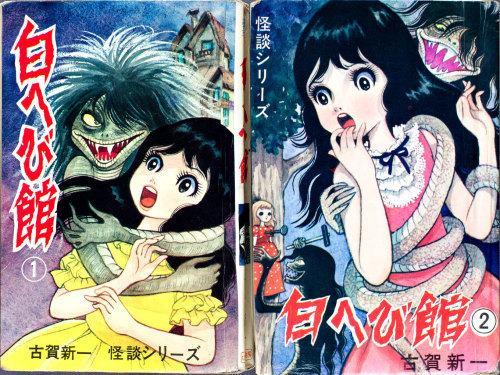
Work by Koga Shinichi
In comparison to his inspired artists, Ito’s work is more intense and although equally gory, he presents it in a more subtle and creepy manner. The art styles are also different, even though they are both manga, Ito chooses to not exaggerate his characters by giving them large exaggerated eyes and gives them a more plain appearance.
destroyraccoon/ Helena Smołka
Polish illustrator and animator, Helena Smotka is inspired by Asian urban legends which she interprets with her psychedelic cartoon character designs and short videos.
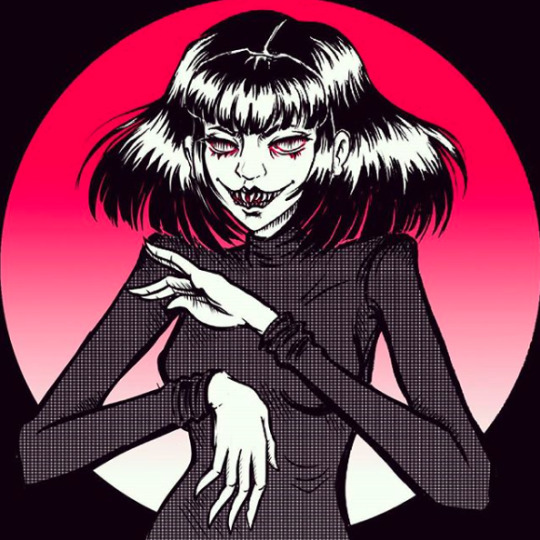
Like Junji Ito, Smotke creates an intense style of work that, although is less gruesome than Ito’s, is still heavily exaggerated to the point of scary with sharp and stretched limbs and facial expressions that are clown like and creepy.
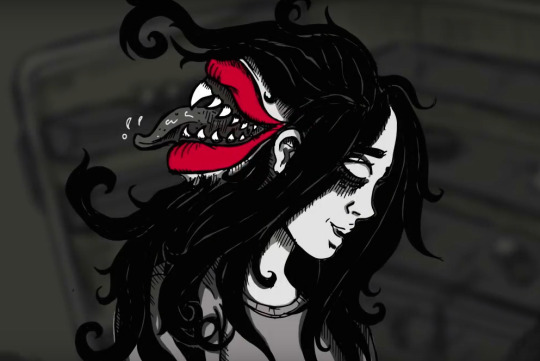
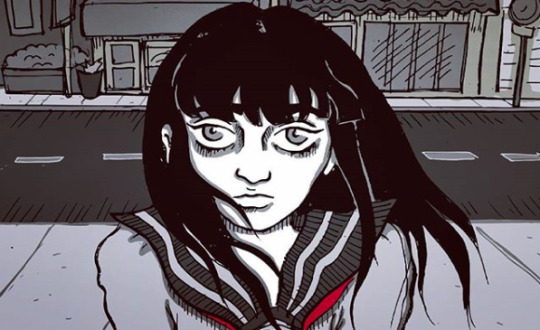
Inspired by urban legends and creatures like the two mouthed woman, Smotke creates short animations using a monochrome, black and white colour scheme with touches of red to create an uneasy and tense atmosphere. Although the touches of red don’t always symbolise a certain object of suspicion, it is used in a way that allows you to slowly become used to the red to put the viewer in a false sense of comfort before using the colour to show/ represent the monstrous creature entirely.
Mau Lencinas
Argentinian artist and illustrator, Mau Lencinas creates a mashup of traditional Japanese ghost symbology, hip-hop retro-futurism, and urban street couture to create illustrations, character designs and 2D animations. Mostly inspired by animated movie, Akira, creator Katsuhiro Otomo and the urban style of our nascent neo-modern era, Lencinas creates a series of demonic gangsters bearing kanji symbols, and crews of demon hunters adapted from Japanese traditional folklore.

Lencinas draws his characters from the idea of a dystopia Tokyo, he dresses his characters in fashionable street wear before arming them with Samurai swords and ninja weaponry, adding traditional Japanese masks to their clothing and having them battle demons from Japanese folklore. He works in bright saturated colours with little 3D dimension to add to the playful nature and the youth of the characters and works in digital software which creates a neat finish which he wouldn’t have gotten from a hand rendered process.
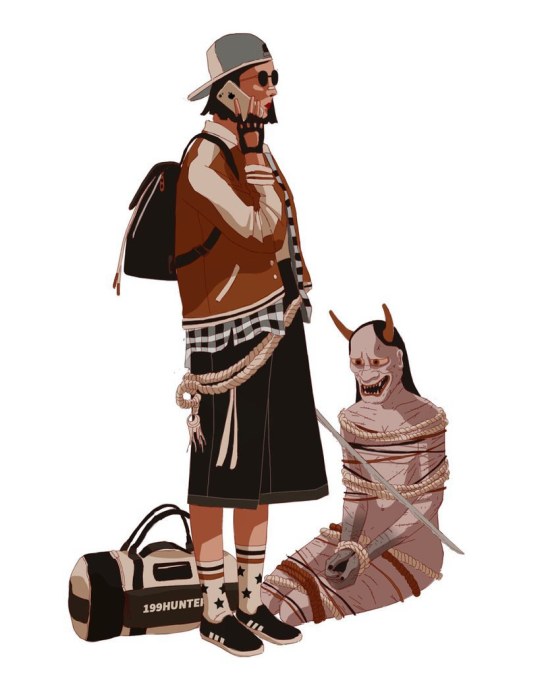

Unlike the artists I explored above, Lencinas’ work isn’t horror related but he explores the process of mixing too themes together to create unique character designs. I want to attempt to design a ghost to represent the Aokigahara forest so I will be mixing the use of nature with the traditional appearance of a Japanese ghost. Lencinas, also incorporates street fashion and traditional Japanese clothing to dress his characters, which is perhaps something I try to include by exploring Geishas and kabuki theatre.
Reflection
Pleased with the development I have made with my observational drawings, I want to continue to develop them into characters or witches, however, now that I have looked at the Aokigahara forest and yureis, I’m inspired to mix the two subjects together to create a spiritual forest being. I can use the observational sketches as a template for these designs and as I want to set them in Japan I should look into the culture such as traditional art and clothing. As I am still keen to progress on my subject of witchcraft, I will try to create my forest spirit with witch like elements or look at other female creatures that lure or cast spells.
Actions
1. Look at how witchcraft has been documented in art in history
2. Use drypoint to create more illustrative pieces
3. Look at 4D processes like stop motion and explore artists related to the process
4. Explore Japanese culture through traditional art and clothing
5. Begin to create designs for my forest spirit/ witch
6. ADDRESS AUDIENCE AND CREATE A QUESTIONNAIRE TO SEE WHAT THEY WOULD LIKE FROM MY DESIGNS
Sources
Websites
Mental Floss, 10 Horrifying Demons and Spirits from Japanese Folklore, http://mentalfloss.com/article/59737/10-horrifying-demons-and-spirits-japanese-folklore accessed on 30.4.18
Mental Floss, 15 Eerie Things About Japan's Suicide Forest, http://mentalfloss.com/article/73288/15-eerie-things-about-japans-suicide-forest accessed on 30.4.18
BBC, Why does Japan have such a high suicide rate?, http://www.bbc.co.uk/news/world-33362387 accessed on 30.4.18
Creators, Streetwear Illustrations Dive into a Dystopian World of Demon Hunters, https://creators.vice.com/en_au/article/jpvy98/japanese-streetwear-demon-hunters-gangs-drawings accessed on 30.4.18
Behance, Helena Smotka, https://www.behance.net/hsmolka accessed on 30.4.18
Youtube, destroyraccoon, https://www.youtube.com/channel/UCQvfxe-hQUarvVfhzh3tCFQ accessed on 30.4.18
BBC News, How Japan came to believe in depression, http://www.bbc.co.uk/news/magazine-36824927 accessed on 3.5.18
Youtube
VICE (2012), Suicide Forest in Japan, https://www.youtube.com/watch?v=4FDSdg09df8 accessed on 30.4.18
Super Eyepatch Wolf (2016), How Media Scares Us: The Work of Jung Ito, https://www.youtube.com/watch?v=lIIA6QDgl2M accessed on 30.4.18
Super Eyepatch Wolf (2018), The Jung Ito Collection is Disappointing Garbage, https://www.youtube.com/watch?v=DAYFi6bLSfs&t=488s accessed on 30.4.18
Refinery29 (2018), The Dark Side Of Harajuku Style You Haven't Seen Yet | Style Out There | Refinery29, https://www.youtube.com/watch?v=1Wsk3Oa_3F8 accessed on 3.5.18
0 notes
Text
“Design is Thinking, Made Visual”
The Brief and Artist Case Study:
For this workshop we will be exploring the “timeless” work of Saul Bass, an American, graphic, advertisement artist whose work hit major popularity in the 1950′s with his minimalistic and silhouetted designs. We will be questioning the affectivity of his visual language and the principles and ingredients that made it successful via observing his work and experimenting with our own.
Task 1: Read
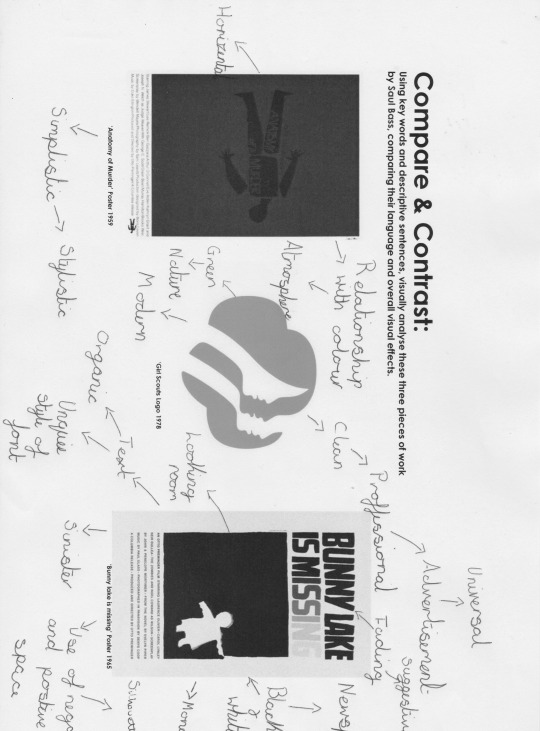
Firstly we were shown three pieces of Bass’ work, his poster for the movie “Autonomy of Murder”, the Girls Scout logo and the movie poster for “Bunny is missing”.
Can you describe the visual language of the work?
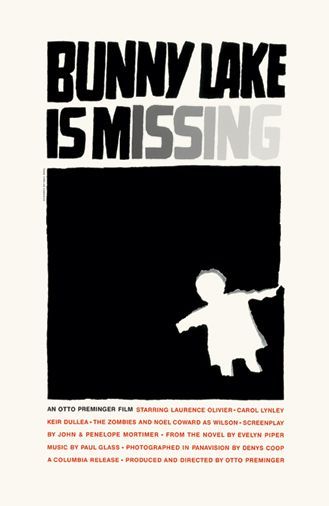
Visually the work is simplistic as Bass uses silhouettes to create compelling compositions with no features but no lack of hidden meaning. In the “Bunny is missing” poster, Bass experiments with the use of the “looking room”, which is the “amount of space between the subject and the edge of the screen they are facing”. He does this by organically tearing a sheet of black paper into the shape of a child to represent that the child has been forcibly taken from where they belong, the black paper represents this, and the disappearance of said child has left a lasting impression that cannot be fixed just like you cannot fix torn paper without there still being a tear. Also with the use of monochrome colours and the arrangement of the composition, the poster resembles a lost and found poster that you would find in the newspaper.
What is the effect of the visual language?

The forms and shapes Bass chooses to use represents the subject visually. In the case of the Girls Scouts logo, Bass has chosen to use the colour forrest green, as this relates it back to nature which is an element the Girls Scouts are involved with. The silhouette of three girls are also used, at first glance you assume they are all the same, however due to their placement in the logo you can argue that they are all different which symbolises how they are open to all girls who are all treated the same way.
Does the work send an immediate message or are there subtle parts that take awhile to digest?
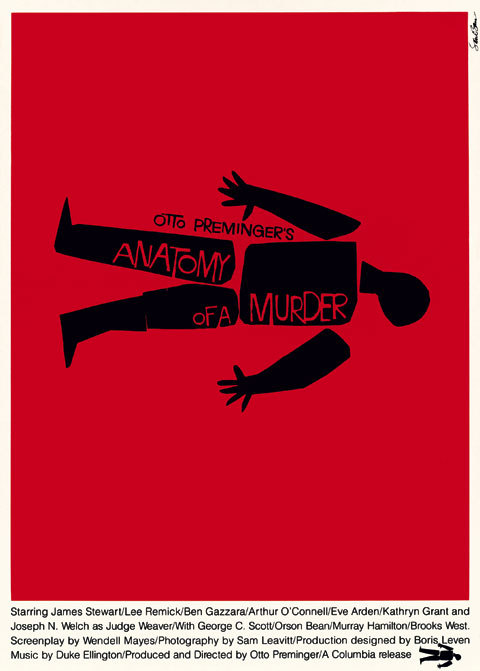
Although his posters are easy to interpret at first glance, you do miss hidden details and messages if you only looked for a second. In the poster for “Anatomy of a murder”, you see what we interpret as a body due to the title and the fact the body is lying horizontally. The background is red which is connected to the appearance of blood and the body has been cut into pieces to show that it is being taken apart to look at the anatomy of the limbs, head and torso. When I first looked at the poster I hadn’t noticed that the body was cut into sections or that Bass had organically cut out the body from black paper himself which conjures up theories that perhaps this is rather a study of a body rather than a murder scene.
Why do you think the work could be described as timeless?
Silhouettes are a very popular way of designing posters and logo’s as it doesn’t give away much information, is simple and visually easy to understanding leaves it up to the viewers interpretation. Because the shapes and structures Bass uses for these silhouettes are universal due to their lack of identity, this means that they aren’t related to and can be associated with any time period.
In Bass’ film title sequences, they are also done in a 2D format with silhouettes and the movement is in sync with the sequence music.
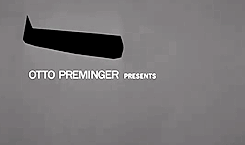
In the Atonomy of Murder movie sequence, the use of 2D stop motion moves around the organically and hand rendered limbs (which makes it appear more sinister) of the body in time with the music to create more definition and emphasis. It also cuts away sections of the body to create the illusion that something is dissecting the body and really inspecting it which gives the viewer an indication that the genre might be mystery.
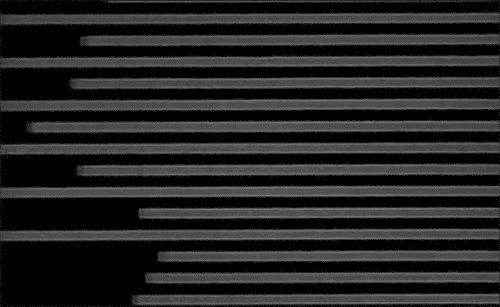
The title sequence for the movie Psycho is much sharp and sleeker than Anatomy of a murder due to its use of geometric shapes to subtract and slash areas of the screen and the composition. Instead of creating a maddening and chaotic sequence, Bass has decided to present the title Psycho as a more intelligent and calculating being but the constant slicing of the screen indicates the sinister undertone and the slipping of ones sanity.
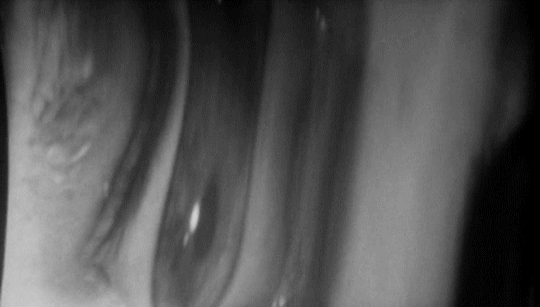
Bass takes a different approach to the title sequence, Seconds, with the use of real black and white, 4D imagery that is distorted until it slowly transforms into a recognisable feature. He plays around with the scale and structure of the imagery to create unnerving and hypnotic sequences that are abstract and looks similar to when you manipulate an image using liquify on Photoshop.
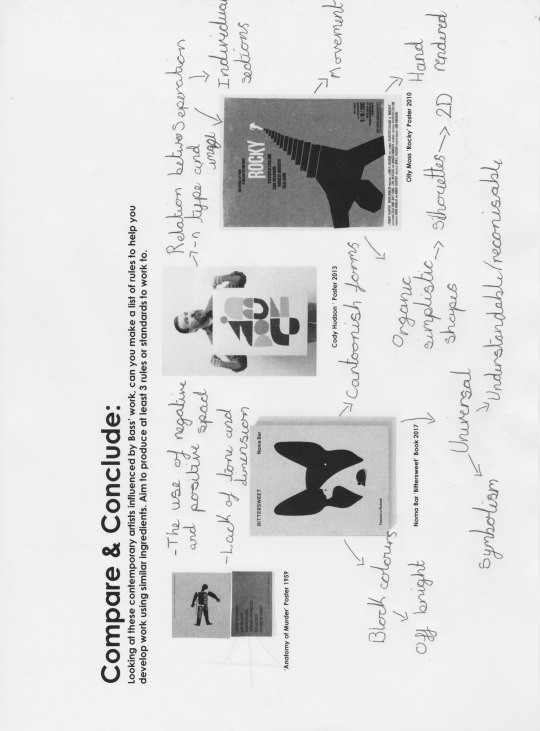
We then looked at other artists who were also inspired by Bass’ work and began to note the key elements in his work.
1. Simple and universal silhouettes
2. Use of block colours (slightly off bright) to use as a “looking window”
3. The relationship between text and image
4. Using organic shapes, often hand rendered, to create exaggerated forms
5. The use of positive and negative space
Experiments:
After we noted down the key elements for Bass’ work, we then applied them to our own to create a variety of different outcomes using both hand rendered and digital processes. I decided to use one of my tree panels from my comic as a base for these experiments as they’re silhouettes and could easily be transformed into Bass’ work.
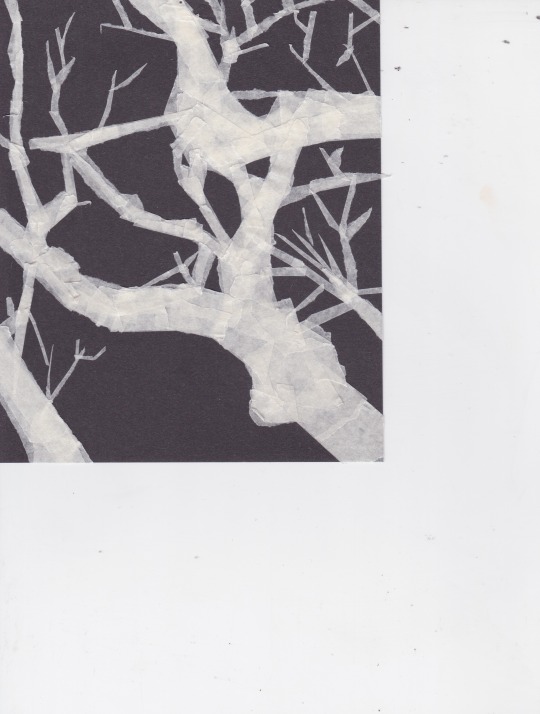
My first experiment was created via tiny strips of ripped up masking tape that created the texture of tree bark and also created a bold silhouette against the black paper. Although not identical to Bass’ way of working, I have still ensured to explore the use of positive and negative space.

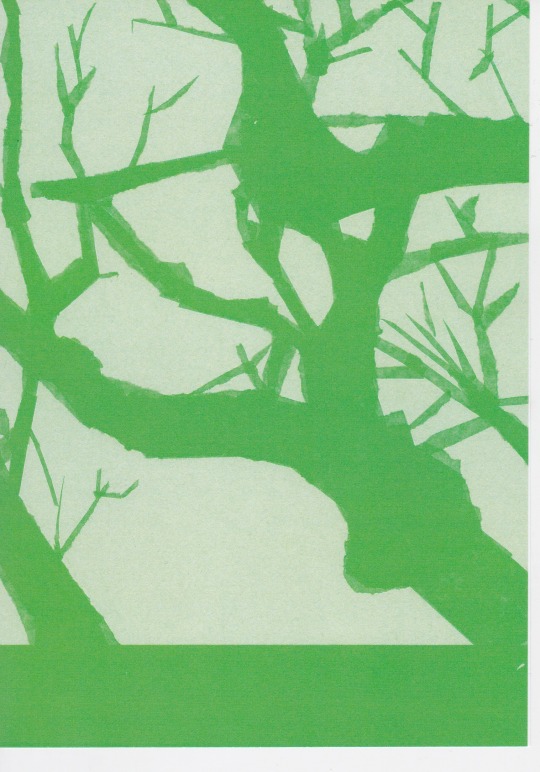
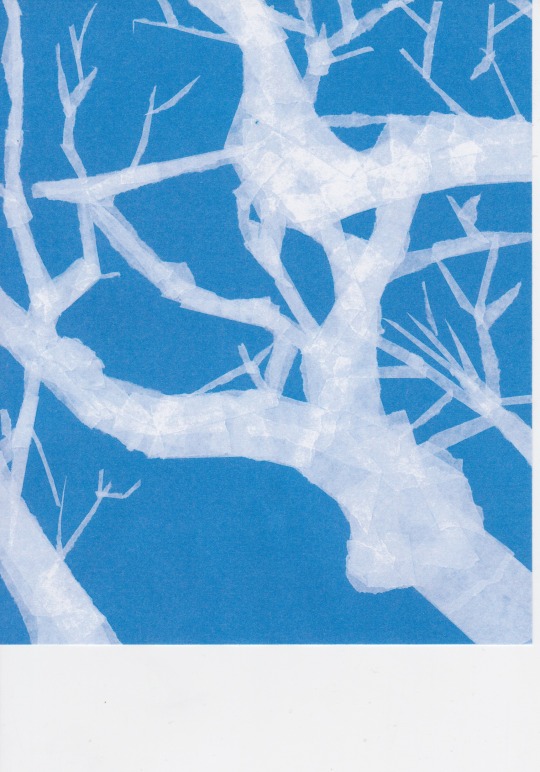

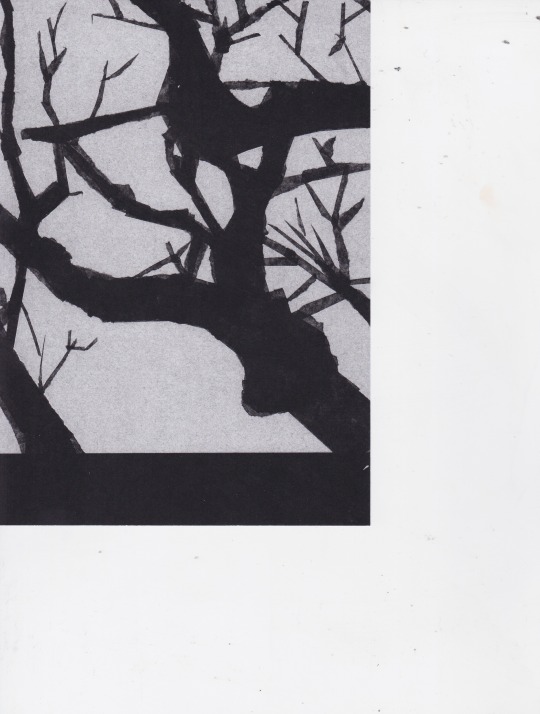
Taking my first experiment I then explored printing methods on the printer such as changing the colour, reversing the colour scheme positively and negatively, and moving the image around to create movement. I was pleased with the outcomes as I was able to create a variety of atmospheres using different printer settings and processes. The printer also kept the texture of the masking tape so it still kept the hand rendered quality.
Whilst creating these tree silhouettes I got the idea to try creating silhouettes with bleach as I remembered that when applied to black sugar paper, it should change colour.
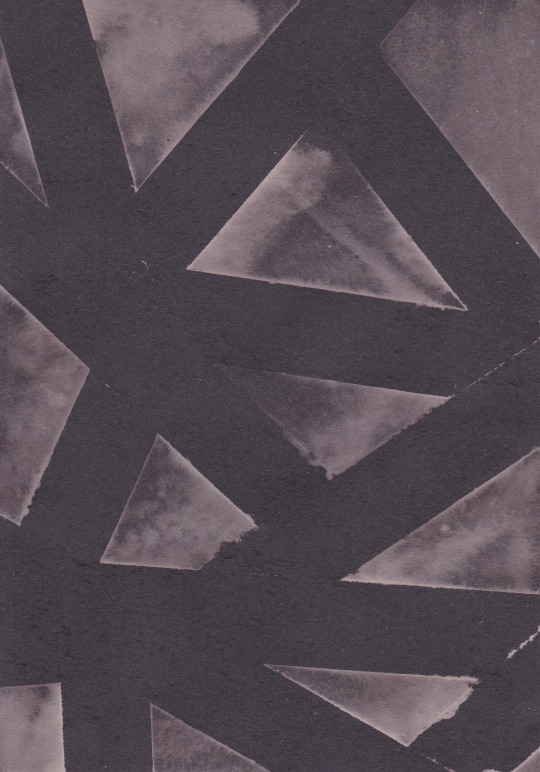
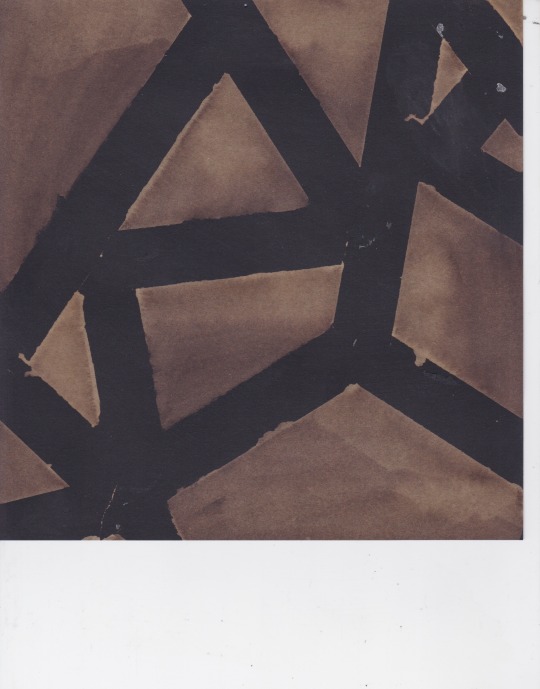
Taking the masking tape again I taped it across the black paper in various shapes and then washed the whole page with the bleach before removing the tape which left outlines of the original paper.
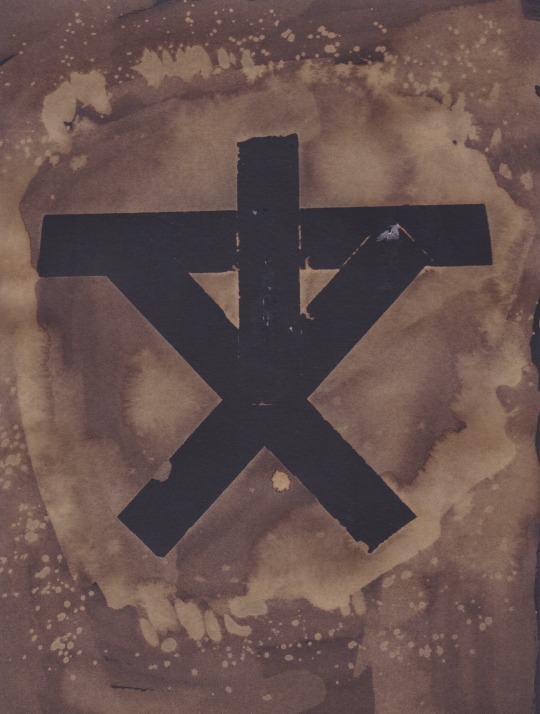
I used this process to create the symbol from the Blair Witch Project. The black contrasts well with the earthy yellow colour of the bleach and I also decided to add aspects of bleach on the already dried bleach sections which created a watery/ smokey texture and gave a magical atmosphere. After trying this chemical process, it left me to wonder what effect it would have on fabric and whether this could be a material to later experiment with.
Reflection:
Although I followed the elements of Bass’ work in the silhouette aspect, I chose to approach this workshop with an open mind and I decided I wanted to develop Bass’ work in my own way as I felt I would be too limited with just making silhouettes from paper. This way of thinking allowed me to look into using processes and materials that I hadn’t yet thought about using and has inspired me to develop them further on in the future of this project.
Something that did strike me whilst creating the piece based on the Blair Witch symbol was the use of dolls in witchcraft and voodoo and as I have been wanting to explore 3D stop motion, I should explore the use of dolls in witchcraft, like voodoo dolls. I also want to explore stop motion artists to influence me when experimenting with this process.
Actions:
1. Look into 3D stop motion
2. Research the use of dolls in witchcraft and use it to influence my ideas of using stop motion
3. Explore the effect of bleach on different materials
Sources:
Websites
99designs, Saul Bass: The man who changed graphic design, https://99designs.co.uk/blog/famous-design/saul-bass-graphic-designer-of-a-century/ accessed on the 27.4.18
Art of the Title, Saul Bass, http://www.artofthetitle.com/designer/saul-bass/ accessed on the 27.4.18
0 notes
Text
“Simple Folk”
The Brief;
in this workshop we were tasked to use the digital software, Illustrator, to create simplistic and geometric avatars (an icon to represent a person) inspired by the styles and personalities of children’s illustrations.
Research:
Before we begun the workshop, practically, we looked at several artists that work in similar styles to allow us to define a set of principles to follow when designing our own avatar.
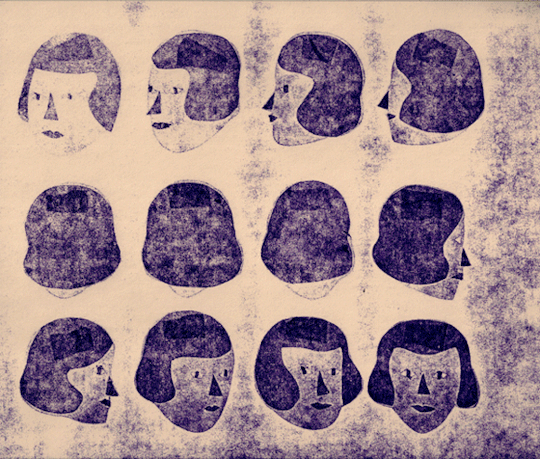
Lilli Carre; an American artist working primarily in experimental animation, video, comics, sculpture, and drawing, which have been presented to the public via a variety of film festivals. Working with a variety of 4D processes, but mostly hand drawn animation, she creates work with a hand rendered quality to them keeping the textures and marks made by her drawing materials to add more movement and give a homely effect the work. Visually her work is soft in appearance with no threatening imagery and a childlike innocence to her concepts. That being said, there is also a maturity and timeless charm to her designs as they are not exaggerated cartoons, but minimalistic and the style can be used to represent any time in a respectful manner, which gives them a humble nature.
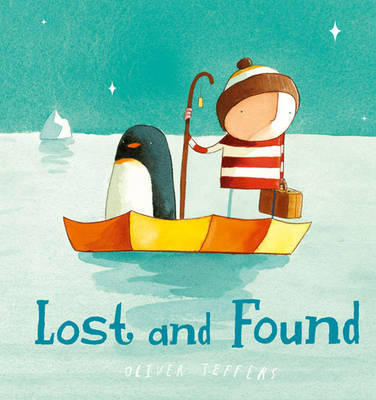
Oliver Jeffers; Irish and NY based illustrator, Jeffers creates simplistic and educational children’s illustrations in similar nature to Carre. He also uses hand rendered processes like watercolour and leaves the texture visible for the viewer and uses colours in a child friendly and intriguing way (they are bold colours yet slightly off bright).
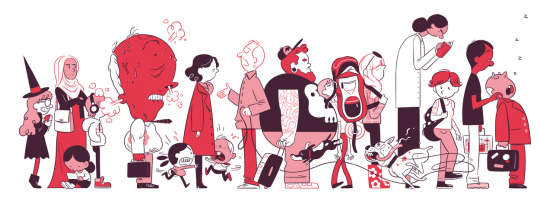
Luke Pearson; UK comic and illustrator, Pearson uses the simplistic styles similar to Jeffers and Carre but in a more dark, comical and exaggerated way as his work is aimed for teenagers and young adults. “My ideas sometimes come from an urge to capture a warmness or a pleasant feeling, while some of my more downbeat or miserable ideas come from intensely scrutinising my own navel and trying to expand on the observations.” Taking inspiration from old cartoons and the world around him, Pearson creates more relatable work in a less humble manner to our previous artists. He also uses a more rustic colour scheme making his work appear tonal and contrasting.
Eleni Kalorkoti
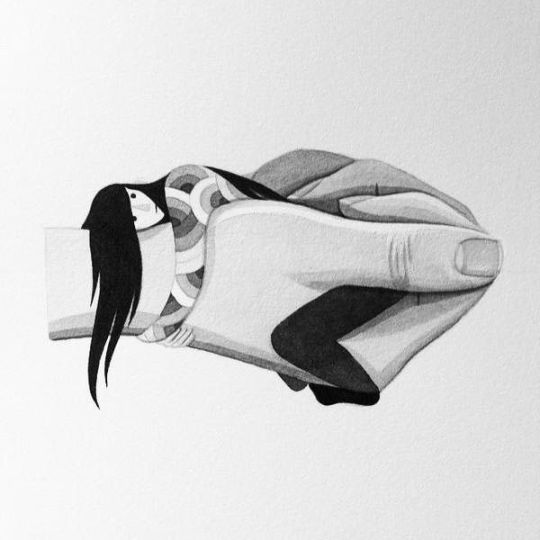
Out of all the artists we were asked to research, I was most intrigued by the work of Scottish illustrator, Eleni Kalorkoti. In comparison to the above artists work, I found hers had the shyest nature and there was a relatable, surreal, invisibility that was compelling to view. Her work is very dreamlike and you get a sense of independence from her characters, as though the work they are staring in are them showing you an insight into their minds.
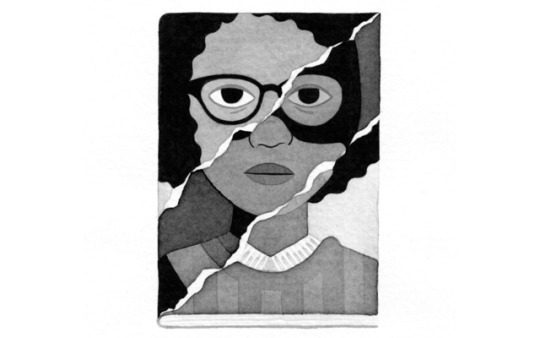
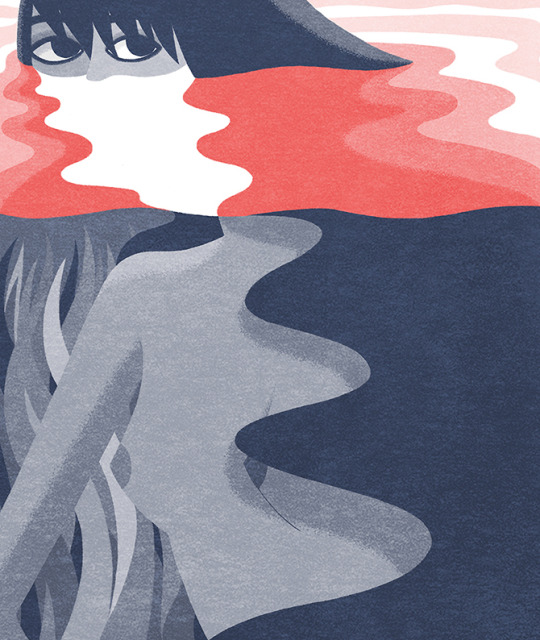
An interesting factor in her work is the use of pattern and movement. She captures a water-like fluidity that distorts her work and creates organic, clean edged shapes similar to the art deco movement, which leaves the viewer to ask questions on what message she is trying to convey. By using watercolour and ink in a monochrome and tonal way, she creates a meditational atmosphere that’s silent and relaxing which contrasts well with her characters who have neutral yet non-threatening facial expressions.

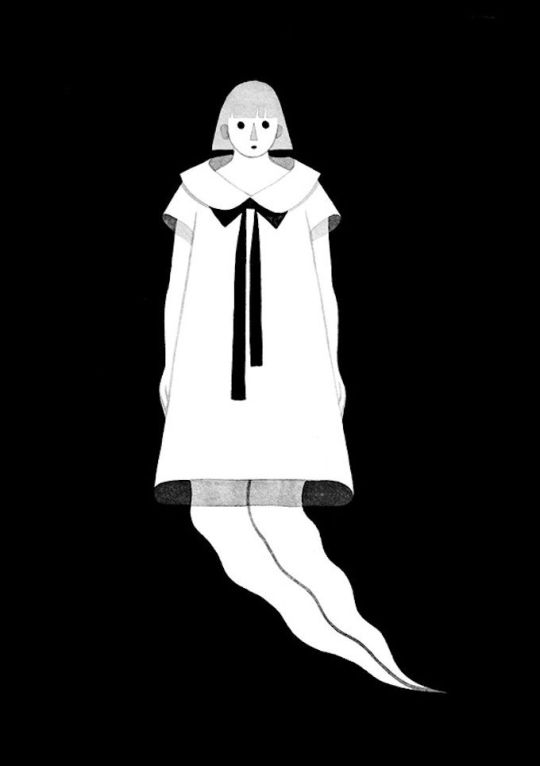
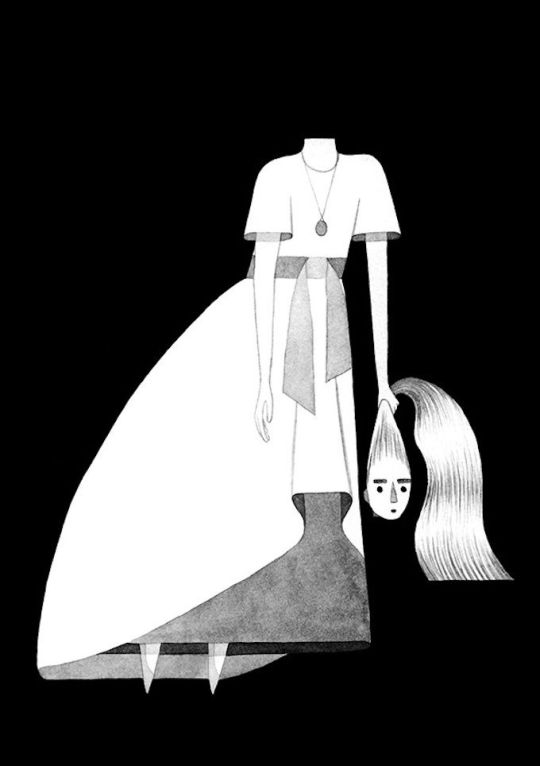

The work that stood out to me most, from Kalorkoti, was her 12 page, halloween inspired, “Ghost” zines which presents 12 individually designed ghoulish ladies clad either in historically period dress or cloaked statically in long hair. Each page has a blank, dark, solid background which contrasts with the flowing shapes of the ladies, making them appear to be floating. Along with the monochrome colour schemes, which make the figures appear pale, the exaggerated curves and simplistic shapes add to a ghostly nature, yet they still appear humble, innocent and even doll-like in design due to their minimalistic style in shapes and structure.
What are the key elements in these artists styles?
In comparison to the above researched artists, I found Kalorkoti’s work the most influential due to it relating back to my main theme of the supernatural. However, looking at all four artists, they all follow key principles in their style of work; such as using simplified shapes to create a form, the dotted eyes, the bright yet child friendly colour schemes, the hand rendered qualities and the gentle nature of the characters. These are the key elements to work from when designing my avatar as this will show their influence on my design.
Process:
Using Adobe Illustrator, we created a simplified avatar of ourselves in our own image using the researched artists style as a key element and various tools on the digital software.
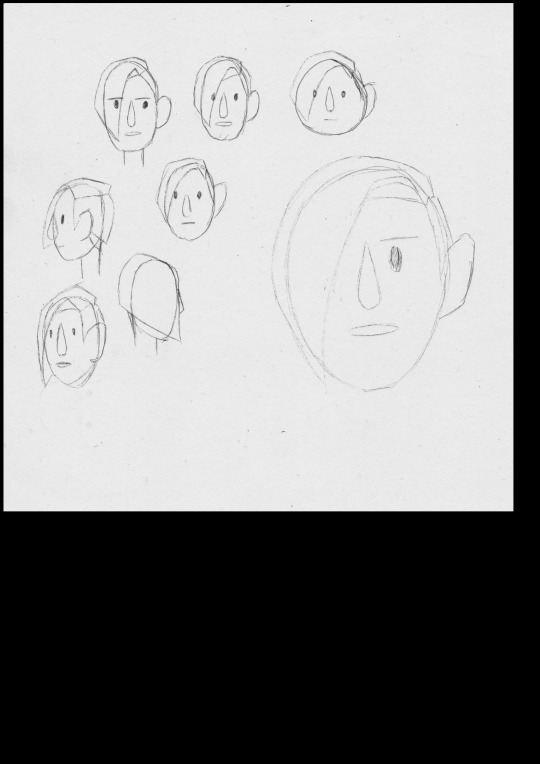
Firstly we drew a basic idea of how we wanted our avatars to look and began to experiment with different design features (like whether to include eyebrows, what face shape to use, the structure of the nose etc.) to see each pathway we could take for this design.
Once I was happy with my design I took to Illustrator to create a graphic interpretation. The reason we used a digital tool and not hand rendered was so that it could be easily altered and edited without any loss of resolution or quality. Our hand rendered designs might be unachievable or not easily created on digital software so changes would have to be made or details would be added so that the composition was balanced.
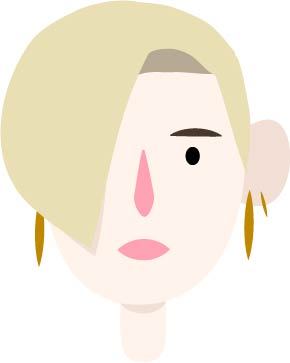
What could be improved?
Above is my avatar, in colour, and although I am satisfied with my design, I am disappointed that I didn’t get to experiment further with the design and colour , as I struggled to use the tools in Illustrator. Although I have captured a likeness of myself, I wish I had attempted to create something more abstract with the use of flowing shapes like Kalorkoti’s Ghost zine’s to relate back to my subject.
Reflection
In conclusion, although I didn’t explore this workshop to it’s full potential now, I can use this in the future to perhaps create simplified versions of concept art if I only want to focus on structure and form rather than detailed features. Comparing my work to the researched artists you can see that there is a difference in atmosphere caused by the use of different processes and materials. The hand rendered illustrations look more soft in comparison to my digital rendered design as there is no texture which makes it look too processed and clean. I will continue to explore Kalorkoti’s work as it has inspired me in ways to represent supernatural creatures.
Actions
1. Use Kalorkoti’s Ghost zine work to influence my witch designs or any other potential ghoul designs I choose to explore.
2. Attempt to create more work in this style but with hand rendered processes like ink and watercolour to compare the difference between the digital process.
3. As I had difficulty using Illustrator, I should again explore different processes I can use via it.
Sources
Websites
LILLI CARRE- ABOUT/ CONTACT, http://lillicarre.com/contact accessed on the 26.4.18
Cartoon Brew- Artist of the Day: Lilli Carre, https://www.cartoonbrew.com/promote-article/lilli-carre-88953.html accessed on 26.4.18
The Guardian-Oliver Jeffers: 'I was always an artist' – but not a child of books, https://www.theguardian.com/books/2016/sep/29/oliver-jeffers-interview-illustrator-a-child-of-books accessed on 26.4.18
NoBrow Press- Luke Pearson, http://nobrow.net/creator/luke-pearson/ accessed on 26.4.18
It’s Nice That- London-based illustrator Eleni Kalorkoti paints understated charm with ink and watercolour https://www.itsnicethat.com/articles/eleni-kalorkoti-illustration-091116 accessed on 26.4.18
Brown Paper Bag- Bold Portraits of Ghostly Ladies Haunt the Pages of Eleni Kalorkoti’s Zine https://www.brwnpaperbag.com/2016/09/21/eleni-kalorkoti-ghost/ accessed on 26.4.18
0 notes
Text
Hylophobia
In response to the drawings I created in my comic book from observations of trees, I have decided to explore “Hylophobia”, the phobia of forests and wooded areas, as this would relate to my themes of superstition and the paranormal.

Where does the fear of forests stem from?
The fear of forests has cultural roots as our ancestors would move out of forests due to the fear of wild animals at night or unknown dangers. If you observe the image above you can see how condensed it is, you can’t see how far it goes which works in the same but opposite way as claustrophobia, its repetitive as all you can see is trees and theres limited light as the branches prevent it.
Fairytales and folklores were also wrote depicting wooded areas as homes to witches and savage creatures like Hansel and Gretal and Little Red Riding Hood so children wouldn’t venture out into the woods alone at night. African and Asian cultures also tell tales of creatures that live in woods and forests.
Woods were also homes of people who were diseased as they would be vanished from their villages and made to live in woods far from human civilisation. People were also often left in forests to die if they were too ill or old and were a strain on families as a way to exterminate problems.
What connections do Forests have with Witchcraft?
What is Witchcraft?

Witchcraft is a negative term used to describe the belief and practice of magic which differs depending on the place and culture. Unlike sorcerers and wizards, who have to use wands to cast spells, witches are able to cast spells without as their magic comes from the inside. Because of this, witches were blamed for many social and natural events like disease and were made social outcasts. Minorities that did not conform to majority religions or social agendas of that time were accused of witchcraft which led to witch trials, often concluding in death.
When Christianity became the prevailing religion in Europe, many of the ancient "pagan" religions still survived, and these included magical practices like using herbs from folklores as healing remedies. The Christian church was convinced that these beliefs were associated with the devil and began unfair and torturous witch trials that ended in hundreds of executions As evidenced by the Salem witch trials the charges were usually false and the evidence faked and caused by mass hysteria.The targets of these attacks were usually old women who were unmarried or widowed, and lived alone with small animals for pets. Sometimes they were condemned because they owned land that others wanted, or because they used plants and folklore traditions for healing remedies, or because they were poor and made easy targets.
Where does the stereotype of the witches living in forests come from?
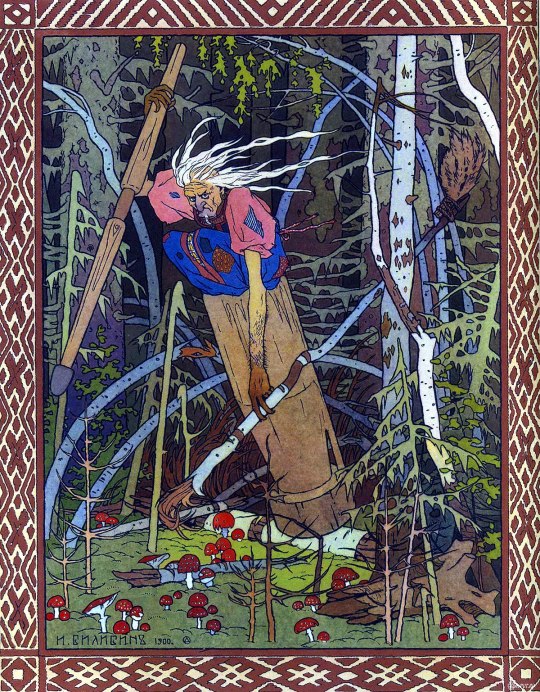
Baba Yaga, a witch from Russian Slavic Folklore who lives in a house in the woods (said house is stood on two large chicken legs) and travels around in a large mortar and pestle. She isn’t a villainess character in Slavic stories to characters of pure heart.Illustration by Ivan Bilibin
When researching this question I found that there should be no connection what so ever as most accused witches lived in cottages or homes in thriving communities like Biddy Earley who was an accused witch who lived in a cottage in Ireland or Rose Hall in Jamaica home of Annie Palmer a supposed witch. Whilst reading the Crucible, a play written by Arthur Miller in the 1950′s in response to USA McCarthyism communist accusations and related the issue to the events of the Salem Witch Trials in 16th century Massachusetts, it spoke briefly about how they viewed the forest as the home of the Devil and his worshippers due to Native Americans that refused to be reverted to Christianity so chose to live there away from civilisation which could explain why fairytales and horror films depict witches to live in forests.
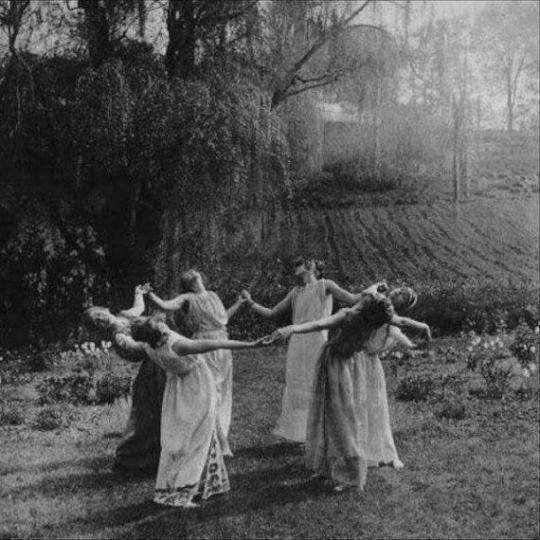
The closet answer I could get came from researching the pagan religion Wicca, a religion originating from Wales, Scotland and Ireland which has witchcraft and magical elements. The religion worships and has a great appreciation for nature and Gods like the Divine and practices magic. Although not an evil religion, witchcraft is a term they use to describe they're rituals and practices and they take pride in being witches, however, unlike the evil witches associated with the devil, Wiccans view witchcraft as a spiritual connection to nature and living beings and rely on nature to heal and purify.
Wiccans today usually live in the countryside to be close to nature as this is where covens often have meetings as its close to nature so perhaps this is where the association with forests and witches comes from as there was a belief that the only people that would travel into forests alone were people with immortality and supernatural abilities.
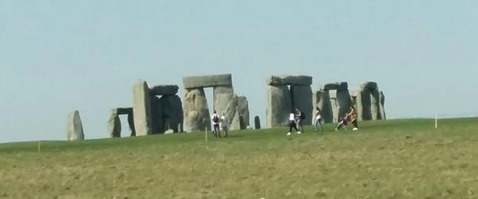
Photo (2018) taken of Stonehenge
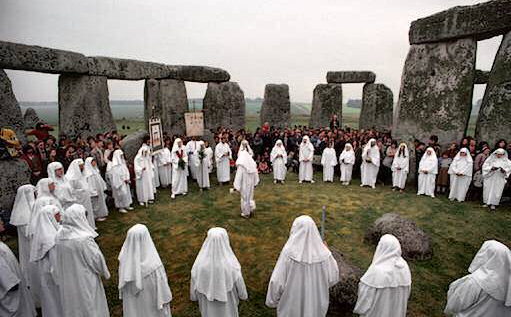
Druids gathered at Stonehenge for the Winter Solstice
Druids are similar to Wiccans in terms of beliefs and practices but they worship and attract differently. Druids attract more men, Wiccan’s attract more women, Druids wear white, wiccans wear black (or nothing at all), druids are considered more priest like, wiccans are more like shamans and finally Druids originated from Celts and Wiccan's originated from Anglo Saxons. It’s similar to Catholic and Christianity as they celebrate the same religion and ceremonies but they differ in ways. Though they both still celebrate the Winter Solstice at Stonehenge on the shortest day of the year, 21st of December, and Stonehenge is the place for this celebration as it frames the sun as it sets.
Witches in popular culture
Fairytales:
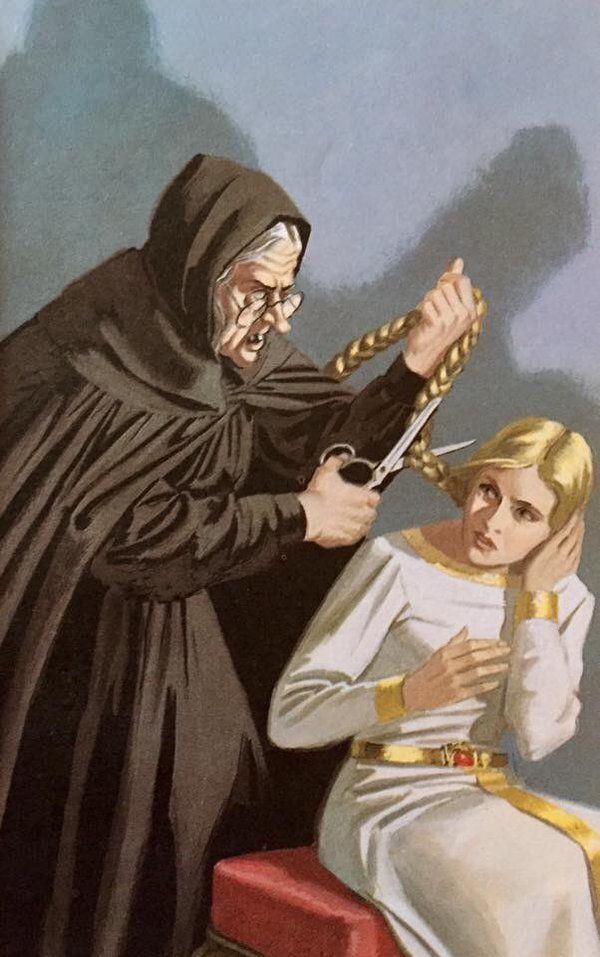
Illustration from the Ladybird Book Rapunzel
The most famous fairytales and folklores were written and collected by German academics, philologists, cultural researchers, lexicographers and authors Jacob and Wilhelm Grimm in the 18th century. With the popularity of Romanticism (romantic and emotional literature and music) rising, the brothers dedicated themselves to recording and collecting folklores from around Germany. A reoccurring theme in these stories were warnings towards children such as Hansel and Gretal and Red Riding Hood as well as a large amount of violence like in Snow White and Cinderella. The Witch was a usual villain, often depicted as an grotesque old woman with a broomstick and pointy hat, which was in fact dress code in those days and has evolved into the stereotypical witch hat.
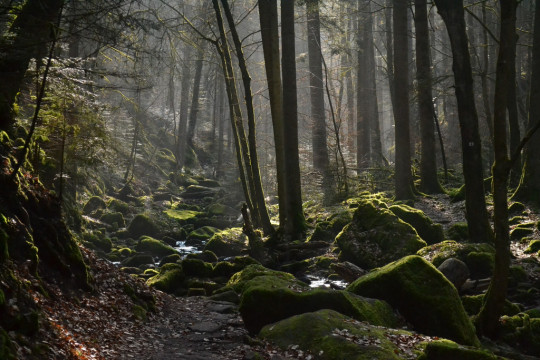
Black Forest in Germany
German culture is also deeply rooted in forests, as it is culturally the landscape. People lived in forests and thrived in it by hunting and manufacturing and German forests became a popular setting for fairytales, writing and poetry. The Germans preferred rural landscapes in oppose to urban civilisations, and Hitler was even quoted "We have become used to seeing the German nation as eternal. There is no better symbol for us than the forest, which has and always will be eternal. The eternal forest and an eternal nation -- they belong together,”. They were fascinated with Nordic and Scandinavian Gods, and the Swastika is supposed to resemble lightening from the God Thor. Even with this strong love for nature, Christianity still took over and Germany became Europes Witch trial capital of the world and witches became a reoccurring role in fairytales.
Films:

Scene from Pixar movie Brave
Over the years the role of witches has changed, in the 2012 Disney Pixar movie Brave, the role of the witch has greatly changed from the witch in the 1937 Snow White Disney adaption from the Grimms fairytale. In Brave, the witch is still a stereotypical old woman but instead of being an evil sorcerer she is used as a comic relief. Although this still isn’t an accurate representation of real witches, it improves the image of the fictional stereotype quite drastically.
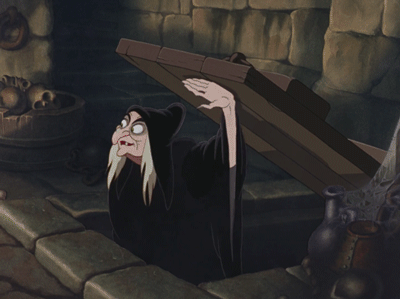
Witch from Disney’s Snow White
However, some horror movies do still depict witches in a negative light for artistic purposes. In the 1999 movie the Blair Witch Project directed and written by Daniel Myrick and Eduardo Sanchez, tells the fictional documentary about a group of students who travel into a forrest supposable the home of the legendary Blair Witch. They become hexed by the forest, with the days growing shorter and nights growing longer and are unable to find their way out of the forest. This movie combined hylophobia with the folklores and fears of witches and is still considered a classic horror movie today.
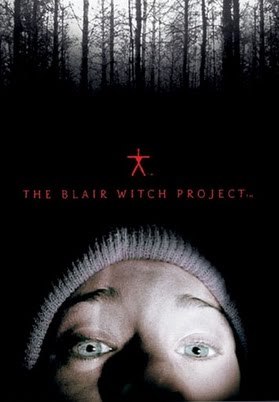
Movie poster for the 1999 film The Blair Witch Project
Another horror movie depicting witches was the 2016 film The VVitch by Robert Eggers. In this film Eggers shows a 16th century New England family starting their isolated life in an area completely surrounded by a forrest inhabited by a coven of witches (or some viewers would interpret). An interesting addition to this film is the inclusion and symbolism of animals. A black goat on their farm named Black Philip is used to represent the Devil in juxtaposition to the sheep which are used to represent God and his followers, the blood thirsty Raven that symbolises death and the hare, which is viewed in a negative light due to Christianity as the hare used to represent Goddess’s and female superiority wasn’t allowed so it was changed to the myth that witches can transform themselves into them. Eggar’s based his films witch on folklores he had heard as a child in New England and stereotypes of witches from that century being child murderous, sinister, spell casting, devil worshippers.
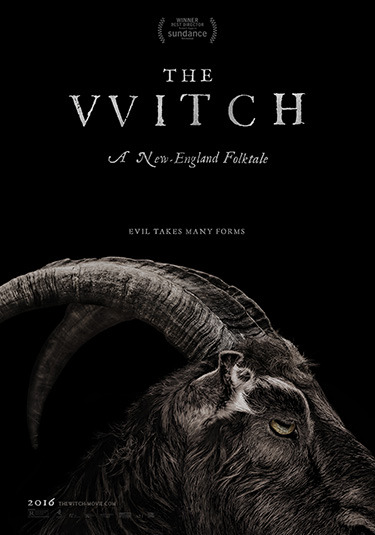
Movie poster for the film The VVitch
Going back to my Topic of Hylophobia:
The tree observational studies I created for my comic panel were similar to ones I had seen English Illustrator and Designer Jamie Hewlett draw for a series of observational drawings of Pine trees. He created the simplistic monochrome pieces in ink with marker and fineliner pens by just sitting for hours drawing trees and woodland nature.

Hewlett uses thicker marker pens in comparison to my biro which allowed him to add larger tonal values to his work and he also added patterns to represent the bark and shapes of the tree. I would like to revisit drawing trees as I think this could allow me to create “tree characters” like the Ent’s for Tolkien’s novels Lord of the Rings and Grandmother Willow from Disney’s 1995 adaption of Pocahuntas.
Actions:
1. Explore alleged forests with a supernatural connection the cultures, history and myths surrounding them.
2. Look at other area’s with a supernatural connection to them and the cultures and myths around them.
3. Draw my own interpretation of a witch using historical and cultural references.
4. Use observational drawings I do of trees and wooded areas and create “tree characters” from them.
5. Read and review the play The Crucible and create concept art from it.
Sources:
Books
Calum D and Campbell J, 2005, The Complete Grim’s Fairy Tales, United States
Roland P, 2010, THE NAZIS AND THE OCCULT, London
TASCHEN, 2017, Jamie Hewlett, London
Websites:
FearOf, Fear of Forests at Night Phobia – Nyctohylophobia, https://www.fearof.net/fear-of-forests-at-night-phobia-nyctohylophobia/ accessed on the 22.4.18
Quartz, Germany was once the witch-burning capital of the world. Here’s why, https://qz.com/1183992/why-europe-was-overrun-by-witch-hunts-in-early-modern-history/ accessed on the 22.4.18
Study.com, What is Witchcraft?, https://study.com/academy/lesson/what-is-witchcraft-definition-history-types.html accessed on the 22.4.18
familyeducation,What is Witchcraft?, https://www.familyeducation.com/life/wicca-witchcraft/what-witchcraft accessed on the 22.4.18
Exemplore, Real Historical Witches' Houses and Cottages, https://exemplore.com/wicca-witchcraft/Real-Historical-Witches-Houses-and-Cottages accessed on the 22.4.18
The Celtic Connection, What is Wicca?, https://wicca.com/celtic/wicca/wicca.htm accessed on the 22.4.18
DW, Love for Forests Deeply Rooted in German Psyche, http://www.dw.com/en/love-for-the-forests-deeply-rooted-in-german-psyche/a-3970648 accessed on the 22.4.18
0 notes